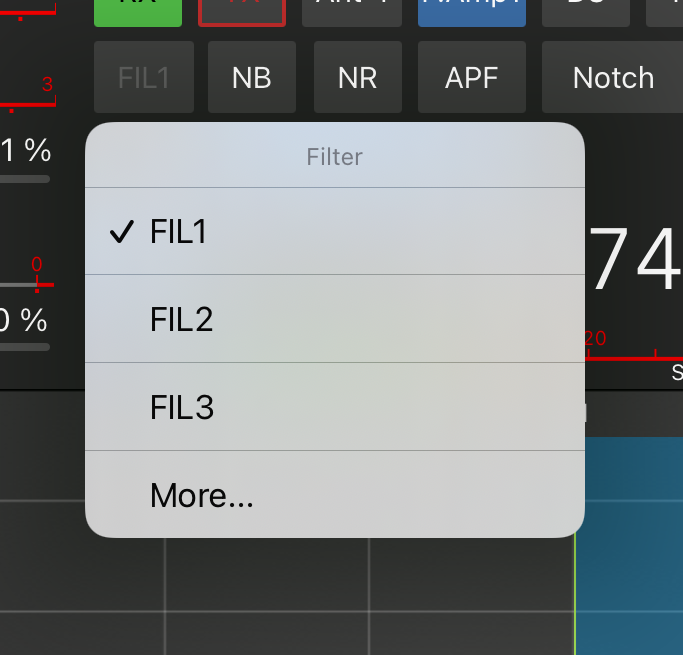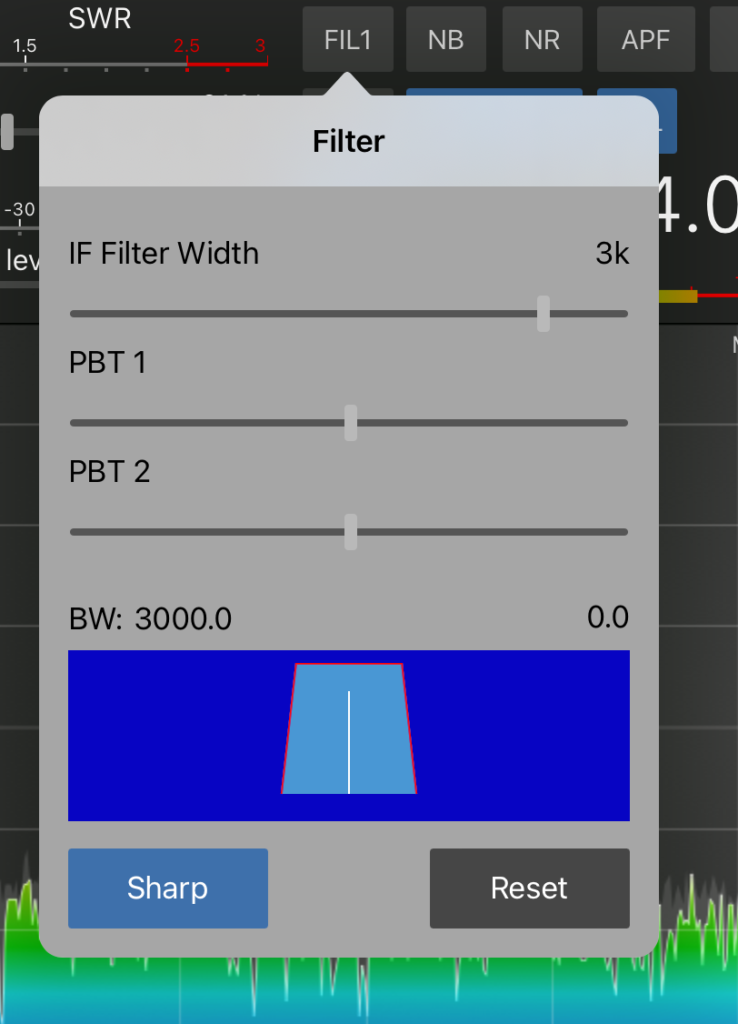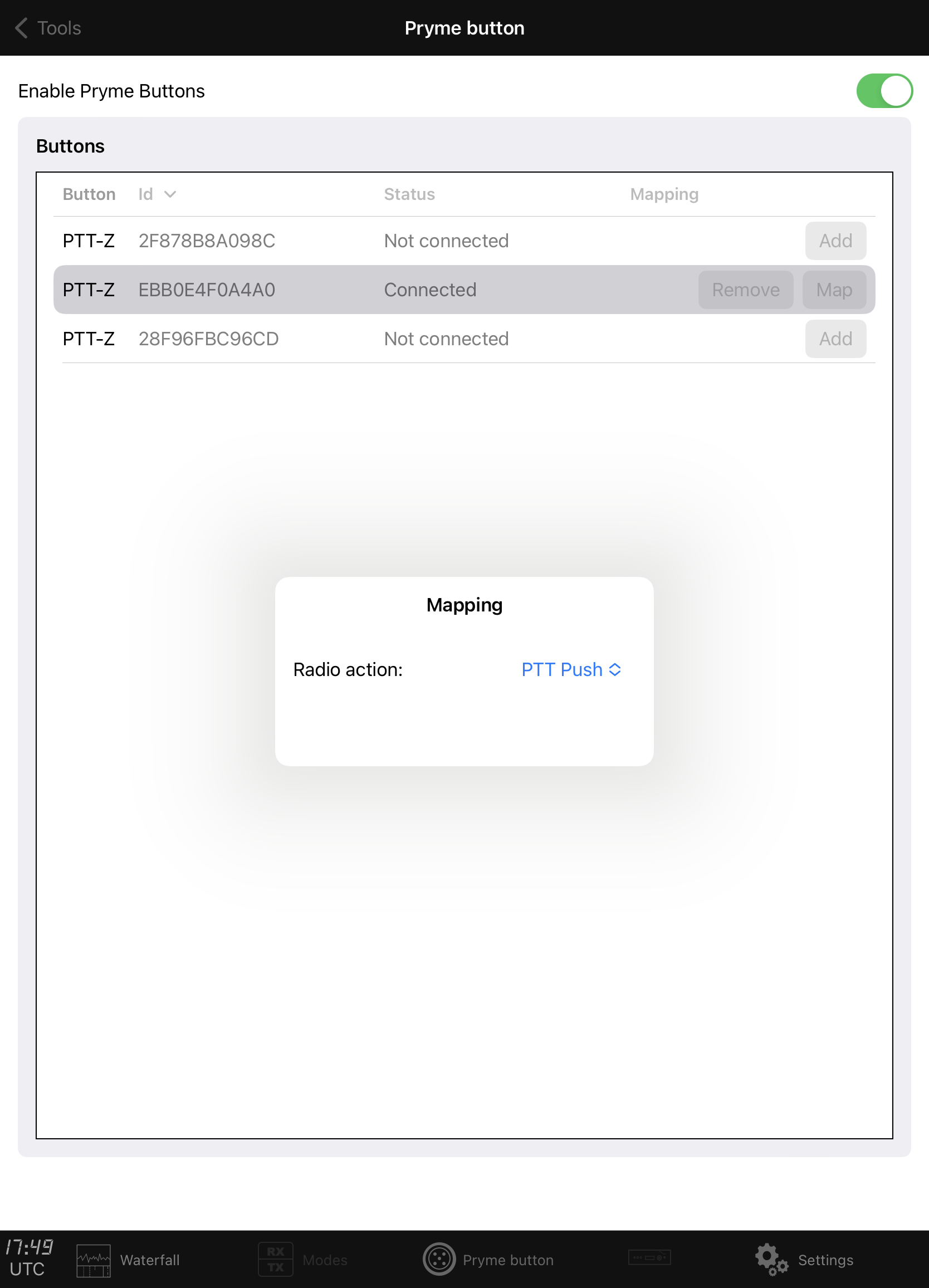SDR-Control for iPad - Software user guide
1. About the App
SDR-Control for iPad is an iOS app designed specifically for your iPad, enabling you to operate your Icom radio over a network connection.
1.1. Operate in any Mode
You have the capability to operate in SSB mode utilizing the iPad’s built-in microphone, or you can opt for a headset, such as Apple’s AirPods or another Bluetooth-enabled headset. Additionally, for CW operation, the app includes an integrated Keyer and CW decoder for your convenience. Moreover, the app features an integrated FT8 Mode Tool, enabling you to operate in FT8/FT4 modes directly from your iPad. This means you can enjoy these modes without the need for a Mac or PC.
1.2. Local or Remote
Besides the possibility to connect to your Radio via WiFi at home, where your Radio is located, SDR-Control also supports Remote Access to your Radio from around the world without the need for additional Hardware or Software. No Server is needed. It works, just with your Icom Radio. The only requirement is a Icom Radio that offers a network interface like the IC-705, IC-9700, IC-7610, IC-7760 or IC-R8600.
Note
The App displays and can send back most values and settings to and from the Icom Radio. Some values (like the VFO Frequency and Waterfall) are exchanged real-time. Others needs to be polled from the Radio in regular intervals. For this reason, if you would use the physical controls of the Radio (except for the main frequency dial), changes are not or not immediately available to the App. Ideally, solely use the controls from inside this App.
1.3. Troubleshooting
In case of problems, please first have a look to the Common Issues section of the manual. If you can’t find any help there, please use the App included Contact Developer feature to contact me and I will be happy to help.f
2. The manual
This manual explains how to setup your Icom Radio and the App and how to work with the App. Where possible and where it makes sense, the App uses the same abbreviations and terms for buttons and menus that are used by Icom for physical knobs and Buttons on the Touch screen. Those terms such as “P.Amp” (for Pre Amplifier) will not be explained in this manual because they can be looked up in the regular Icom manual.
This manual can be opened from inside the App or directly following this link: https://go-to.me/sdrcontrol-ios-manual .
If you prefer a printed version, just tap here. This can also be used to save a PDF file of the Manual.
But please keep in mind, that this manual will be updated from time to time.
2.1. Videos
In addition to the manual and for those who don’t like to read manuals, there are also a few videos from popular HAM Radio bloggers in English and German at the bottom of the App’s website: ham-radio-apps.com
3. Requirements
SDR Control for Icom can be used for the following Icom Radios:
IC-705
IC-9700
IC-7610
IC-7760
IC-R8600
USB Connections or other Radios are not supported.
Your Radio needs to be connected to your Local network. For the IC-705 this will be a WiFi connection. For all other Radios, a LAN cable must be used.
The App only requires at least iOS 17 or newer; there are no additional special memory or hardware requirements.
The newest iOS Version is always preferred as the App takes advantage of some features only available in the newest version.
If you have purchased the App once on the AppStore (thank you!) you can run it on several additional devices with any number of Icom Radios you own. No additional purchase is necessary. You only have to use one and the same Apple ID on all your devices.
4. Setting everything up
In order to use the App, you first need to setup your Icom Radio as described further below. Once that’s done, you can add your Radio to the list of Radio Devices of the App and connect to it.
4.1. Setting up the Radio
Your Icom Radio needs just some basic setup to allow this App to connect to it.
In general, the Radio must be setup to connect to your local Network (via LAN Cable for the IC-7610, IC-7760, IC-9700 or IC-R8600 or WiFi for the IC-705) also the Radio setting “Network Control” needs to be enabled, and a username / password must be set in your Radio settings.
Detailed setup instructions can be found in the attachment of this manual for all supported Icom Radios. Even if you already setup your Radio, please have a look to the setup instructions, specific for the Radio as well as the Network Considerations further below in this manual. A separate chapter Remote Access explains how to access your Icom Radio even from around the world, outside your home network.
Hint
If you have issues setting up your Radio, please have a look to the Common Issues chapter of this manual.
4.2. Adding the Radio to the App
After setting up your Icom Radio, start the App. If you see the message that asks for permission to use the microphone, please confirm this message with Ok as well as a possible message about a recent update.
Next tap on Connect or the center of the Screen. The Radio chooser will appear with an empty list. Now tap on Add to add information about your Icom Radio:
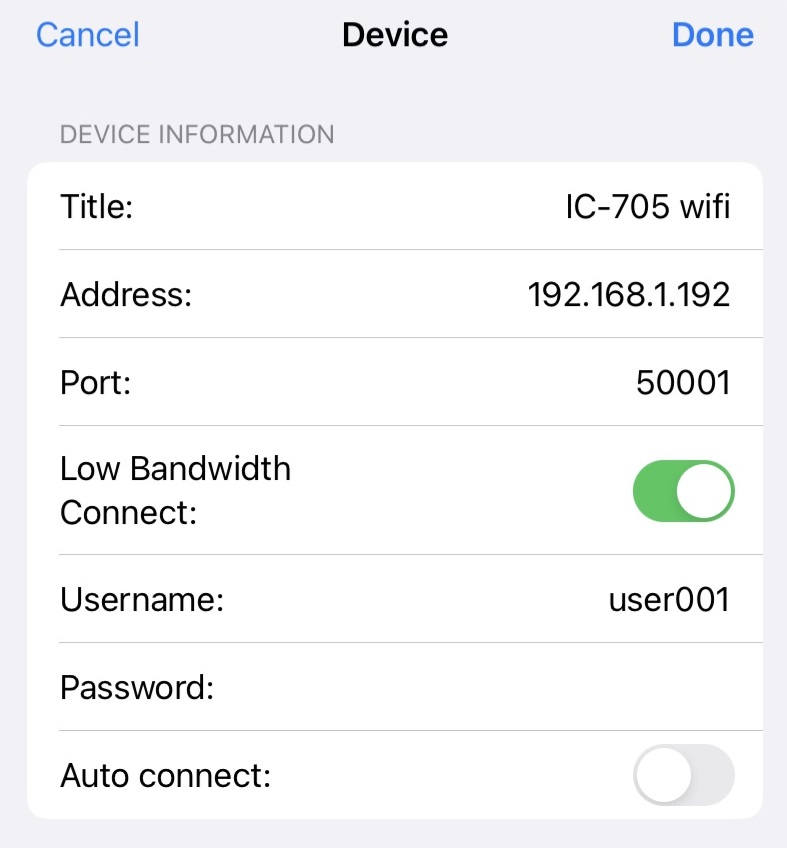
Here, you need to enter the information you have collected during the Radio setup as described before. You can also enter a Title for your Radio.
The Low Bandwidth Connect feature is designed to minimize network traffic. This option is particularly useful when operating on unstable or slow network connections. However, if you’re on a stable and high-speed local network, you may choose to disable this setting.
The Auto Connect feature offers added convenience, especially if you operate just one radio. When this option is enabled, the app bypasses the “Available Radio” screen and automatically connects to your designated radio.
Important
Exercise caution when using the Auto Connect feature. Ensure that your radio is configured to maintain a consistent IP address. If the IP address of the radio changes, the app will be unable to establish an automatic connection. Should this occur, consult the ‘Common Issues’ section of this manual for troubleshooting guidance.
Once you tap on Add at the top and back on the previous screen you will find your newly added Radio in the list.
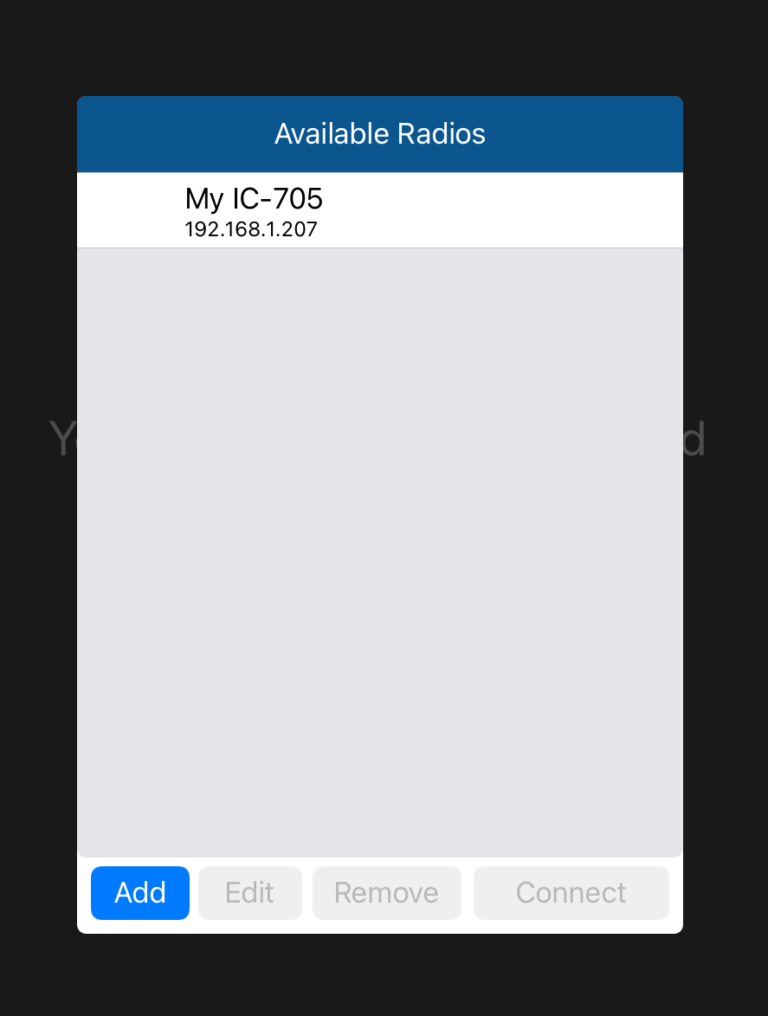
To connect to your Radio, just select (highlight) the entry and tap on Connect – or double tap on the line in the list.
4.3. Final settings (Important!)
Once you can connect to your Radio, don’t forget to adjust your ALC level as described further below. This setting can be found under the IC-xxxx Settings tab.
Second, you may want to decide how the App should leave the Radio after disconnecting. The App just changes a few settings but depending on how you want to use your Radio without the App, you need to decide which settings should be reverted after the App disconnects. These settings can also be found under the IC-xxxx Settings tab after being connected.
Finally, use the Network Stats Tool (under Tools) to see if you have a good network connection to your Radio. You should always have an error rate below 0.05% for a smooth operation. If the error rate is higher, you need to investigate for your network problems (see the common issues section for further help).
5. The Main Window
After connecting to your Radio, you will see the main Window which includes all frequently used functions for controlling the Radio and the waterfall as shown below:
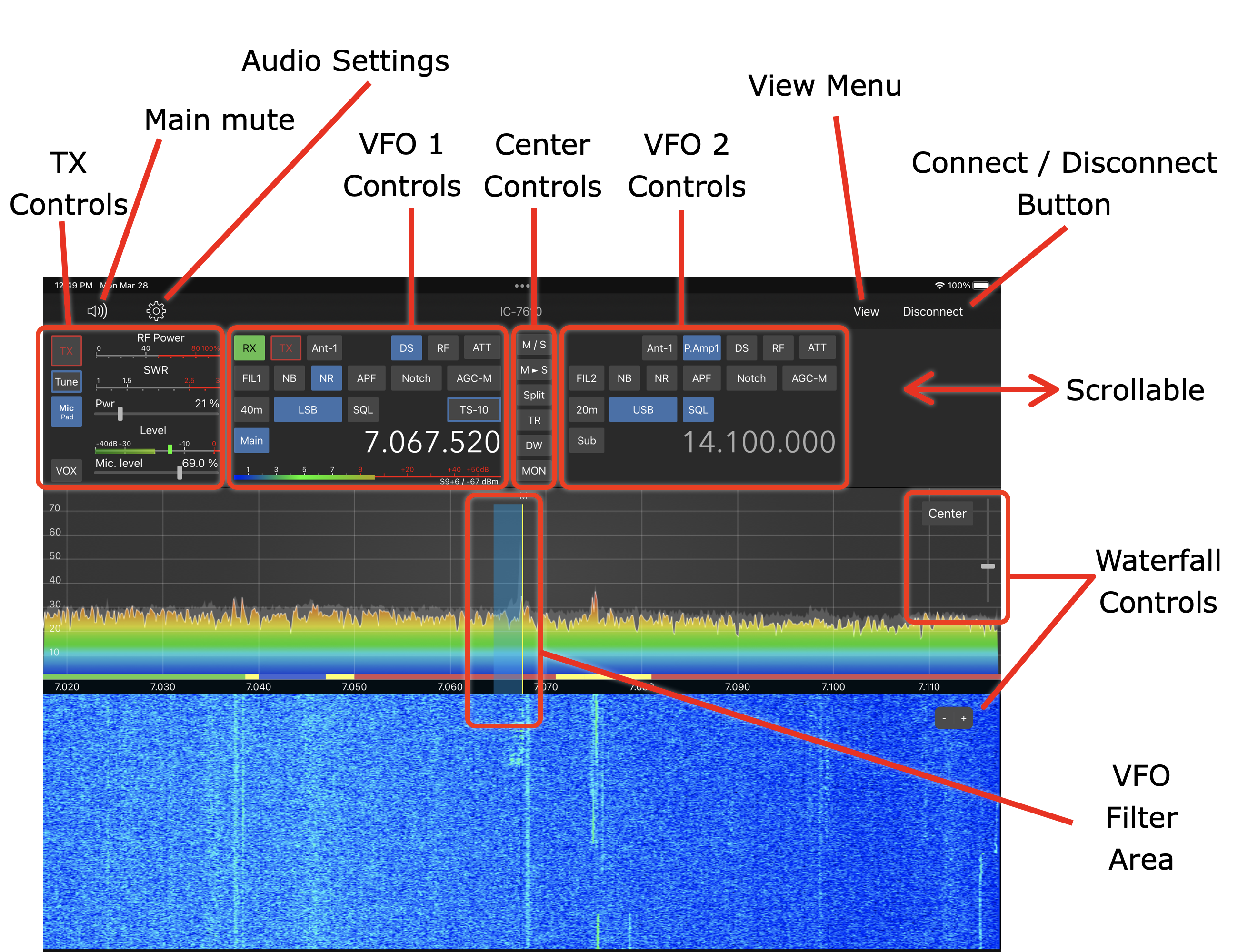
The main window is divided in certain sections with buttons, sliders and meters.
Most buttons have identical names and functions like the physical or soft-buttons of the Radio and for this reason, they are not explained here further. Other buttons are special to the App and explained below.
On some iPads or when in portrait mode, you will not see all of the top controls. For this reason, this area can be scrolled to the left and right.
5.2. TX Controls
The Tune button tuning feature can only be used if your Radio has an Antenna tuner included or if a tuner is attached to it. However, long-tapping on Tune can be used to generate a 10% AM signal even without using a Tuner. A framed Tune button indicates an active tuner.
The Mic button needs to be used to define the microphone input source for your Radio. The available sources can be selected by long-tapping this button. To use your local iPad (either the internal microphone Headset connected to your iPad) as microphone source, chose iPad as selection.
Note
When selecting iPad, you will see a dedicated audio level meter otherwise the Radio Compression meter will be displayed. Compression and Anti-VOX is not available when using the iPad as microphone source.
Long-tapping the power meter offers the option to replace this meter by the ALC or ID meter.
5.3. VFO 1 and 2 Controls
Depending on the VFO Mode and Radio model, the two VFOs are either called VFO A and B or Main and Sub.
Some Radios like the IC-7610 allows maintaining the settings of both VFOs at the same time. For others this is only possible for the currently active VFO. In that case, either click on the Main / Sub or VFO A / B buttons or on the VFO frequency to activate one of the two VFOs. All available buttons will get visible for the selected VFO and can be maintained as usual.
Tapping on the Frequency offers a screen for direct frequency input. Keep in mind that it must either be a frequency in MHz or kHz depending on the App setting.
5.4. Center Controls
These buttons are also similar to the buttons available on your Radio and are mainly responsible for the relation between the left and right VFO. For instance the M/S (or A/B in VFO Mode) will swap the left and right VFO.
Some buttons like SAT (for Satellite Mode on an IC-9700) or TR (for Tracking mode on an IC-7610) are only available for Radios supporting this function.
5.5. Waterfall Controls and the Waterfall
The slider on the top right side of the Waterfall section can be used to adjust the waterfall reference level.
Hitting the button left from this slider let you chose the Waterfall mode like Center, Scroll-F, Scroll-C or Hold.
Hitting “More…” will show additional Waterfall settings.
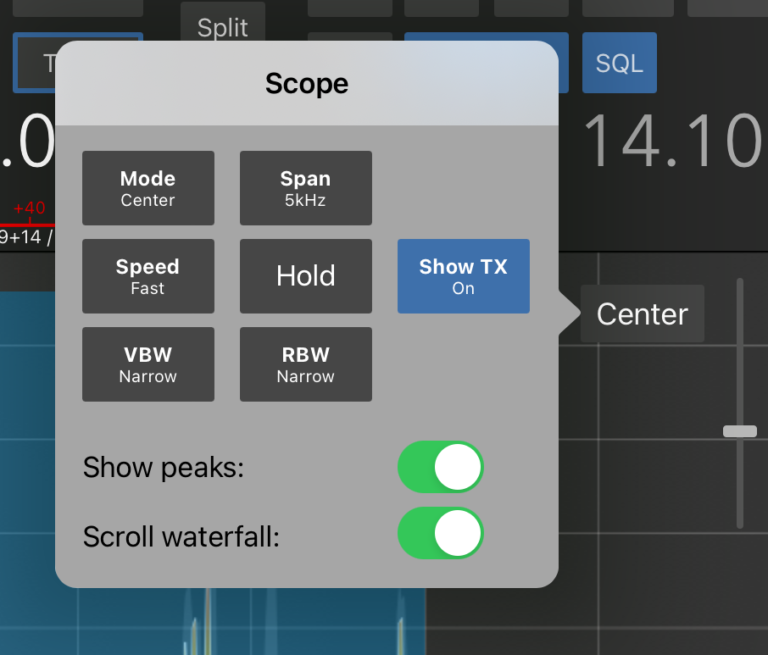
Note
Waterfall fixed mode is not supported.
Note
Depending on the Radio capabilities, some features are not available in all Waterfall modes. For example, the Show TX setting only works in Center mode.
Further details are explained further below in the Frequency Tuning section of this Manual.
6. Supplemental Windows
In addition to the Main Window, you can open (and keep open) additional supplemental Windows from the View menu.
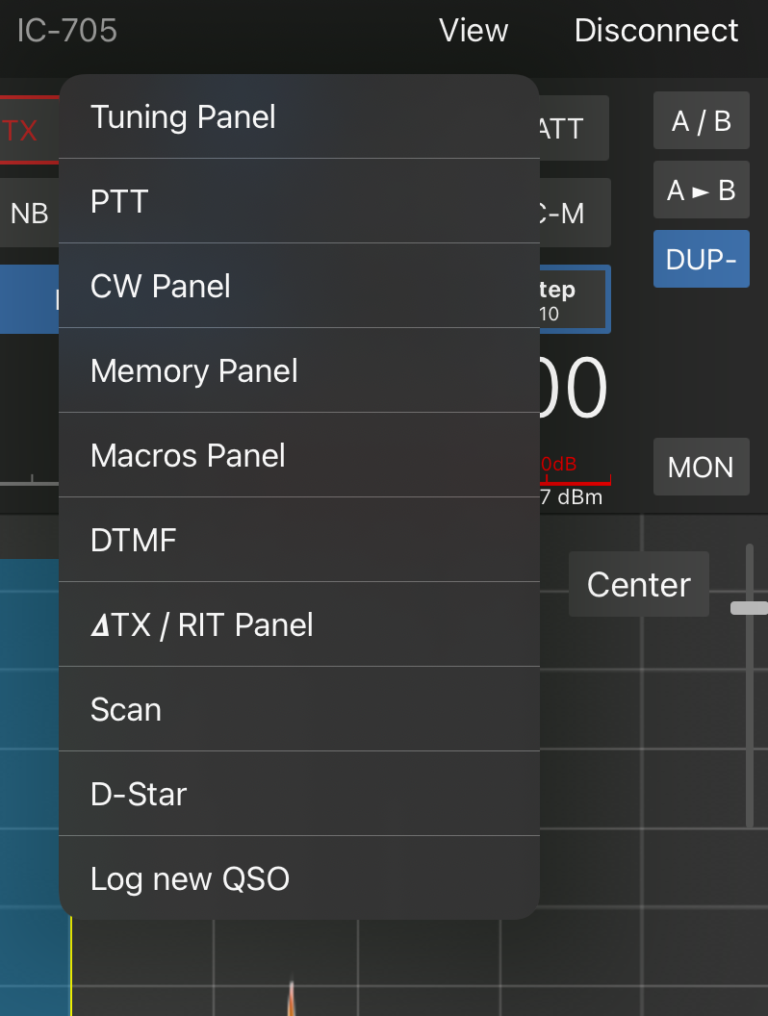
These are, for example a separate Tuning-, CW-, Rit/Xit- and Memory Panel or Macro Quick access buttons and a DTMF Panel to send DTMF Tones or a Repeater 1750 Hz signal.
The Tuning Panel Window can be used to fine-tune the VFO Frequency:
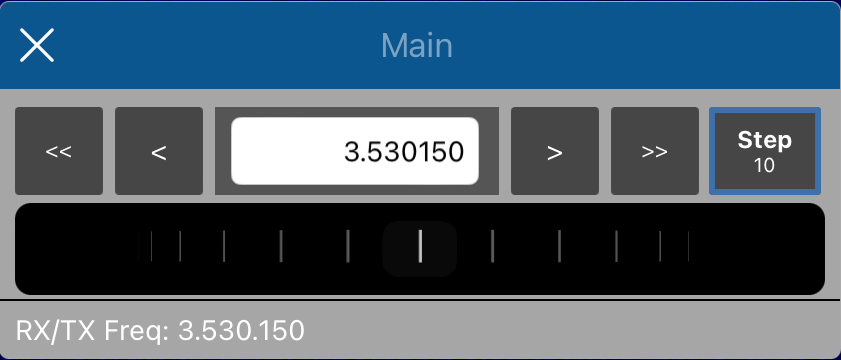
This Window can be used to send CW:
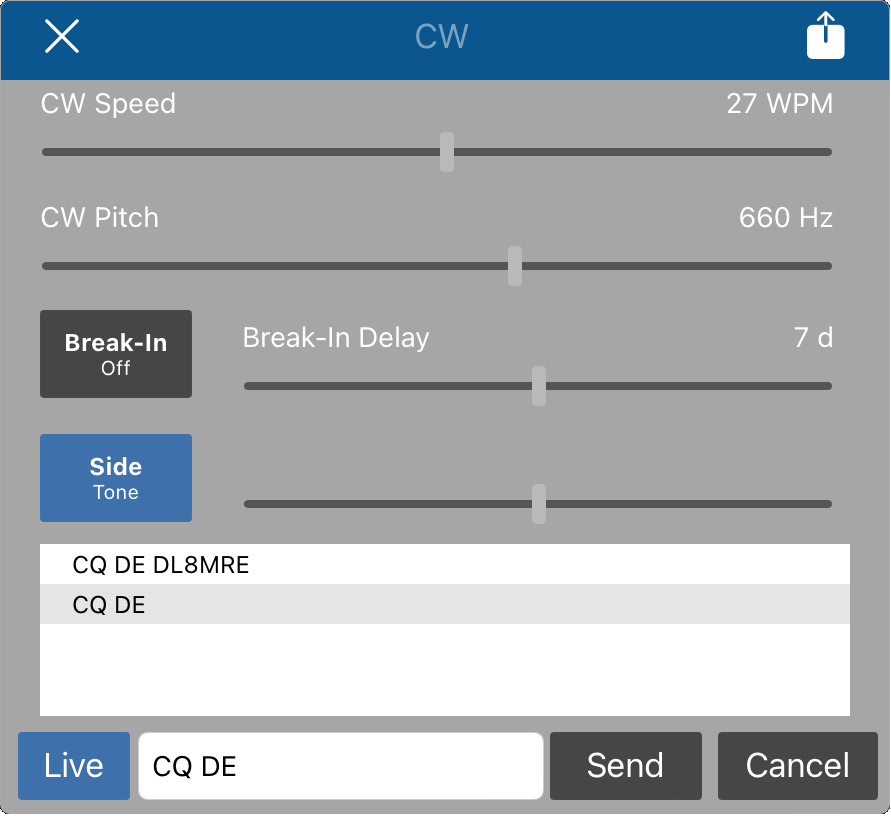
If you hit the top right-hand button, you can squeeze (and enlarge) this CW Window.
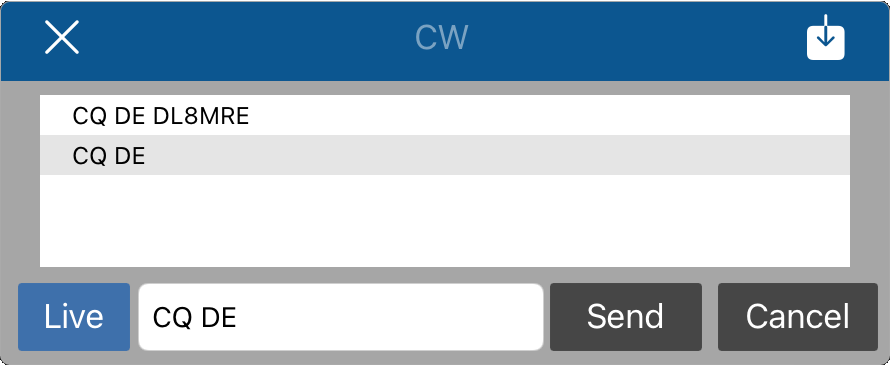
This Window can be used to operate in Rit / Xit mode:

This Window can be used to scan in one of the available Scanning types.
Note
The Icom Radios don’t allow to set the Scanning parameters like program ranges remotely so you need to maintain those settings at your Radio.
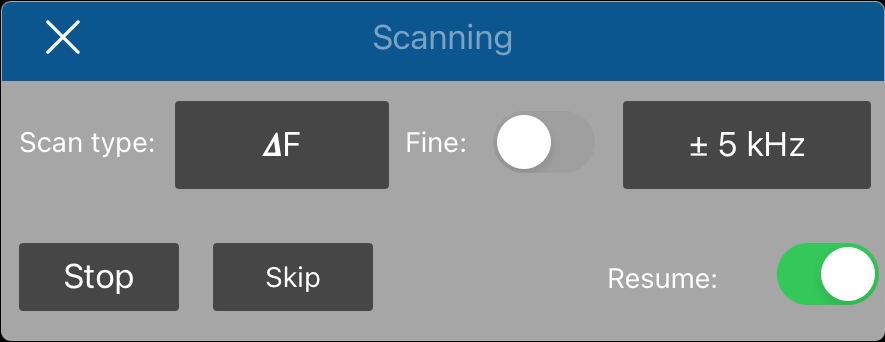
For Radios supporting D-Star (DV) this Window displays the current D-Star status and displays received messages. From here, you can also set your D-Star settings.
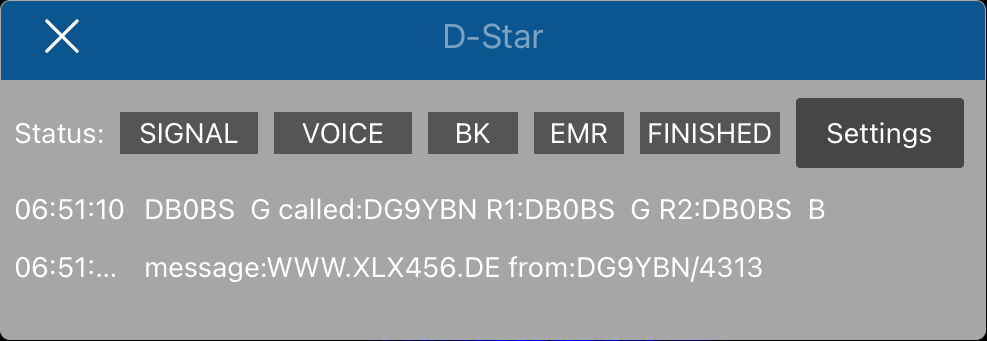
7. Settings
In this App, you can maintain different types of Settings. First, there are general App Settings which are App and not Radio specific such as your HAM Radio information like Call-sign, Country, Locator etc. and your credentials for the integrated Call-Sign lookup features. These settings can be maintained from the Settings tab at the bottom. Second, there are Radio specific settings which can only be maintained, once you are connected to a Radio. In this case, you will see another tab at the bottom named according your Radio type which can be used to maintain the Radio settings.
And finally, there are the Audio settings which can be used to define your Microphone and Speaker source and volume.
7.1. App settings
Most of these settings are self-explanatory. It might be worth to go though these settings and add / select your personal information and preferences.
In the “Information & Support” section, you can find the “Contact Developer” button in case you have questions or issues.
7.2. Radio settings
As mentioned before, the settings here depend on the Transceiver you are using.
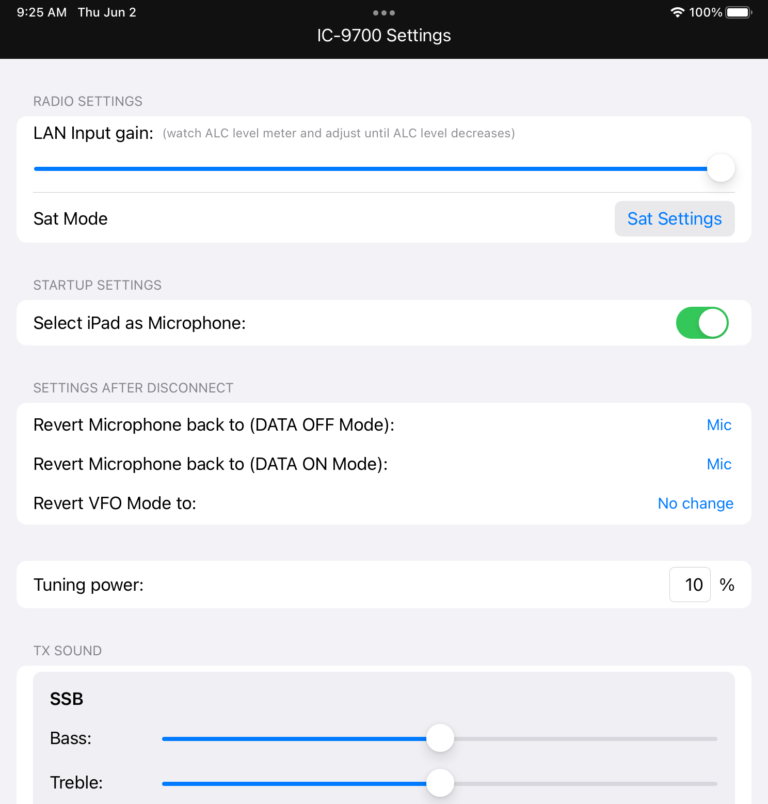
An important setting here is the LAN input gain slider. Before you start working in digital modes like FT8 using the App you will need to maintain this gain slider for a correct audio signal. For this, look for a free frequency and start transmitting in FT8 (e.g. by calling CQ) and move this slider up from the lower position until the ALC meter no longer increases. For this, you can either watch the ALC meter on your Transceiver (as this must only be done once) or you can change the Power Meter of the App to display the ALC meter but then you would have to switch between the Waterfall display and these radio settings.
Under “STARTUP SETTINGS” you are able to force the iPad Microphone to be activated upon App connection.
Under “SETTINGS AFTER DISCONNECT” you can decide how the App should leave your Radio once you disconnect from the Radio. If you want to use your Radio with the locally connected Microphone once you are no longer using the App, you can select “Mic” for DATA ON and/or OFF mode for example. So if you forgot to change the Mic setting back from inside the App, this setting will ensure that you can use the locally connected Microphone after disconnecting.
You may see additional setting options here on the Radio settings screen depending on the capabilities of your Radio.
For instance, the IC-9700 offers a SAT mode so for this type of Radio you will see a button to maintain your SAT settings which are explained further in a separate chapter below.
For Radios that are providing Memory groups you can also maintain Memory group names.
Note
If you have already maintained Memory Group names on your Radio, Icom doesn’t offer these names to remote Apps so you will have to enter the names again here for the App.
For Radios that are supporting different DATA channels like the IC-7610, under DATA MODE you can select whether DATA 1, DATA 2 or DATA 3 should be used.
7.3. Audio settings
The Audio Settings can be reached by hitting the top gear Icon.
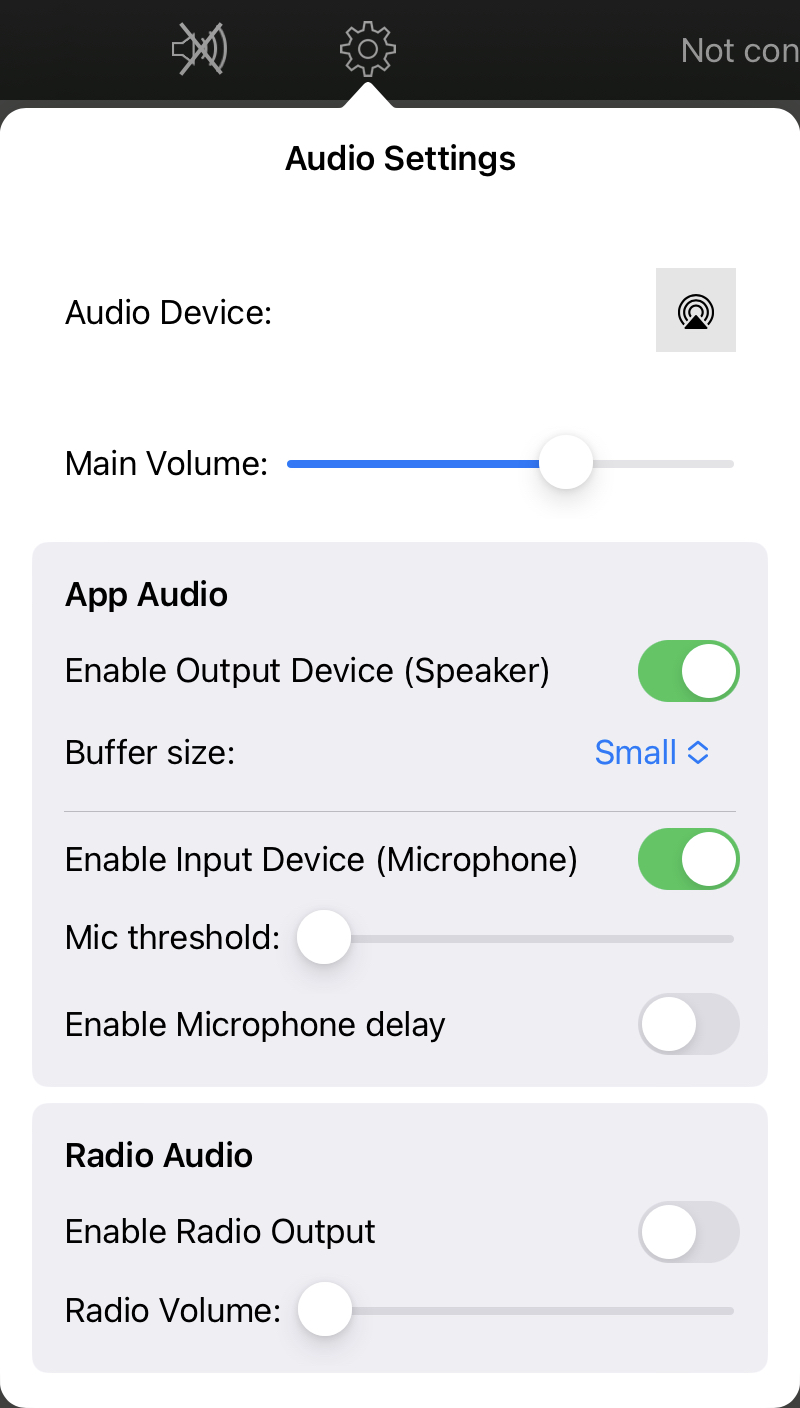
Using button right of “Device:” you can select the audio device used by the App which can either be the internal Microphone and Speaker, a Headset or any other Audio device linked to your iPad.
Using the Mic Threshold slider, you can prevent submission of ambient noise by raising the slider as high as necessary.
At the bottom of this setting screen, you can enable and control the volume of the Radio internal speaker.
Change the Buffer size setting if you are experiencing audio dropouts.
Note
If you notice static noise at the beginning of your transmission, activating the Mic Delay setting may resolve the issue. This static is typically residual receive noise captured by the microphone as you start transmitting. If you’re using a headset, this option is generally not necessary and can remain disabled.
8. Frequency Tuning
Frequency tuning is probably one of the main activities when using the App. For this reason, there are several possibilities for frequency tuning:
In Center mode: Move the waterfall to change the Center Frequency. Just tap somewhere at the waterfall, hold your finger down and move to the left or right
In Scroll-F or Scroll-C mode: tap-and-hold the VFO Frequency (the yellow line) and move it left or right.
Double-tap somewhere on the waterfall to move the currently active VFO to that frequency
Tap on the VFO Frequency and get an input screen to enter a frequency manually
Use the supplemental Tuning Panel window to fine tune a frequency (View Menu → Tuning Panel)

Here you can use the <<, <, > or >> buttons to tune the frequency down or up based on the Step settings. Tap and hold these buttons to repeat stepping.
You can use the tuning wheel for tuning as well. Depending on your personal preference, you can reverse the wheel direction in the App settings.
In addition, you can also tune the frequency by
The physical VFO knob at the Transceiver
Attach a MIDI controller such as the DJ2GO2 to your iPad via USB cable and use it for frequency tuning and more
Attach a Keyboard to your device and hold the Option Key along with , (comma) or . (dot) to change the frequency down or up by one step or 10 steps when additionally pressing the shift key.
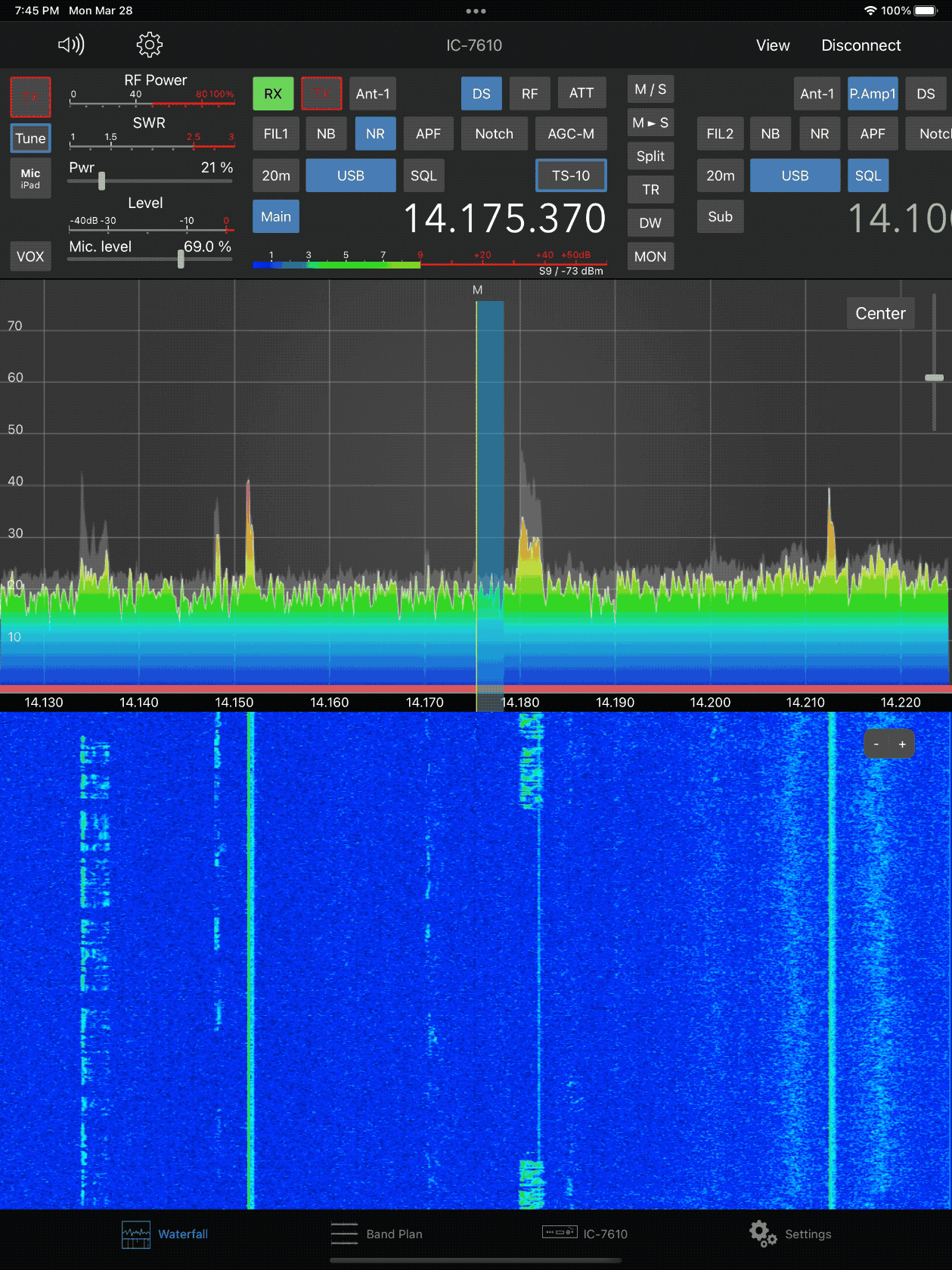
9. Memories
Memories, stored inside your Radio can be recalled using the supplemental Memory Window (View Menu → Memories)
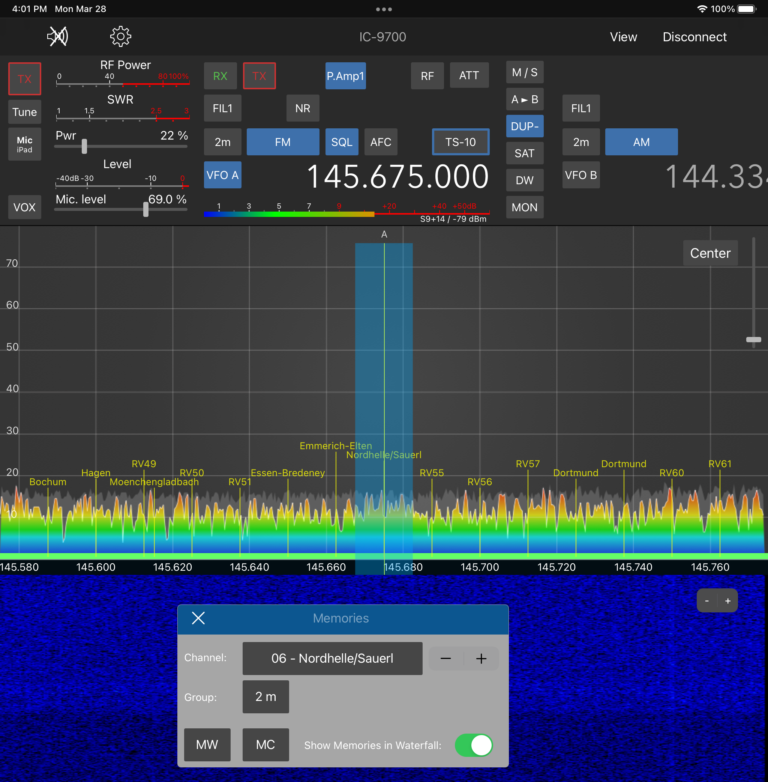
Using the MW button, the current frequency can be stored to a certain Memory channel and given a name.
The MC button will clear the currently selected Memory channel.
The Show Memories in Waterfall option will, if enabled, display the Memory names at the frequency location in the waterfall as shown above. You can adjust the position and font size of these Memory-Spots in the App Settings.
Memories can also be maintained in the separate Memories tool described further below.
10. Advanced
10.1. Satellite Mode / Transverter
If you are using a Transverter or are operating Satellites, you may want to show the effective frequency in the App and even use the effective frequency for logging.
For this, you can maintain a frequency Offset under Radio Settings of the App. Here, you can set and adjust the Offset frequency independently for RX (Receive) and TX (Transmit). The translated display frequency will be shown below for your reference.
Remember, the TX frequency is always derived from the VFO displaying the red TX indicator. The indicator may change if you switch to Split, Dual-Watch or SAT Mode.
10.2. SAT Mode
The IC-9700 offers a SAT mode which is supported by this App. Activating SAT mode will result in the following changes:
TR (Tracking) mode will be enabled
DW (Dual Watch) will be enabled
TX will change from the left to the right VFO
When TR (Tracking) mode is enabled, the TX frequency will automatically adjust in response to any changes made to the RX frequency.
Note
The App does not yet support automatically doppler-shift adjustment.
To adjust the Offset between RX and TX frequencies, first turn off TR mode, then adjust the RX frequency (which is now independent of the TX frequency), and finally, re-enable the TR mode.
Once everything has been setup, your Waterfall screen may look like this:
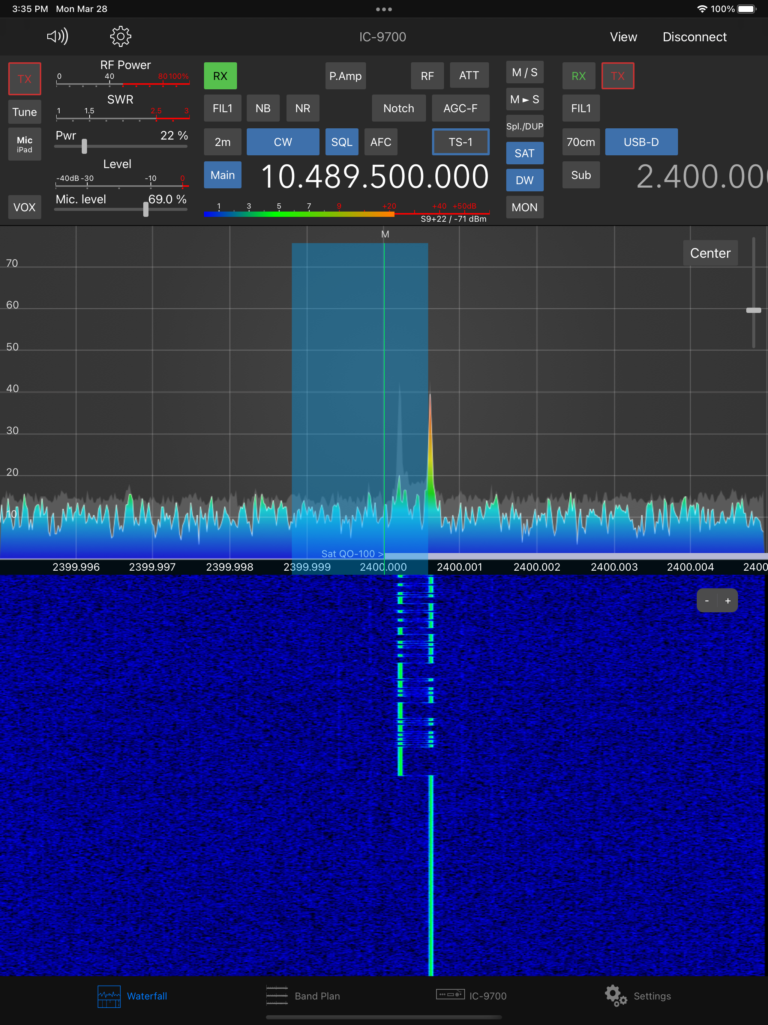
Both RX and TX VFO show the right frequency used for the Satellite. Moreover the band and mode indicators for the QO100 Satellite is available.
10.3. Switching the Radio on or off
A radio cannot be completely shut down by an App. It can only be put in standby mode or woken up from standby. To put the radio in standby mode, you can long-press the disconnect button. You can also configure a setting on the Settings tab to make the radio go into standby whenever you disconnect from it.
If you turn off the radio using the power button, you won’t be able to turn it on again with the app. To prevent this from happening and to bring the Radio into Standby mode instead of turning it off completely, you can configure a corresponding setting as follows:
For the IC-705:
Menu → Set → Function → Power Off Setting (for Remote Control) → Standby/Shutdown
or for other Radios:
Menu → Set → Network → Power Off Setting (for Remote Control) → Standby/Shutdown
Once this setting is configured, the radio will ask whether to power it off or put it in standby mode whenever you use the power button.
1. Tools
Under the Tools tab you will find several helpful features which are extending this App.
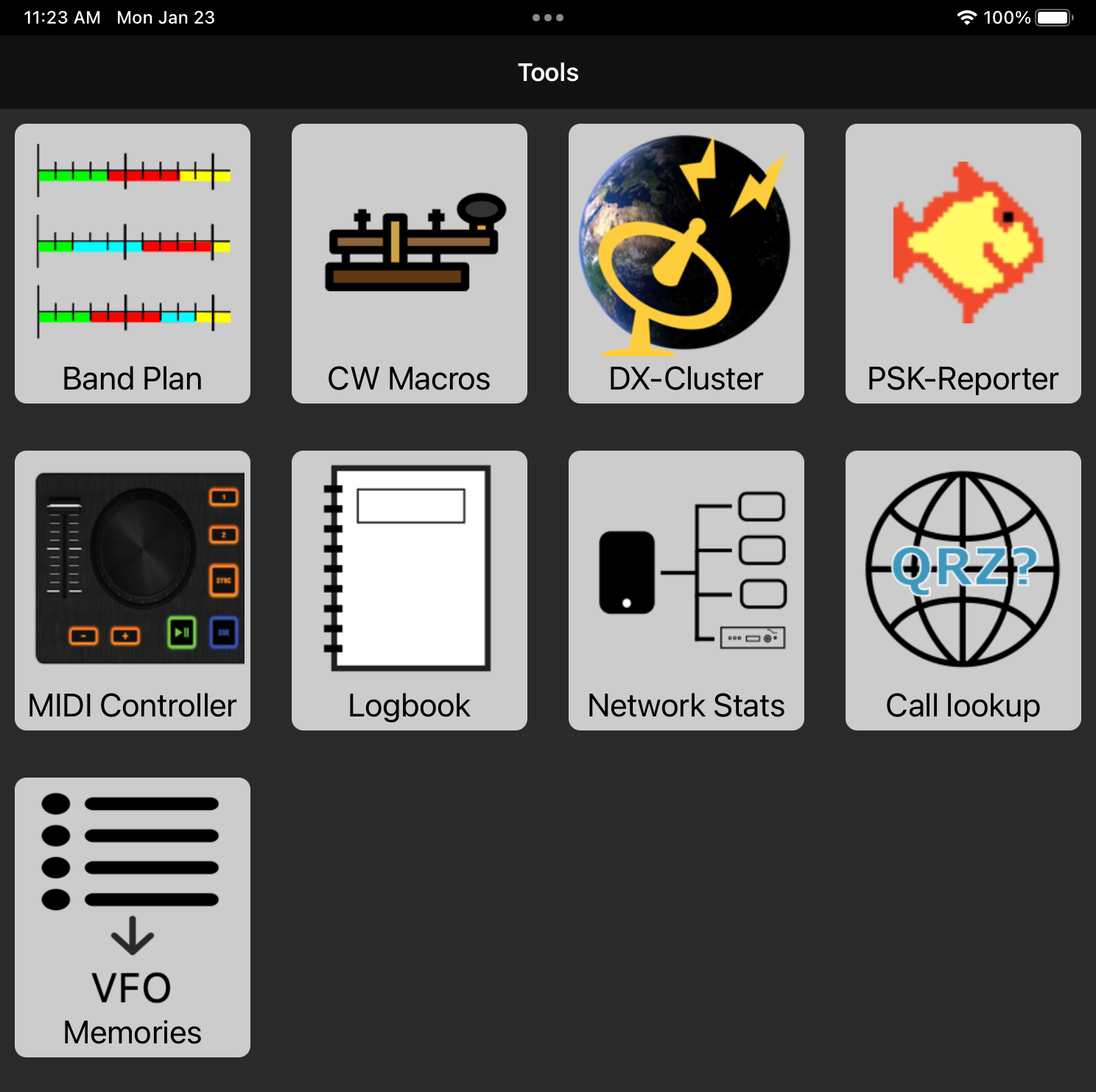
Some Tools like the Network Stats Tool are for informational and debugging purposes. Some Tools like the MIDI Controller will add additional controlling capabilities to the App. Other Tools like the Logbook can even be used separately, without being connected to the Radio but all Tools are fully integrated and work seamlessly together with the App and your Radio.
2. Band Plan
The Band Plan tool provides a frequency overview of all HF HAM Bands for your particular region as well as the modes and maximum bandwidth as suggested by the IARU.
Note
You need to select your particular IARU region under the App Settings in order to see the correct Band Plan for your region.
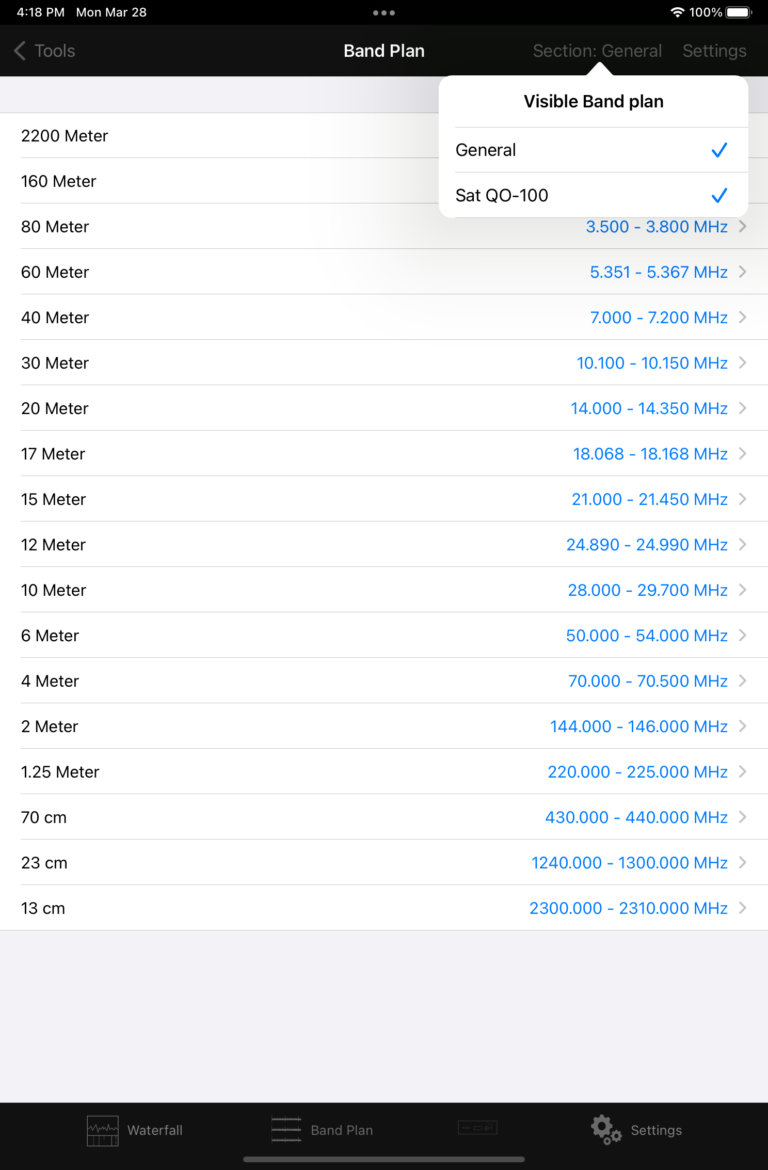
At the top, you can select if you like to see the General or QO-100 Sat Band Plan, which is also included.
If you tap on a band, you can see more details for the selected band.
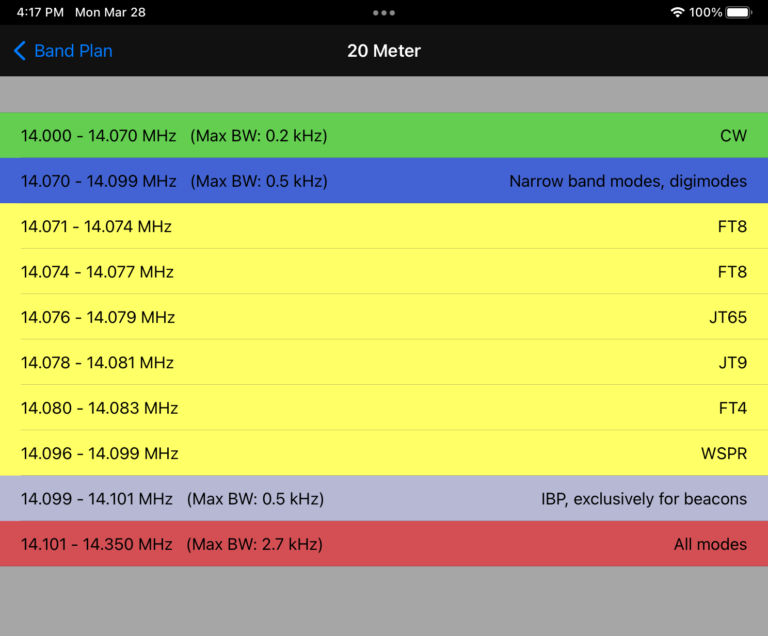
If enabled under Settings, the Band limits and modes will be visible within the Waterfall as seen below:

The “10 Meter >” information represents the Band limits information and the colored line represent the various modes like CW (green), Digimodes (blue), Narrow modes (Cyan), All modes (red), Satellite (yellow), others such as Beacons or guard channels (gray).
3. CW Macros
It is possible to create CW-Macros for your CW QSOs. After opening the CW-Macros tool, you can maintain up to ten different macros which can use Placeholders like {MYCALL} which will be replaced before the Macro gets sent.
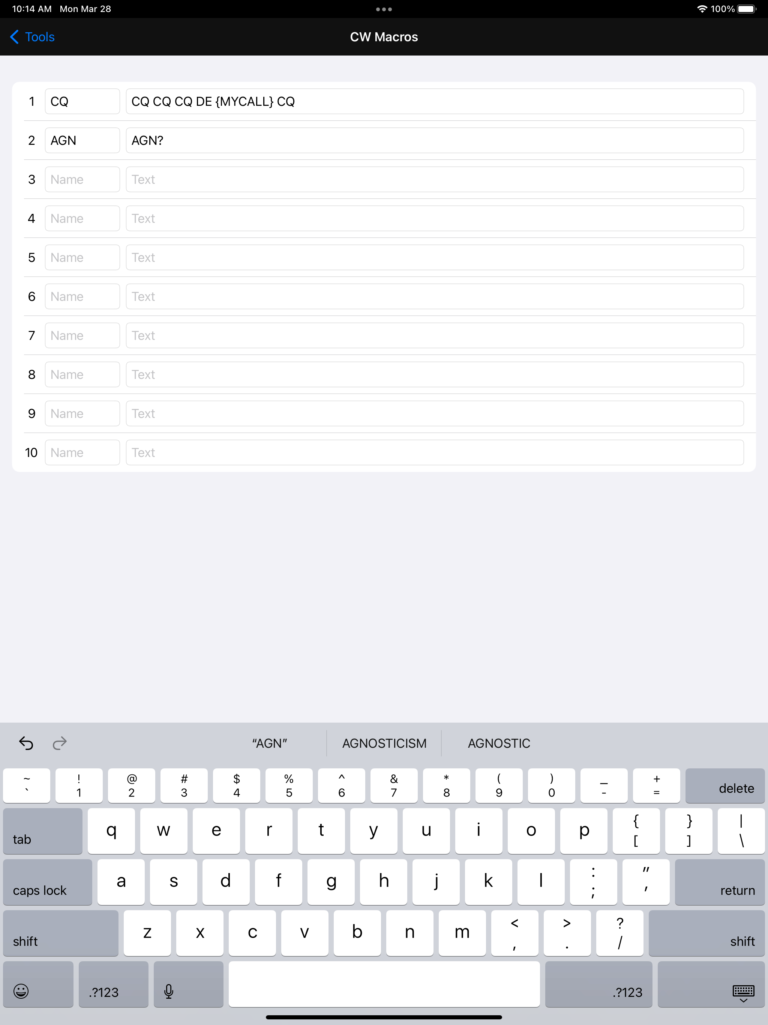
A list of available Variables can be found in the Attachment of this manual.
To use CW-Macros, you can open the supplemental Macros window (View → Macros) for easy access as seen below.
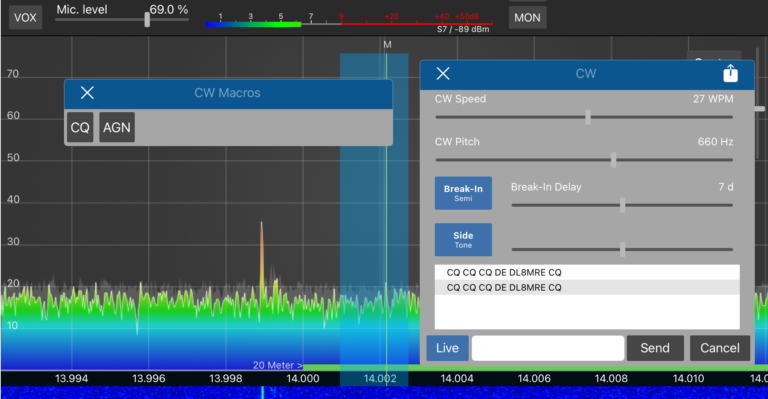
For CW Macros, you can send pro-signs like BK by using the ^ prefix character (e.g. ^BK).
Macros can also be sent using a physical keyboard and pressing the keys 1 to 0 along with the option key or a MIDI controller.
4. DX-Cluster
The DX-Cluster Tool connects to any of several pre-defined worldwide DX-Cluster Databases or even your local CW-Skimmer and displays results (Spots) directly on the Waterfall or let’s you directly jump to the frequency of a particular Spot by just tapping on an entry in the list.
After starting the DX-Cluster Tool, you need to click on Start to start querying the selected DX-Cluster server.
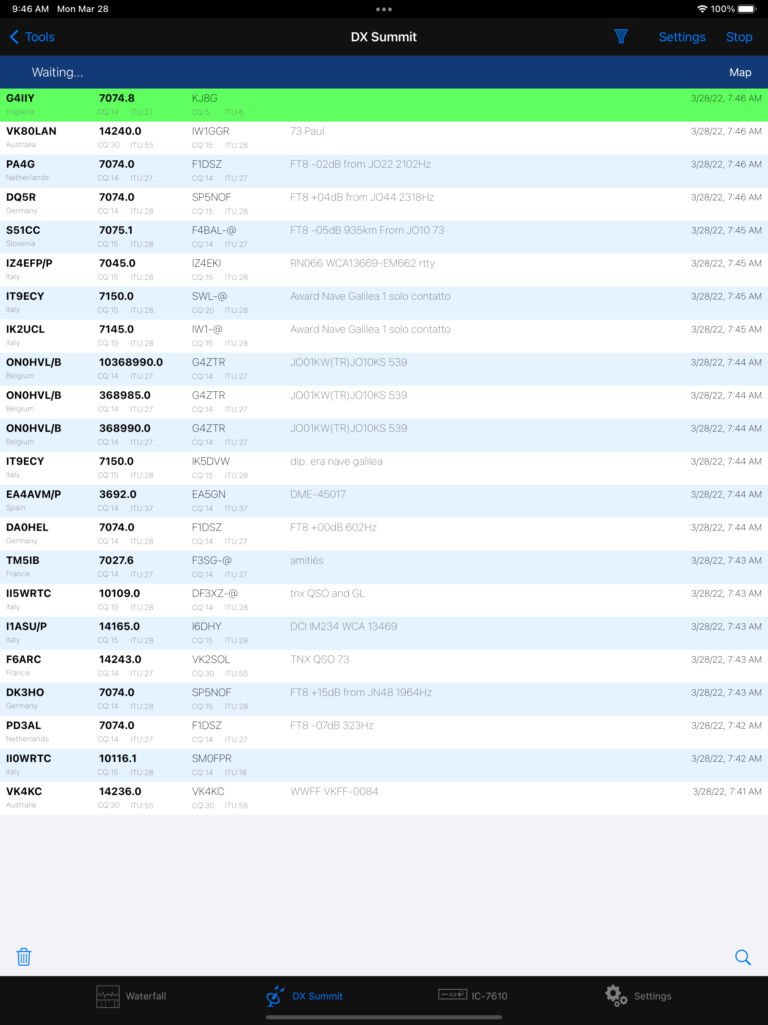
If you double-tap on a line in this list, the Transceiver will tune to the particular frequency of this spot.
If you single-tap a line, you will see more details about the Spotter and Call.
Tapping on the Filter Icon at the top will show the various Filter options:
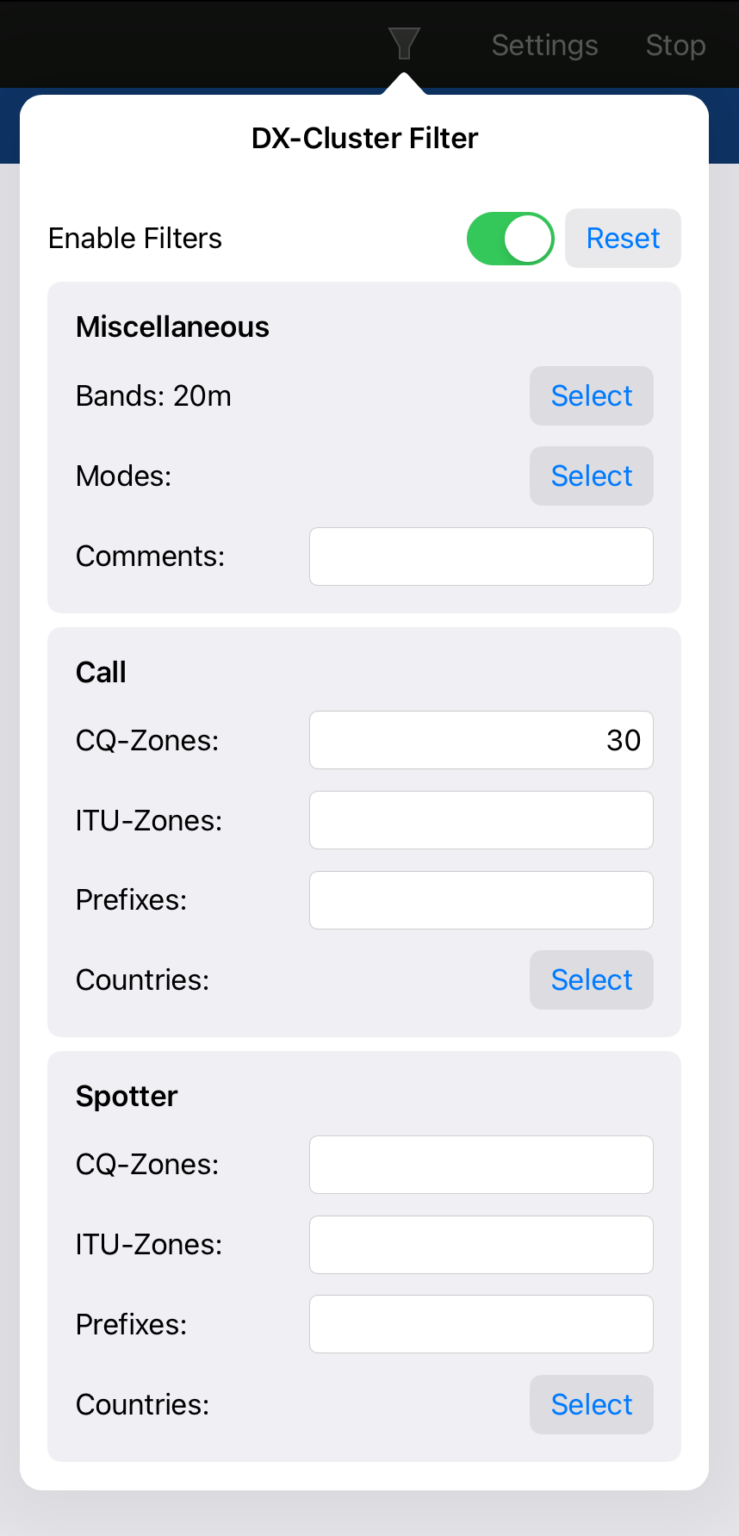
Here, you can select the Bands or Modes or Countries you are only interested in or enter CQ-Zones, ITU-Zones or prefixed of Spotter or Calls you only want to see. For those you can enter multiple values, separated by comma.
At the top of these filter settings, you can either enable or disable these filters.
The Settings menu will let you alter several options of the DX-Cluster Tool. From here, you can select a one of the predefined servers or add your own by clicking the Add button.
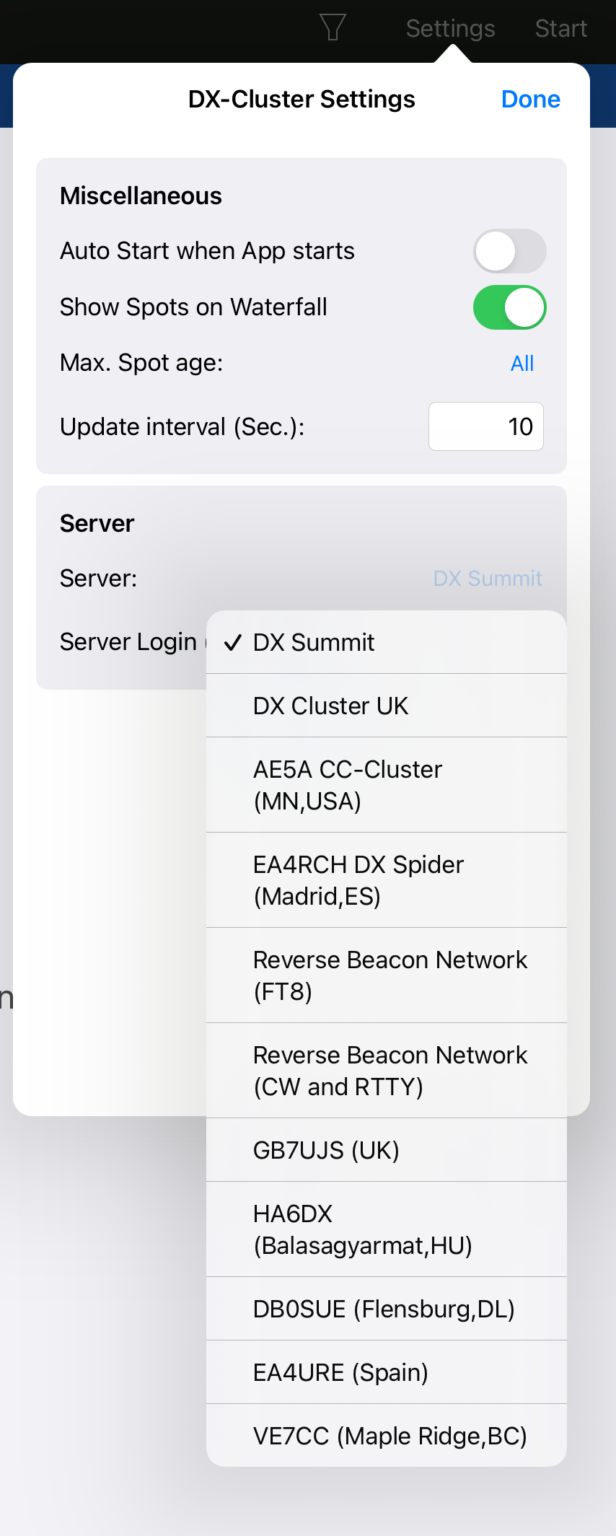
4.1. Map
You can either see a list of all current DX-Cluster entries or a Map by tapping the Map / List button at the top.
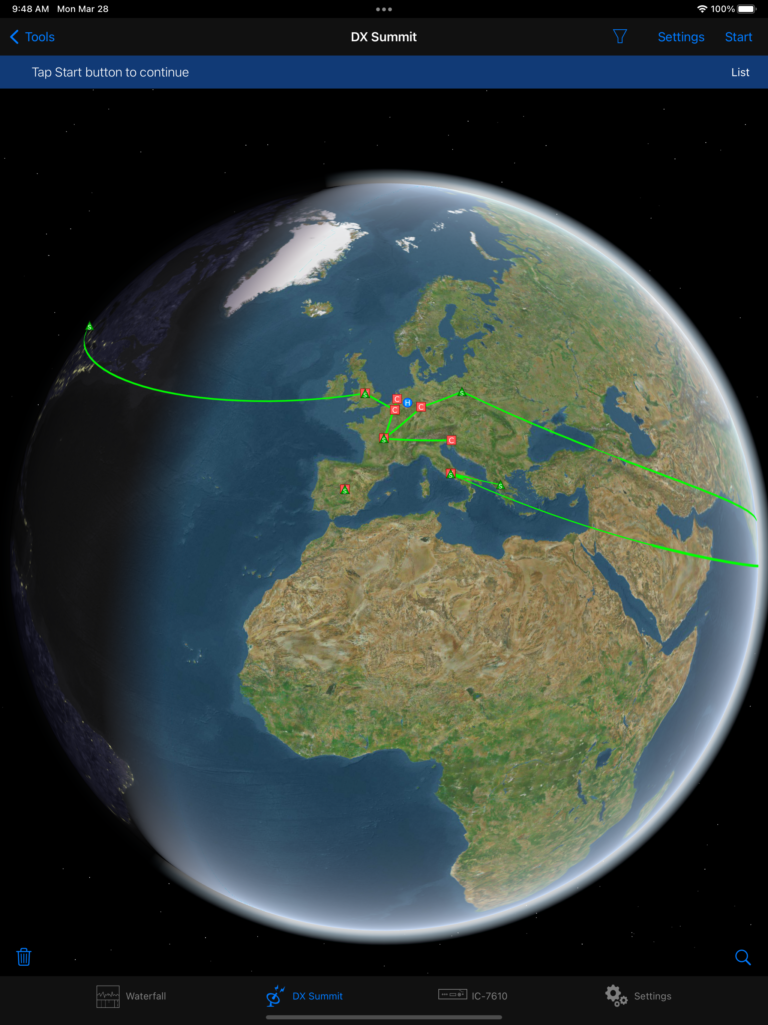
5. POTA
The POTA Tool shows Parks on the Air (POTA) spots in a similar way like the DX-Cluster tool does for regular spots.
POTA Spots and be displayed on the Waterfall. You can directly jump to a certain frequency of a POTA Spot and take over Park information to the Logging Window.
Note
The POTA Tool can be unlocked along with the DX-Cluster Tool. Once any of these two tools have been unlocked, the other is unlocked too.
After starting the POTA Tool, after a short while, you will see all spotted POTA stations
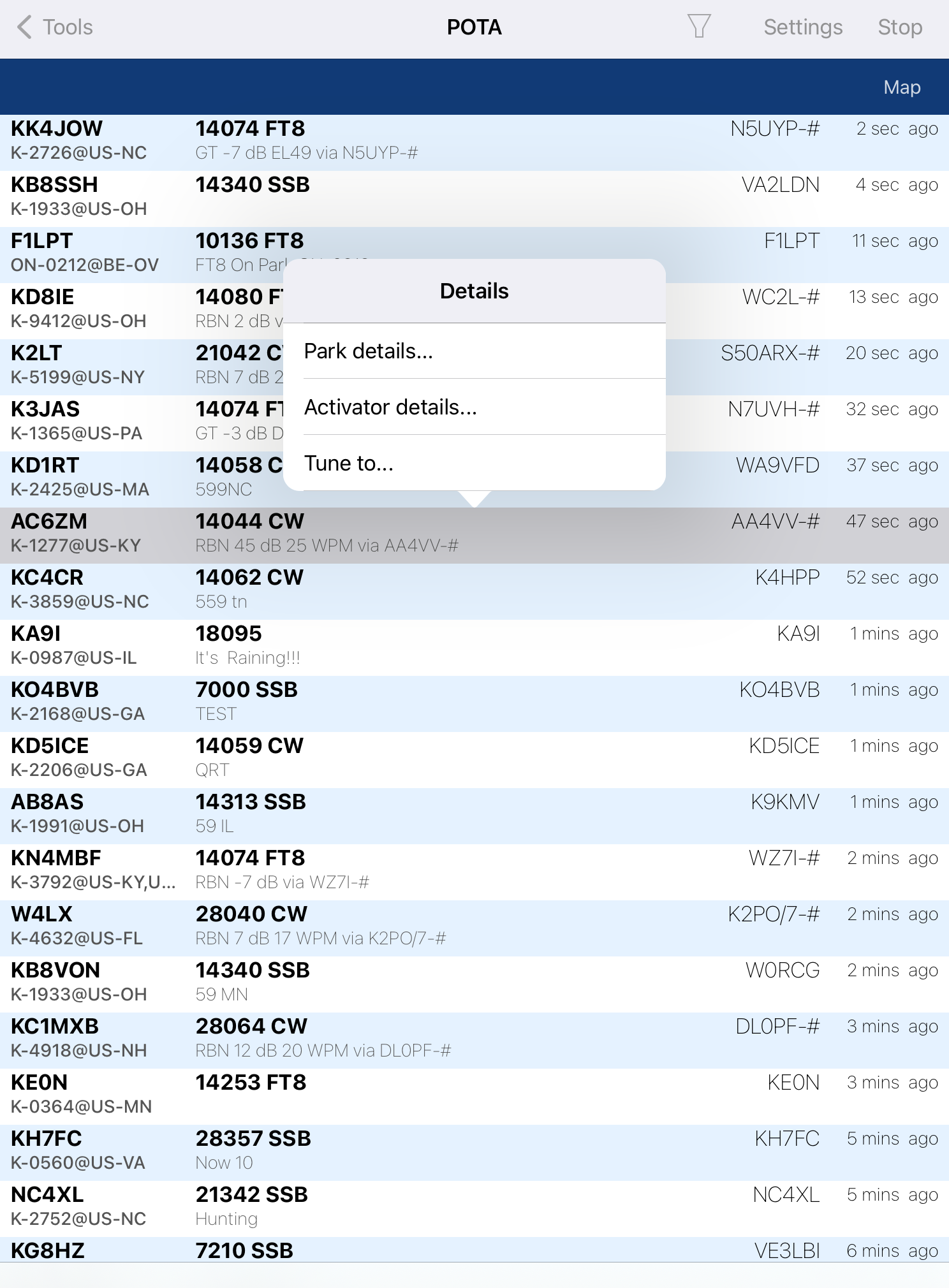
If you double-tap on a line in this list, the Radio will tune to the particular frequency of this spot.
Note
Tuning to the spot will not work for FT8 as the announced frequency is never the exact FT8 frequency. For FT8 Spots, you will need to open the FT8 Tool manually and look out for the POTA Activator.
Second, logging information will be prefilled to the logging window, if it had been opened before.
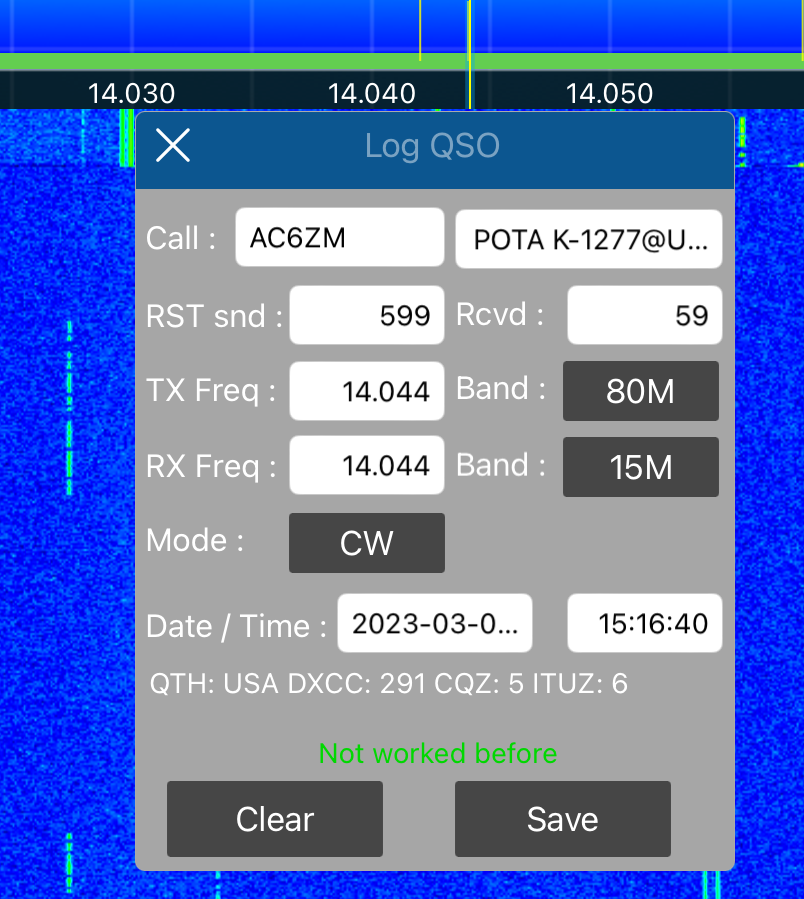
Note
For FT8 and for using this feature, you need to turn both auto logging settings off as otherwise FT8 QSOs will be logged without the additional POTA information.
5.1. Map
You can also get all current POTA stations displayed on a Map by hitting the MAP button
6. PSK Reporter
PSK Reporter is a great automatic propagation reporter for digital modes, including FT8 / FT4.
You can use PSK Reporter to get an almost instant idea about the current DX conditions and who is able to copy you around the world.
This App integrates PSK Reporter in two ways.
6.1. Submitting PSK Reporter spots
PSK Reporter lives from the fact that many HAMs are contributing their reception reports to PSK Reporter. This App can automatically send FT8 reports to PSK reporter when enabled (under Settings inside the FT8 Tool or the PSK Reporter Tool).
If enabled, a list of received FT8/FT4 signals will be submitted to PSK Reporter every five minutes. Except for the information about your antenna (which is optional), nothing else has to be configured.
6.2. Viewing PSK Reporter results
The opposite side of PSK Reporter is to view a list of all stations who received your signal. This is, what the PSK Reporter Tool is for.
To get a report of stations that are able to copy you, first have a QSO or a test transmission on a band you are interested in. Next open this Tool and enter your callsign at the top of the window (it not already per-filled) and click on the start button.
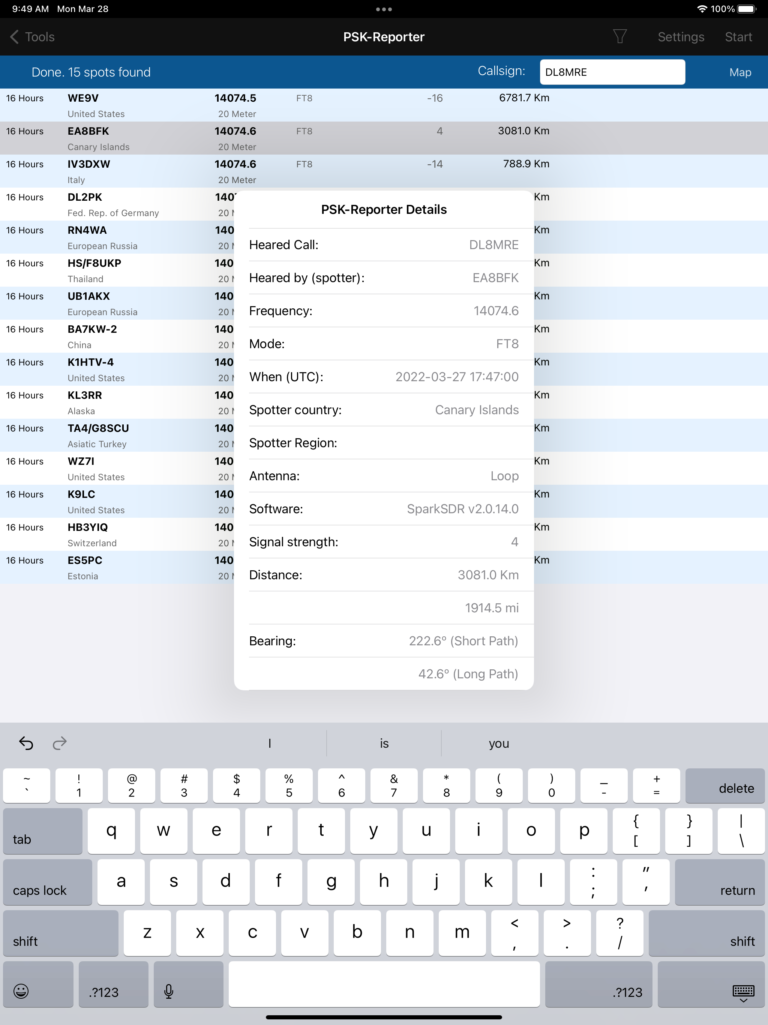
Once the list is filled with reports you can tap on a line for more details.
It may take up to 15 minutes after your transmission until you will see your results. This is because every contributing listener will update their reports every five minutes and it is not possible to download reports from PSK Reporter sooner than every 5 minutes as well. If you would request an update sooner than after five minutes, you will see an according message at the bottom of this window.
You can narrow down the results by using the Filter Icon at the top and selecting a Mode and Time.
You can also visualize all locations on a map by switching to the map mode using the Icon at the top.
7. MIDI Controller
Using the MIDI Controller Tool you can configure so called MIDI Controllers such as the DJ2GO2 or Behringer CMD Micro MIDI Controller for use with the Radio.

The following MIDI Controllers are supported:
Numark DJ2GO2
Behringer CMD Micro
Behringer CMD PL-1
Hercules DJ Controller Compact
Other controllers may work as well but they are not tested.
The MIDI Controller needs to be connected to your device using a USB Cable. You may need an Adapter to connect the controller supplied USB cable to your iPad (e.g. USB-A to USB-C or USB-A to Lightning). The DJ2GO2 doesn’t need extra power so a direct connection would be all you need. Other Controllers may need more power so you may need to use a powered USB Adapter.
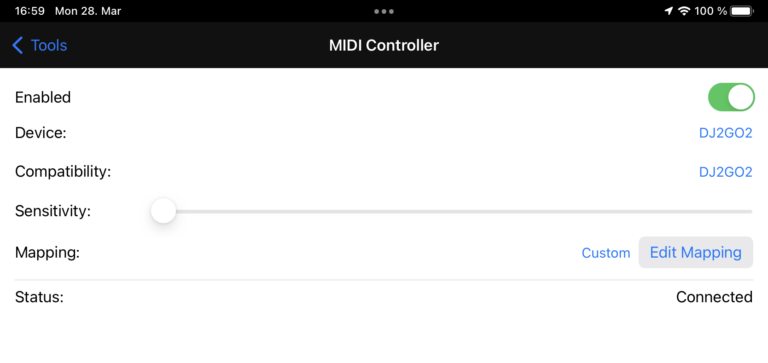
Once your MIDI controller is connected, you should be able select your Controller in the Device: selection.
If you then switch on the Enabled: switch, the Status should change to Connected as shown above.
To assign functions to each button, you need to open the Mapping Editor by tapping on Edit Mapping.

From here, you can assign Functions on Buttons, Controls (or Wheels and Sliders) and LEDs.
For assigning functions to Buttons or Controls, just hit the corresponding Button or turn the knob or slider on your Midi controller. A line with the corresponding code of the Control will be added, if necessary and highlighted.
Now, tap on the line and select a Radio action like “Adjust Main Volume” as shown above.
9. CTR2 MIDI and Dial Controller
These two tools enable the use of the CTR2-MIDI and CTR2-Dial Controllers, which are available for purchase from Lynn Hansen, KU7Q at https://ctr2.lynovation.com.
The controller serves as an interface for the radio, allowing operators to tune frequencies, adjust volume, activate PTT, and access several other features.
Additionally, it provides the capability to connect a CW paddle to your device.
The CTR2-Controller offers the flexibility of wireless connectivity via Bluetooth-LE or a wired connection through a USB adapter.
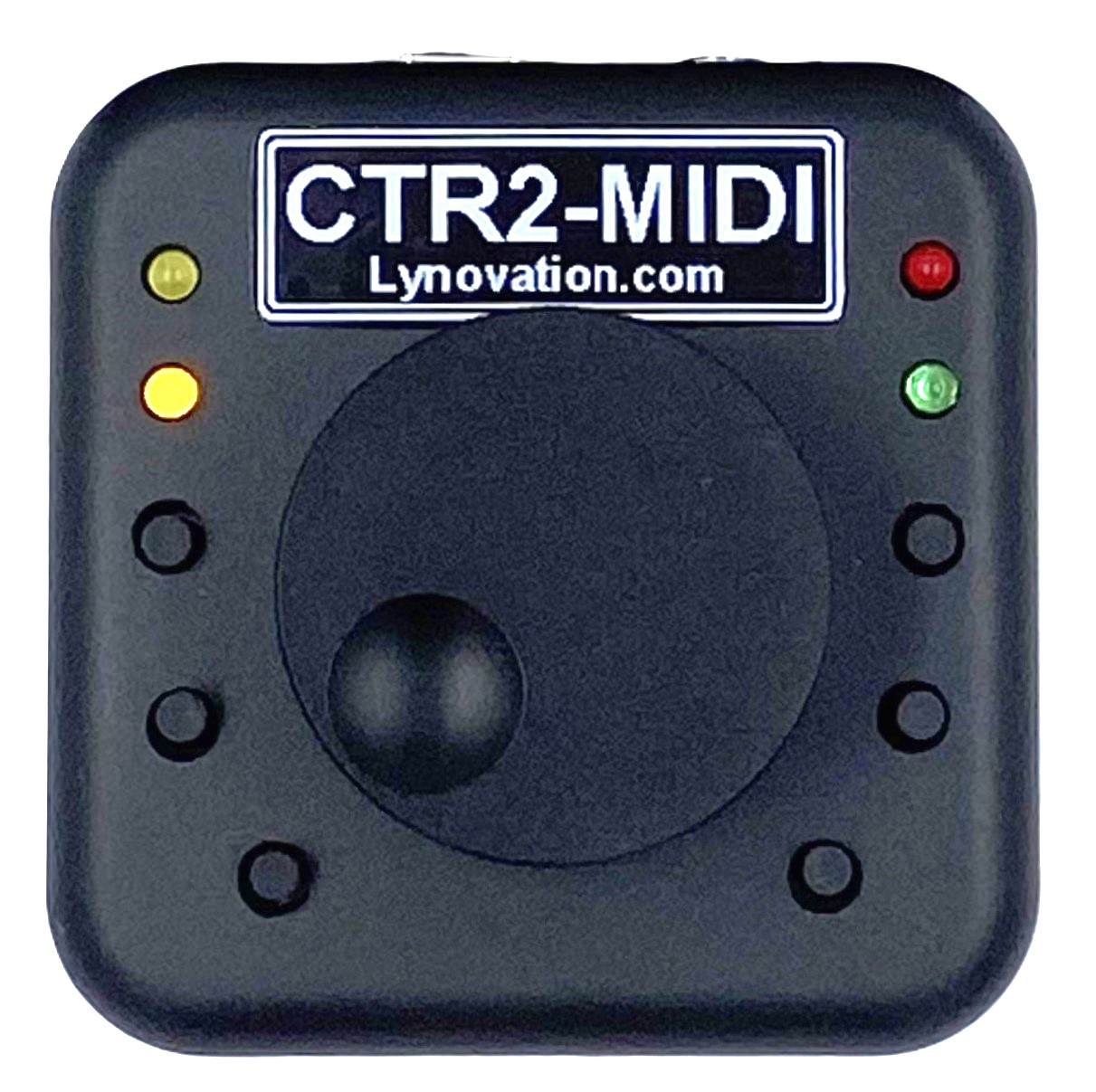

To pair a CTR-MIDI with your device via Bluetooth, ensure that the controller is powered on and in proximity to your device. Then, launch the CTR2 Controller or CTR2-Dial tool and click the “Find Bluetooth-LE Device” button at the top. The CTR2 should be detected within a few seconds and appear in the Device list. If the initial attempt is unsuccessful, close the tool, reopen it, and try again. Once the controller is detected, you can select it from the Device list under the name CTR2_xxxx whereas xxxx is a unique identifier different for each controller.
If you are connecting the CTR2 via USB, it will be listed as XIAO_ESP32S3 for the CR2-MIDI or STAMP-S3 for the CTR2-Dial Controller in the Device list.
After selecting the appropriate device and toggling the Enabled switch on, the status should update to Connected.
The controller comes with default mappings that allow you to use the knob for tuning, volume adjustment, and more. You can view and modify these mappings to suit your specific needs by clicking the Edit Mapping button.
Should you wish to revert to the default mappings after making changes in the Mapping editor, simply delete all mappings, close the editor, and reopen it.
When a paddle is connected to the CTR2-MIDI, it is ready for immediate CW operation. To adjust CW and paddle settings, such as CW Speed, Iambic mode, or paddle swapping, open the CW Decoder Mode Tool and click the Options button in the TX section.
For additional information and a comprehensive manual, please visit Lynn’s website. Lynn has also predefined mappings available for the different Controller variants.
10. Command Bar
The Command Bar feature is designed to maintain buttons that can be displayed on the Waterfall Main Screen. These buttons can open websites, start other apps, or send CAT commands to the radio. It is also possible to use keyboard shortcuts for start these commands.
The feature consists of two parts: the screen where you maintain the buttons which can be opened from the Tools screen.
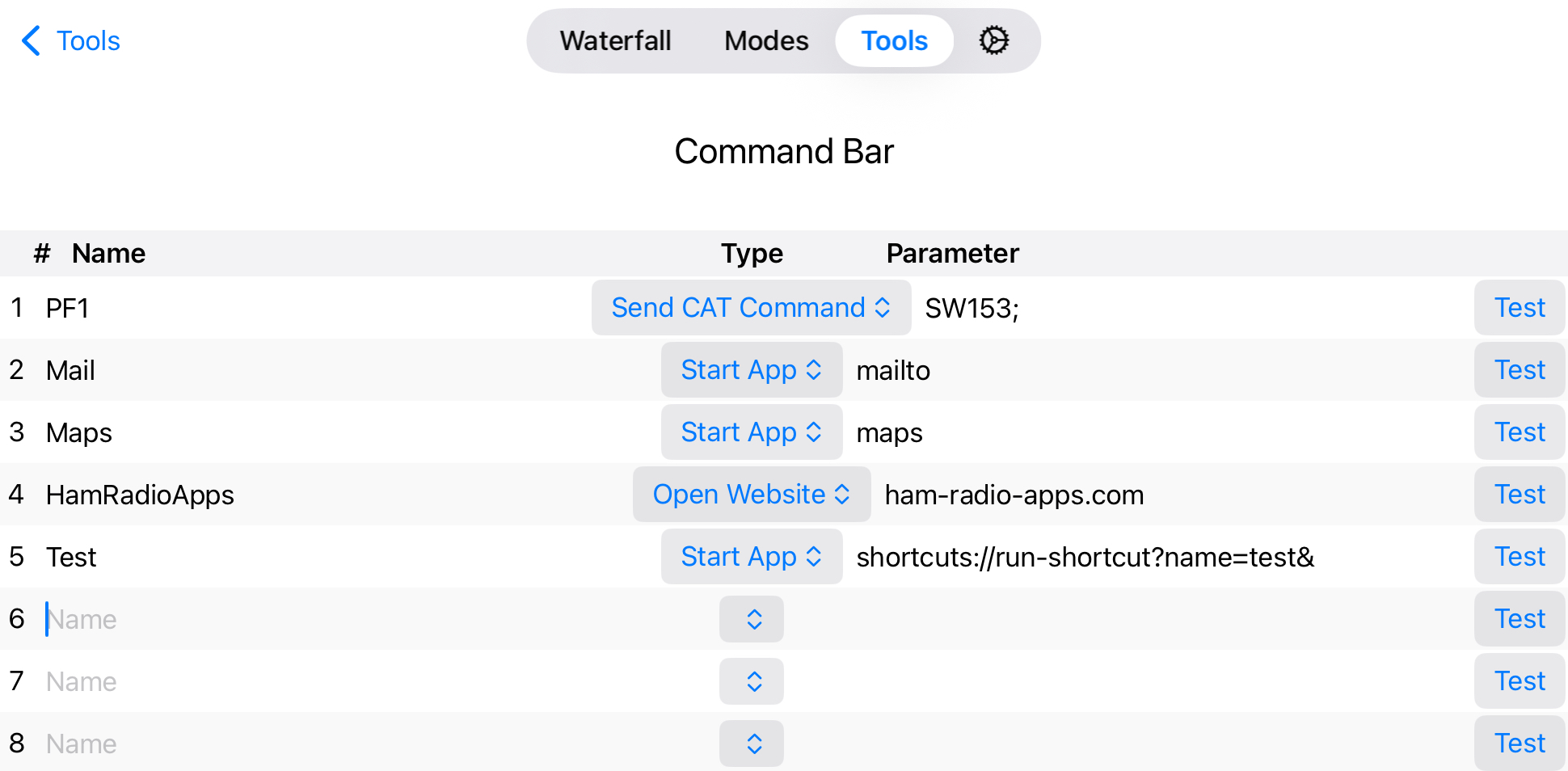
And the screen where the buttons are displayed.

To maintain a button, you can enter a Title, select a Type such as Start App, Open Website, or Send CAT Command. Depending on the type, you must enter a parameter which represents the app name, the website URL, or the CAT command.
The Title will be displayed on the Command Bar when shown on the Waterfall. You can leave the Title blank, in which case the button will not appear on the Command Bar, although it’s still possible to use keyboard shortcuts to start it.
To start apps, you need to enter the so called URL-Scheme for the app. For Apple’s Mail app the urlscheme is mail, for the Maps app it is maps. The most useful URL-Scheme on iOS is schortcuts://run-shortcut?name=<Name of the Shortcut>&<parameter> which can be used to start a Shortcut on your device. For this, replace <Name of the Shortcut>> by the title of the Shortcut. If the title contains spaces, replace a space by %20. Replace <parameter> by a possible parameter of your Shortcut. If the shortcut doesn’t require a parameter, just leave it out but keep the & character.
Other apps you have downloaded from the App Store may offer additional URL-Schemes.
The commands to enter for the Send CAT Command type depend on the radio you are using. Please refer to the radio’s programmer’s reference documentation to learn which commands can be used.
11. Ultra Beam
This feature is designed to control Ultra Beam Antennas. For more information on the different models and specifications, visit WiMo’s Ultra Beam page https://go-to.me/ultrabeam.
The Ultra Beam is often regarded as a more robust and dependable European alternative to the Stepp-IR.
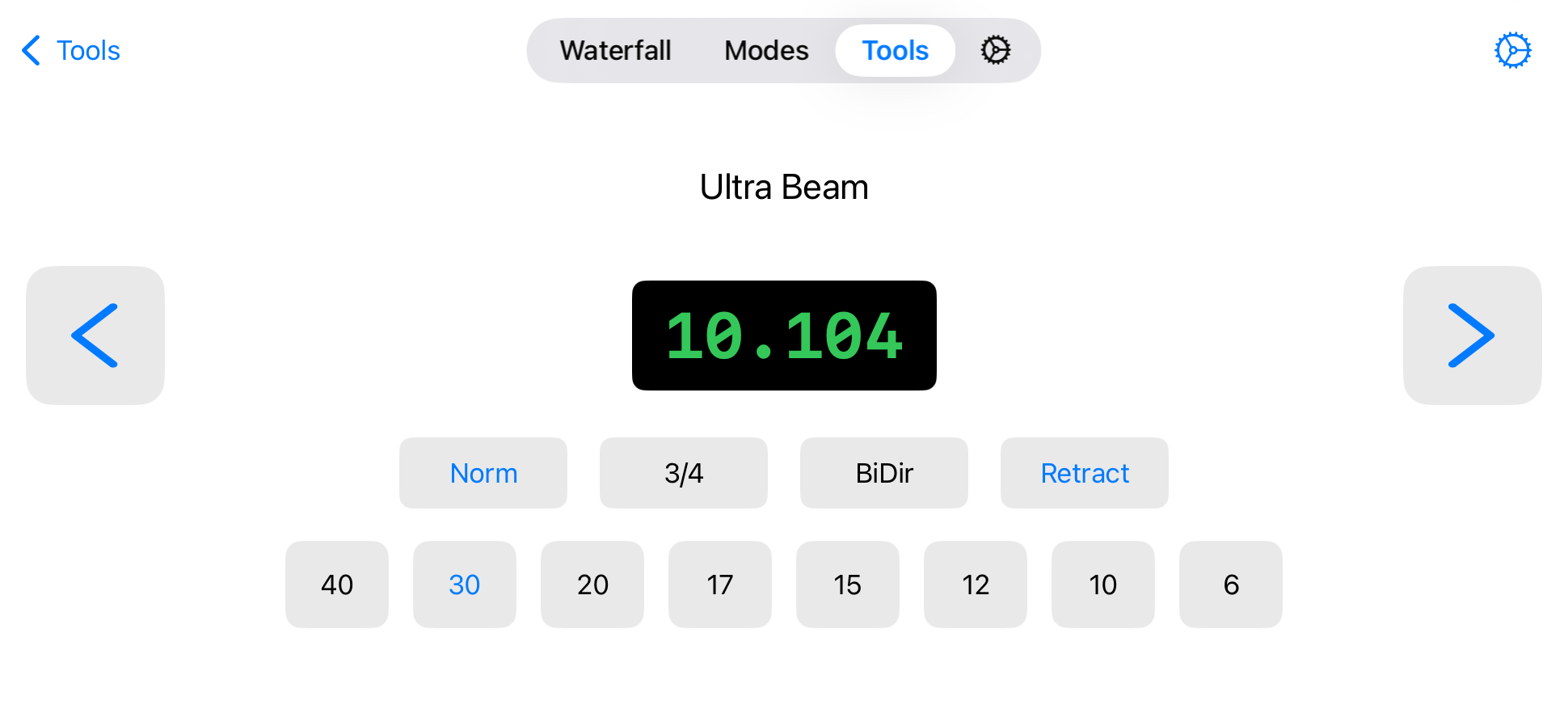
11.1. Requirements
To utilize this feature, you need an Ultra Beam RCU-06 Control Unit and the UltraBeam Remote Controller software installed on a Raspberry Pi.
To set up this tool, hit the settings icon at the top of the interface.
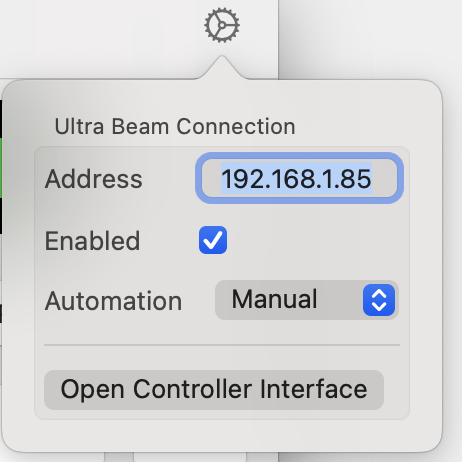
Here, input the IP address of your UltraBeam Remote Controller (the Raspberry Pi).
To test the IP Address, click the Open Controller Interface button to access the Controller’s web interface.
The ‘Automation’ section offers three options: ‘Manual’ allows you to control the frequency of your Ultra Beam directly from the main Tool screen. ‘Follow RX’ or ‘Follow TX’ will automatically adjust the frequency based on the current RX or TX frequency, respectively.
To control the frequency on the main Tool screen, simply hit one of the Band buttons or hit the frequency display at the center to manually enter a frequency. You can also adjust the frequency in 5 kHz increments by hitting the buttons to the left and right of the frequency display.
You can also remote-access your Ultra Beam over the internet. To do this, open port 80 on your router for the IP address of your Ultra Beam Controller. It is recommended to use a different port than 80 externally, for example, 20001. In this tool, you would then need to enter your public IP address (or a DynDNS name - see the chapter Remote Access for more details) followed by a colon and the port number (20001 in the example).
Note
No CAT cable or CAT connection to the Ultra Beam Controller is required for this tool to function. You can switch radios and still be able to adjust the frequency for the radio you are currently connected to.
For further details, please refer to the Ultra Beam manuals.
12. S.A.T. Controller
This feature enables you to operate satellites using the S.A.T. Controller from CSN Technologies directly within the app.

For more information about this product, visit http://csntechnologies.net/sat
The S.A.T. device is a compact unit that connects to your antenna rotator for elevation and azimuth control, simplifying satellite operations. It features a network interface used by the app and an integrated web interface, eliminating the need for additional cables like a CAT cable.
12.1. Prerequisites / Requirements
Before using the S.A.T. tool, ensure you have:
A S.A.T. device
A compatible rotator, such as the G5500, connected to the S.A.T. device via a cable
The rotator should control your SAT antennas, which are connected to your radio
The S.A.T. device should be set up and operational as described in its user manual. You can skip the section about connecting a CAT cable to the radio, as this is managed by the app and this tool.
Once these prerequisites are met, launch the S.A.T. tool in the app and tap the gear icon to access the settings. Here, you will need to enter the IP address of the S.A.T. device, displayed on its small screen.
Next, press the Enable button. It may take a few seconds for the message “no SAT selected” to appear in the lower status bar of the tool. If the connection fails, perhaps due to an incorrect IP address, an error message will display instead.

12.2. Operating a Satellite
To operate a satellite, tap the “Next Passes” button at the top. You will see a list of satellites currently passing over your location. The color coding indicates the ease or likelihood of establishing a connection. Select a satellite from this list, and the S.A.T. controller will adjust the antenna to point towards it.
After selecting a satellite, a list of its transponders will appear. Choose the desired transponder. Below, the downlink (RX) and uplink (TX) frequencies, including the Doppler-adjusted frequencies, will be displayed.
Once connected to your radio, you can enable the “Enable automatic Doppler Adjustment” setting, and the radio will automatically adjust its RX and TX frequencies based on the satellite’s location and whether it is approaching or moving away from your position. Simultaneously, the S.A.T. device will adjust the antenna’s elevation and azimuth to maintain alignment with the satellite.
To adjust an additional offset for RX and TX, simply click the arrow buttons located to the left or right of the entry field for manually entering an offset. You can set different offsets for RX and TX, or choose either TX = RX or TX = -RX (which is the most common scenario).
The RX and TX offset can also conveniently adjusted using one of the supported Controller such as the CTR2.
For the radio, consider the following settings:
Avoid using Dual Watch (DW) or SAT Mode as external Doppler adjustments are not allowed in these modes on Icom radios. If you need to use DW or SAT Mode, disable the “Enable Automatic Doppler Adjustment” setting. Otherwise, turn off DW or SAT mode, switch to VFO Mode, and ideally turn off the second VFO.
Note
Always select the main VFO and keep it in VFO Mode.
If the downlink and uplink are on the same bands, use Split mode for your operations as it allows quick switching between RX and TX.
If they are on different bands, ensure the main VFO can operate on both bands. For example, if using an IC-9700 and operating on 2m and 70cm, switch the second VFO (Sub VFO) to 23cm to allow the main VFO to switch between 2m and 70cm.
Note
You can always hit the Stop button at the top to halt the S.A.T. device from moving the antenna rotator and tracking a satellite.
You can also enter the name of a satellite and tap the Search button to look for a specific satellite.
12.3. Hints for Operating in FT4
Operating in FT4 is achievable using the S.A.T. tool with doppler correction, alongside the included FT8 Tool in the app. This setup is effective even when the Uplink and Downlink are on different bands and utilize different modes (e.g., 70cm USB for Downlink and 2m LSB for Uplink). To ensure smooth operation, follow the steps outlined above and confirm that the RX and TX frequencies are correctly set. Open the FT8 Tool and switch the band selection to Manual. Then, select the desired mode (e.g., FT4) and press RX. At this point, the modes for RX and TX will switch to Data mode, allowing you to operate in FT4 as usual. The radio will automatically switch to the appropriate band when toggling between RX and TX.
12.4. Manual Rotator Control
If you wish to manually adjust the satellite’s position, move to a specific satellite manually, or simply use the S.A.T. device as a basic rotator controller, tap the Rotator button to open the manual rotator control interface in the app.

From here, you can direct the rotator to move in any direction using the directional buttons or move to a specific elevation or azimuth angle. Additionally, you can store and recall favorite positions on the left side of this screen.
The Ready and Park buttons will move the antennas to the corresponding locations stored in the S.A.T. device.
12.5. S.A.T. Web Interface
The Show S.A.T. button at the top will open the S.A.T. device’s web interface.

12.6. Logging a SAT QSO
When logging a QSO, the app automatically adds three additional fields for SAT operation: SAT Name, SAT Mode, and Prop Mode.

12.7. Remote access
Accessing the S.A.T. device within your local network poses no issues. However, accessing the S.A.T. over the internet requires a VPN, as the internal server of the S.A.T. device needs to be accessible. This cannot be securely achieved by merely opening a port, as you might for a radio. Therefore, if you wish to access the S.A.T. device over the internet, you must set up a VPN and ensuring that your S.A.T. device is reachable from a remote location with the same IP address as if you were at home.
13. Logbook
The included Logbook was implemented with the idea in mind to offer a quick and easy logging feature to this App which should already provide all basic requirements for day to day logging.
You can export (and import) ADIF files to exchange logbook contents with other logbook software.
Note
If you wish to export only a portion of your complete log file, utilize a filter to refine your logbook and enable the Export only filtered Log entries setting under Settings.
After starting the Logbook tool you will see your last logs.
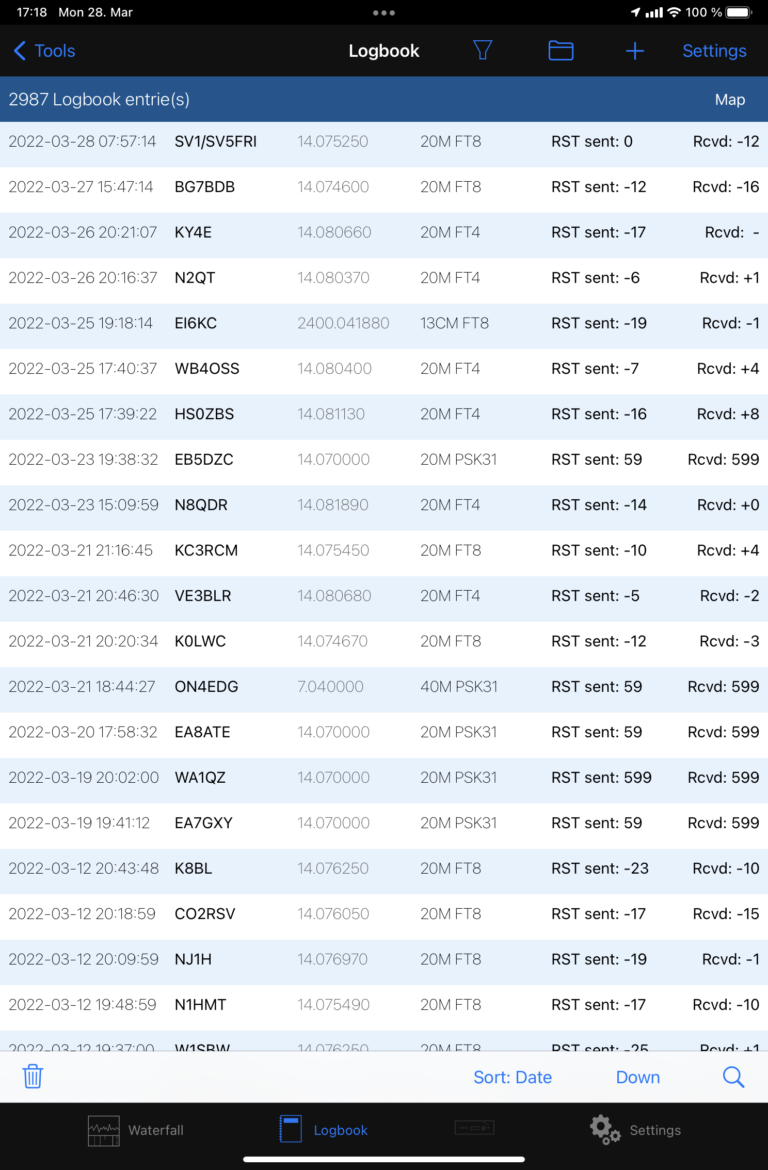
At the bottom, you see a trash-can which can be use to delete the whole logbook if you like and a sort menu. The Spy-glass will open a search field where you can enter a call-sign you are looking for.
To edit an already logged QSO, just tap on a line.
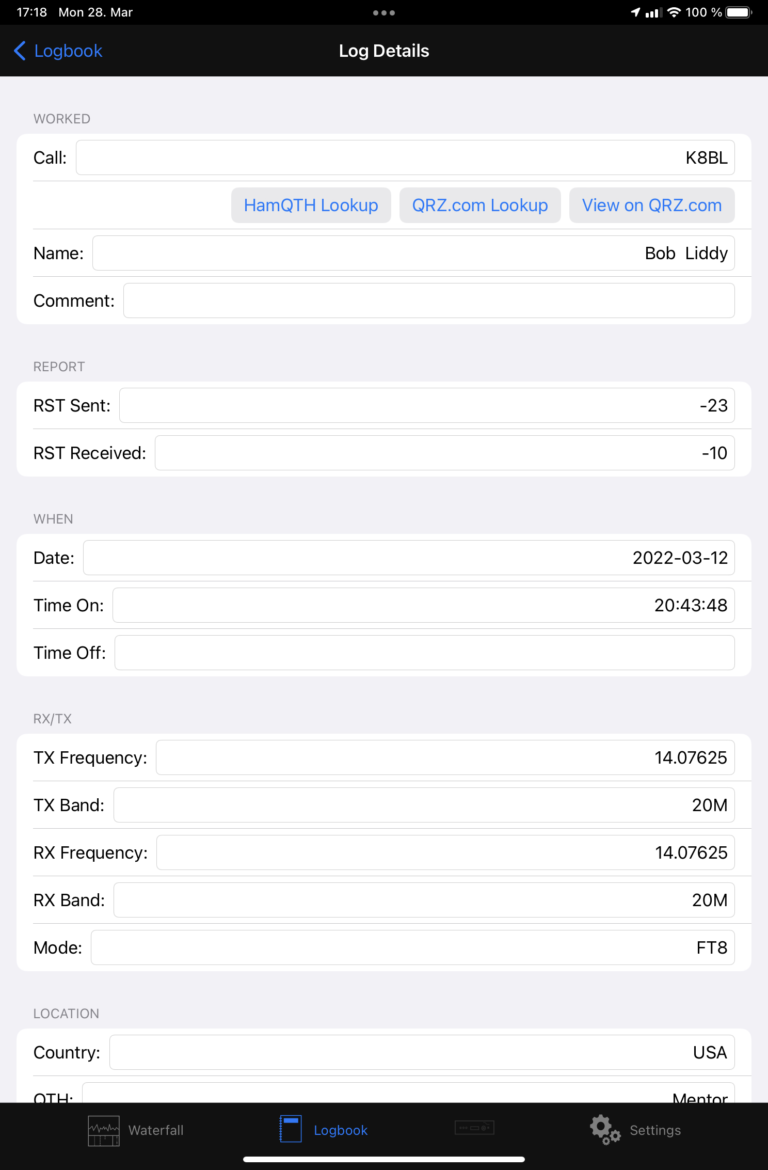
From here, you can alter all fields of the log manually or let them be filled using the HamQTH or QRZ.com lookup feature. For this, just tap on the corresponding button.
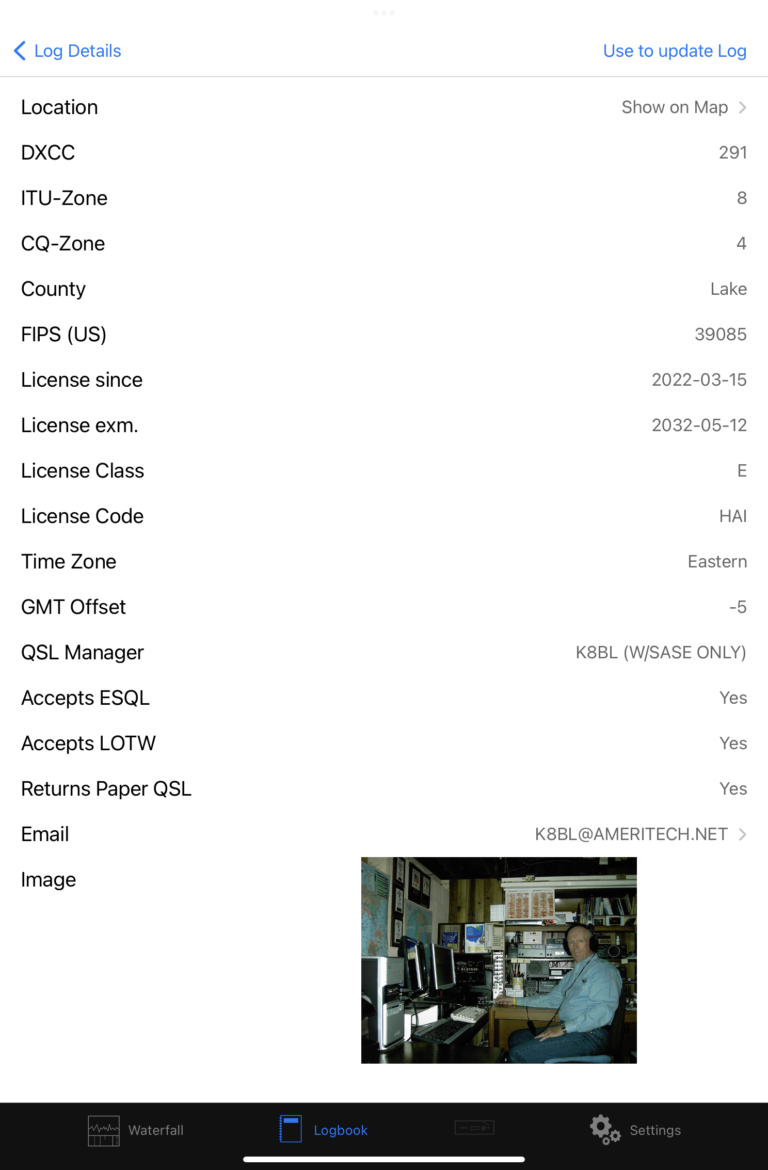
And you will see the details provided by these Call lookup services. Hit the Use to update Log button at the top to take over these values for all empty field of your Log.
There are several settings for customizing the logbook using the Settings button at the top.
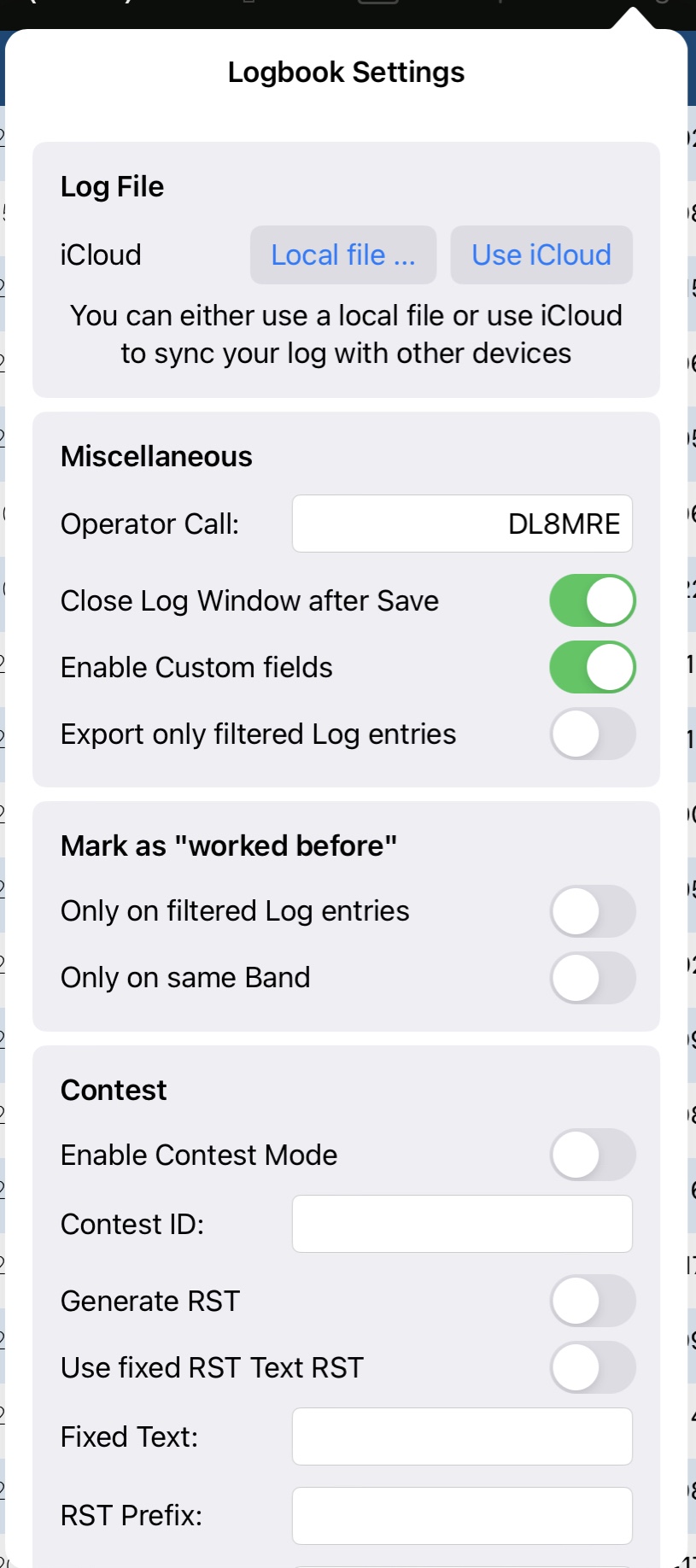
When enabled, your Logbook will be synchronized across your devices. This synchronization uses iCloud Drive which needs to be enabled on your Device and will work even with the Mac Version of this App or the SmartSDR Apps.
Other Tools like the FT8 Tool will display Call signs marked in a different color if you have worked a call before. In the above settings you can define when a Call sign should be regarded as “worked before”.
Under Contest, you can let the logging Tool automatically generate text for the RST entries.
You can also filter the Logbook using the Filter button.
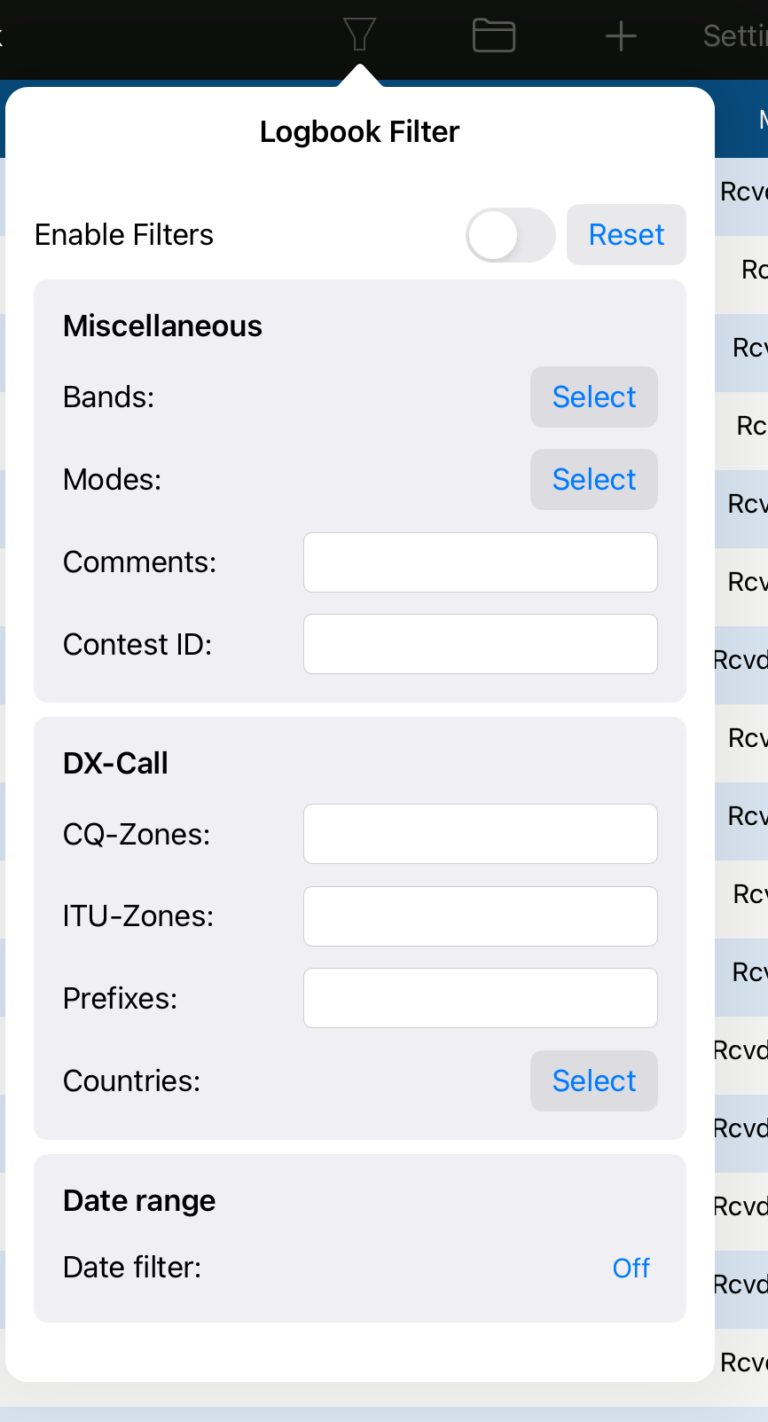
13.1. Logging a new QSO
For logging a new QSO, you have a couple of options:
From inside the Logbook Tool, tapping the + Icon
From View menu of the Waterfall tab and selecting “Log new QSO”
If a physical keyboard is attached to your iPad, by using the Option and L keys
The FT8 Tool will open the logging Window after finishing a QSO (only if auto logging is disabled)
The displayed logging window will be pre-populated with values based on the current VFO:
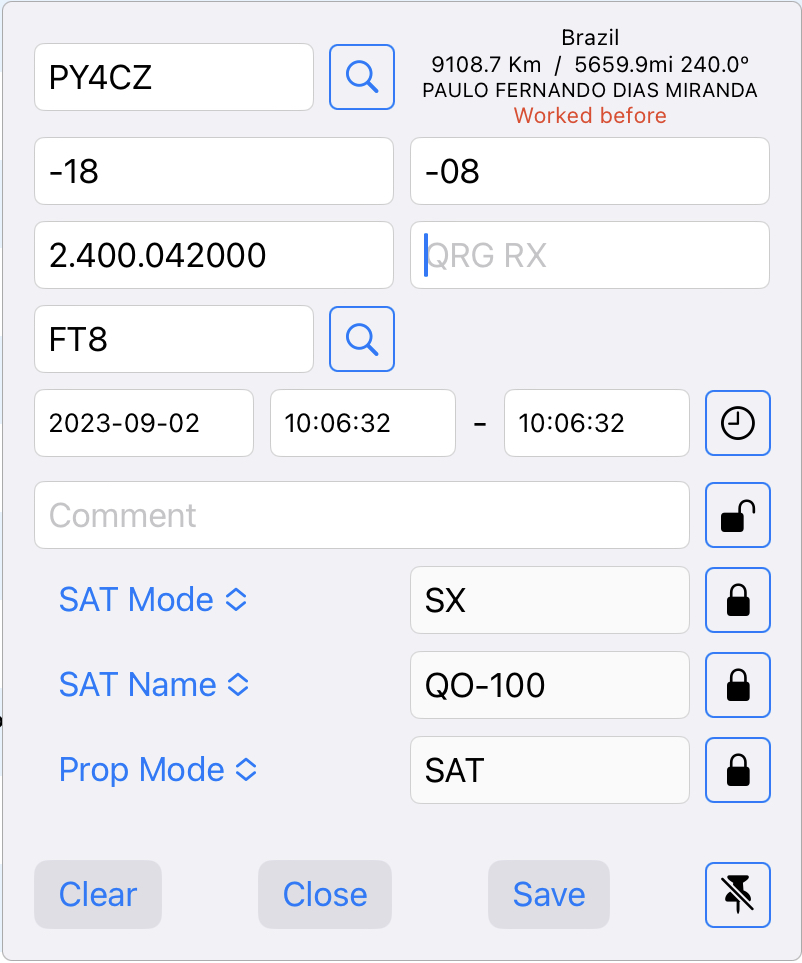
To log a new QSO (Contact), simply enter the call sign of your QSO partner and tap the “Save” button. This action will save the contact details to your Logbook.
To the right of the call sign entry field, you’ll find additional information about the entered call sign, including QTH (location), distance measured in both kilometers and miles, as well as details for both short and long path (LP) calculations. This area also indicates whether the call sign is already present in your logbook.
You can tap the Spy-Glass button for an in-depth lookup of the entered call sign, providing you with further details.
13.1.1. Time Stamps
The QSO Start Time automatically reflects the moment you opened the log entry window. To continuously update the QSO End Time, tap the black clock icon located to the right of the time display; this will cause the end time to update every second.
13.1.2. Field Locking
Certain fields feature a lock icon on their right side. Activating this lock ensures that the information you’ve entered into these fields remains constant, even after saving and moving on to a new QSO entry. This can be useful for information that remains consistent across multiple contacts.
13.1.3. Custom Fields
When you enable Custom Fields in the Logbook Settings, three additional input fields will appear. You can select the appropriate ADIF (Amateur Data Interchange Format) field for each from a dropdown menu on the left side.
Custom fields are especially useful for specialized operations like POTA (Parks on the Air), SOTA (Summits on the Air), SAT-Mode (Satellite Mode), or any other scenarios requiring you to log QSO values that are typically not needed.
13.1.4. Keep the log window open
Located at the bottom-right corner of the screen is a push-pin icon that controls the behavior of the window after saving a QSO. If the push-pin icon is crossed out, the window will automatically close once you tap the “Save” button. If the icon is not crossed out, the window will clear the fields for your next QSO entry but remain open, allowing for quick and consecutive logging.
13.2. Log submission to other Apps via UDP
If you are using your iPad on your local network and want to continue to use another Logging software on your Mac or even your Windows PC, you can use a feature of this App which submits all new log entries to other software via UDP.
This feature can be enabled in the App Setting. If enabled, whenever you are adding a new Log entry, this log entry will be submitted simultaneously to the other Logging program. In addition, there is a “UDP Broadcast” button on the Log detail screen which can be used to submit any older or amended log entry as well.
For UDP Log transmission, you need to enter the IP Address of the PC/Mac where your other Logging program is running and the required UDP Port. If the program is running on the same Mac, just enter 127.0.0.1 as IP Address.
Unfortunately, there are different standards for submitting log entries via UDP. This App supports two different standards:
1.) For N1MM or Log4OM format
This standard is understood by N1MM or Log4OM and others, mainly PC based logging programs.
2.) WSJT-X format
This standard is used by WSJT-X. Every logging software that can receive WSJT-X UDP logging information can be used.
The ports that need to be used for each standard depends on the Logging program. Some will let you enter an individual port number, some have a fixed port number. In any case, the port number used by the logging software needs to be identical to the port entered here.
When clicking the Test button, a sample log entry will be submitted so you can verify if the log entry will be received in your logging program.
13.3. Logbook export
When tapping the Folder Icon at the top you can chose how to import or export your logbook. It is recommended to create export files vie Email or iCloud Drive to keep a backup of your Logbook.
14. Network Stats
This Tool can help to analyze network issues.
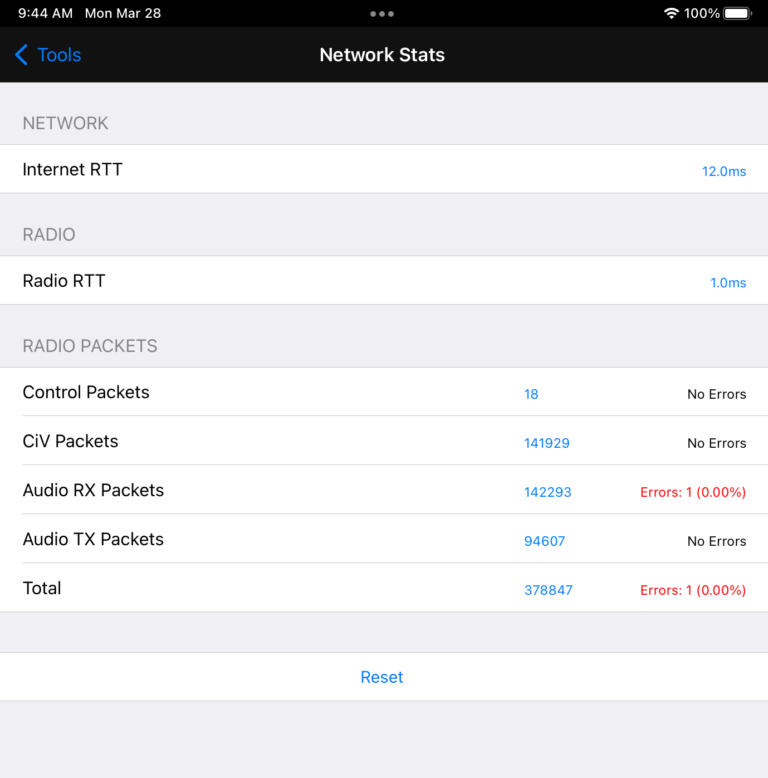
It displays information about the network traffic from and to your Radio.
Internet RTT is the Round-Trip-Time (the time to the server and back) to a server on the Internet. This value should be lower than 30 – 50ms. Higher values indicate general issues with your network connection. However, this value is only important for Call Lookups over the internet.
Radio RTT is the Round-Trip-Time to your Transceiver. These should be below 20ms on local networks. However, this value should always be lower or at least equal than the Internet RTT. If this value is significantly higher (e.g. 1.5 or twice as high as your Internet RTT) there are issues with your local network (e.g. wrong LAN Cables or wrong FullDuplex/HalfDuplex network settings or a WiFi issue in case you are using an IC-705.)
The Radio Packets section shows the number of packets received for certain packet types along with the Error count and percentage.
A certain Error percentage up to 0.05% is normal and usually covered by the automatic error correction and often not even noticeable. Errors may even temporary happen if the device is too busy (e.g. while temporary switching to another App). However, continuous Errors might be an indication of network issues.
You may also want to monitor the Error rate while you are transmitting. If the rate goes up while transmitting, you likely have an EMC / RFI problem.
The Reset button at the bottom can be used to set the error counter to zero which is useful to see if there are any changes after changing some settings.
In case of Network issues, please consult the Common Issues section of this Manual.
15. Call lookup
The Call lookup Tool can be used to learn more about a certain call-sign.
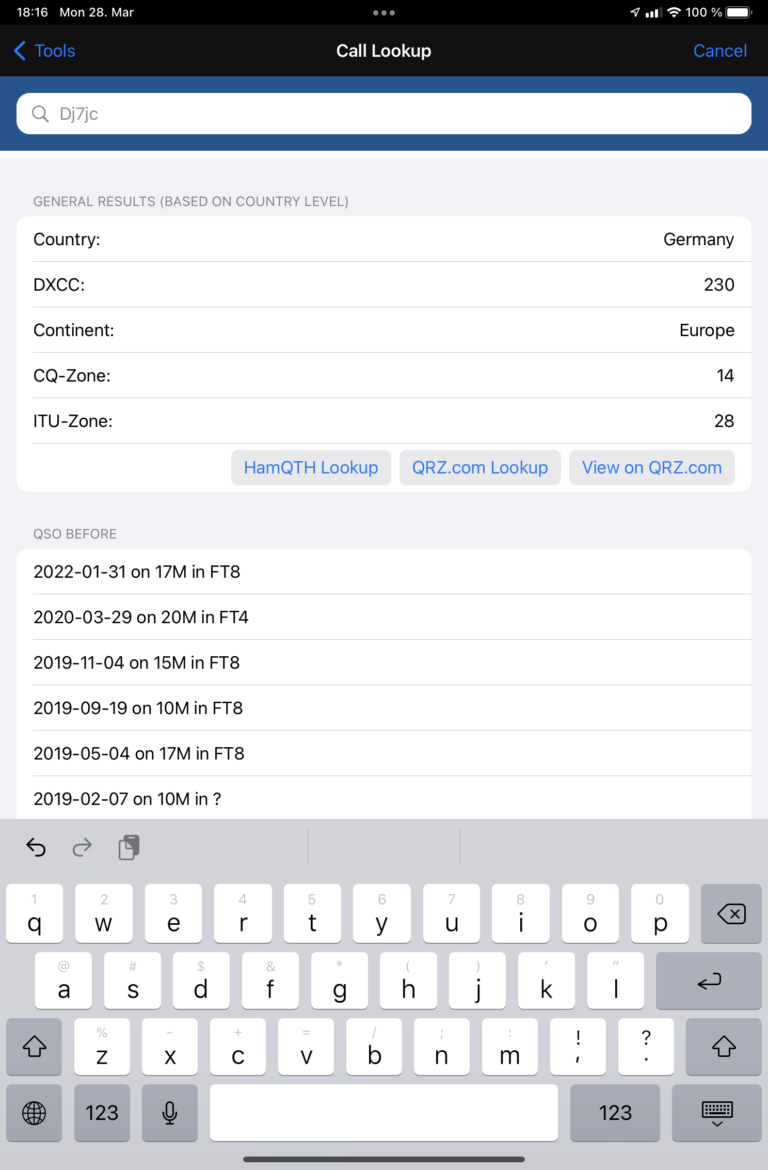
After entering the Call-sign in the top entry field, Basic information like Country, DXCC, CQ- and ITU-Zone will be displayed immediately. This information comes from an internal Database of the App which will be updated from time to time.
Note
This information is only accurate down to a country level. The location within a country will always be the location of the capital city of the country.
Further below you will get a list of previous QSOs to the entered Call-sign.
For more accurate and detailed information like the name, exact location or even Email address, you can use one of the integrated call lookup services like HamQTH or QRZ.com. If you have an account on one or both of these services, please enter your account information in the App Settings. In that case, you can use the HamQTH or QRZ.com lookup buttons for best results and most convenient display. If you don’t have accounts for these services, you can at least use the View on QRZ.com button which will show the QRZ.com website for the particular call-sign.
Once you have used the call lookup using HamQTH or QRZ.com, the results in the upper part will be updated.
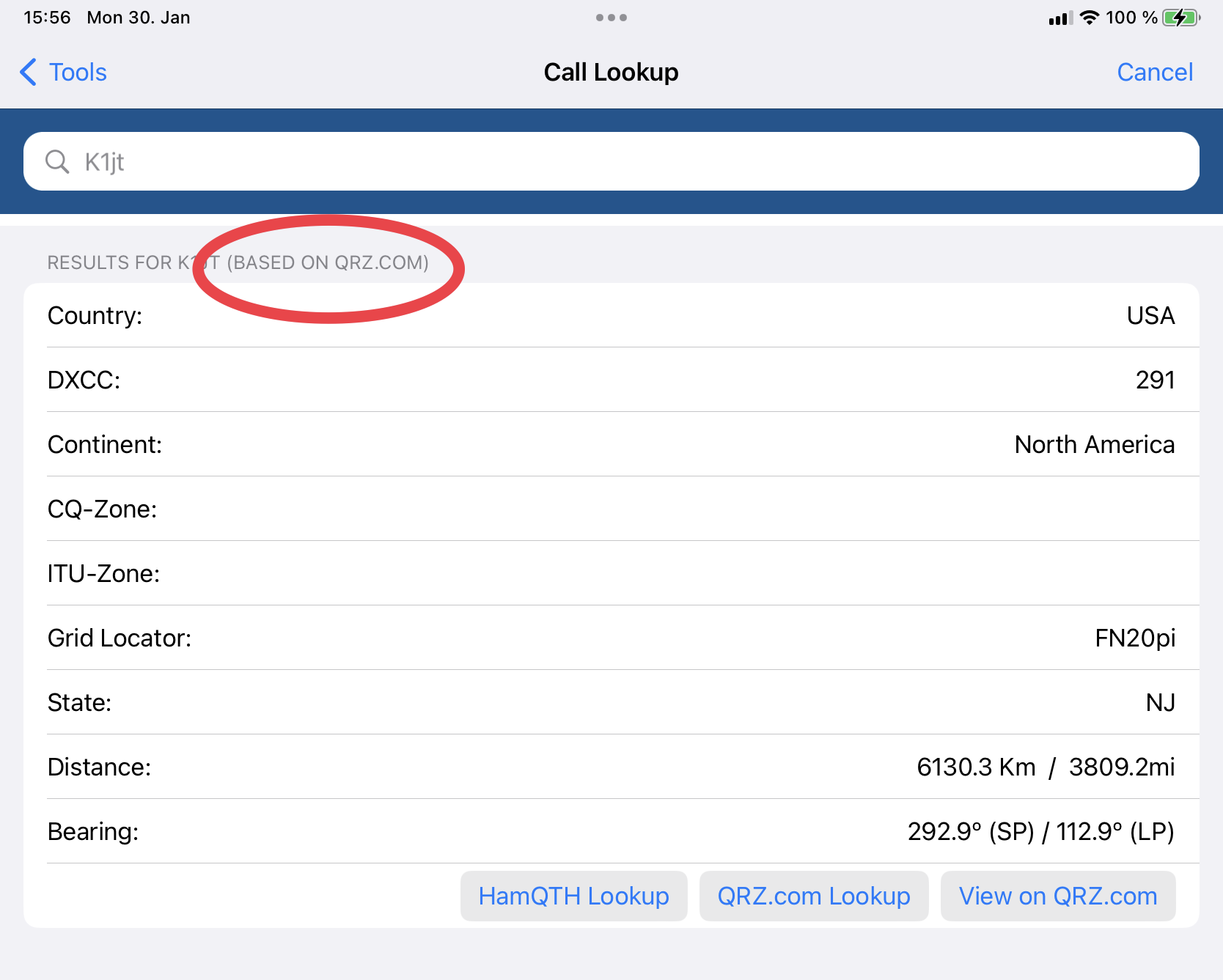
This also includes Distance and Bearing.
16. Memories
Besides the Memory Panel (View Menu → Memory Panel) which is meant for quick memory access, you can use this tool to browse or maintain your memories.
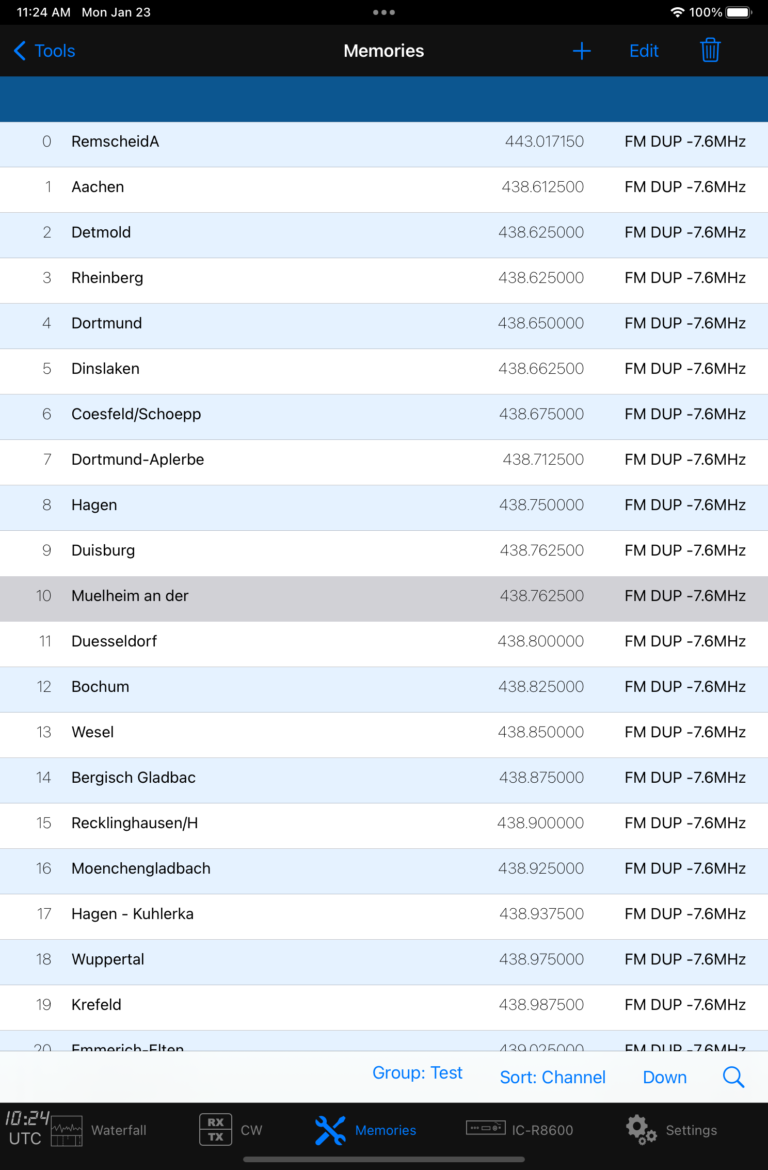
Once this tool has been opened, it will load all memories stored inside the Radio to show them in a list.
You can single tap to tune to a certain memory. Double tapping will also cause the screen to switch to the waterfall.
At the bottom, you can change the sorting and sorting order. If your Radio offers the possibility to use memory groups, you can select a memory group here as well.
Note: If supported by your Radio, you can maintain Memory Group names under the IC-xxxx tab at the bottom.
To edit the name of a memory, just select an entry in the list and tap edit at the top.
To add a new memory, just use the + button at the top. The next free channel will be selected and the current frequency and mode settings can be stored using a desired memory name.
17. Scanning
This tool enables users to scan various frequencies. Apart from Memory Group scanning, it runs the Scan on the Radio and compiles the results which will be displayed in a list.
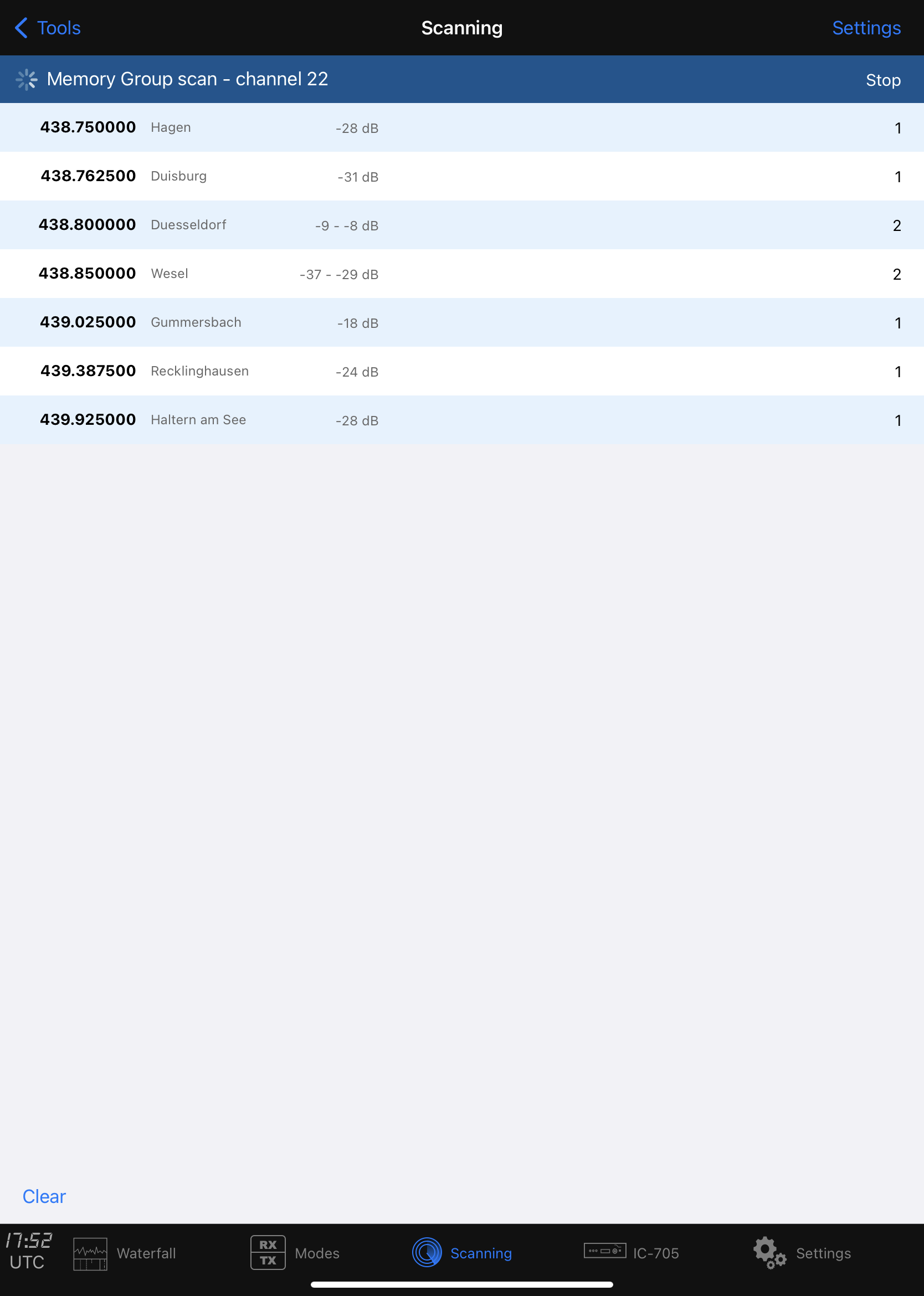
Under Settings, you can define which type of scanning should be performed. Scanning begins after hitting the Start button.
While scanning, all frequencies where a signal was received will be added to the list, including it’s memory name (if available) the number of hits and the minimum or maximum signal strength.
Important
You can also run a Memory Group scan, even though Icom doesn’t provide this possibility for remote access. In this case, this Memory Group Scan will run from inside the App. For this reason, scanning speed is only one channel per second. If you have access to the Radio, you can run a fast Memory Group scan by selecting Memory as Scan type in the Scanning tool, hit the Start button but then start the desired Memory Group Scan at the Radio’s front panel.
Hint
You can mark Memories with Stars (*,**,***). To Scan only Memories marked with Stars, you can select Memory as Scan Type and select the corresponding Stars below the Scan type.
Clicking on a line in the list will stop scanning (if it was running) and tune to the corresponding frequency.
18. FS2M Keyer
The FS2M Keyer tool allows you to use a CW Paddle with your iPad.
Note
Only Paddles are supported; Straight-Key or bug are not compatible. Also, to use a Paddle with this App, it is essential to have a stable network connection to your Radio. Therefore, this tool can be used only on your local WiFi network. Cellular connections or external WiFi connections over the Internet have latencies and network jitter that prevent generation of a stable CW keying.
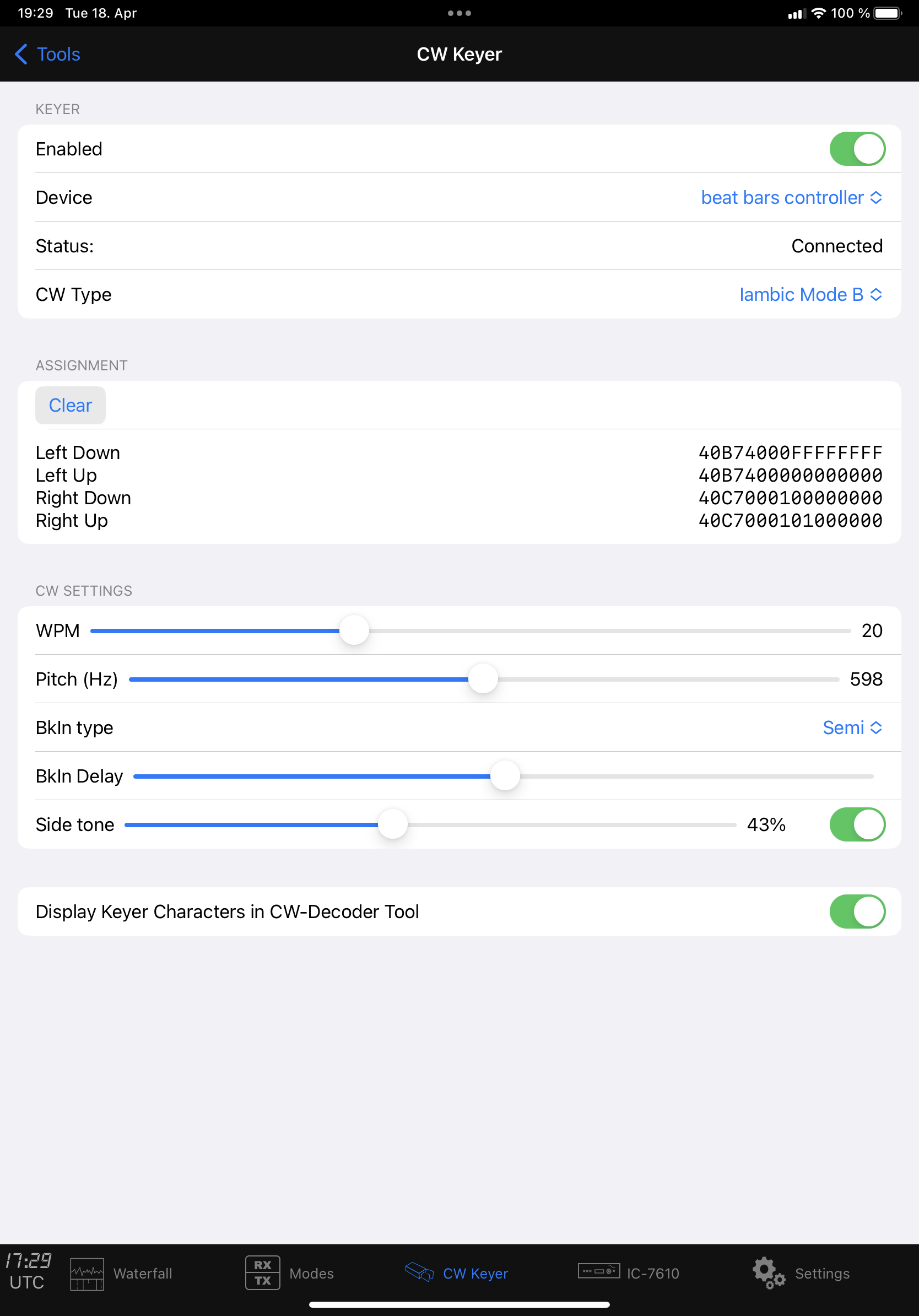
To connect a CW Paddle to your iPad, you need a MIDI adapter. Although other MIDI adapters may work, the following FS2M Footswitch MIDI adapter would be one option:
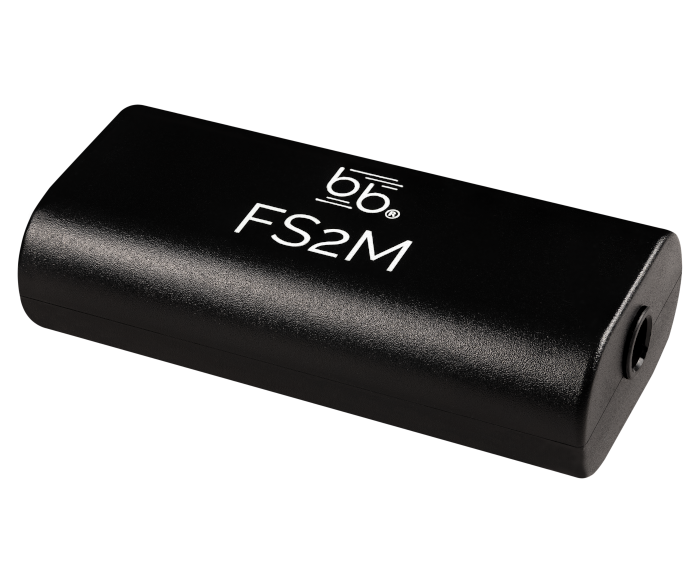
This adapter can be bought here: https://beatbars.com/en/footswitch-to-midi.html
The Micro-USB socket of this adapter should be connected to your iPad. Depending on your iPad model, you will need a USB-A to USB-C or USB-A to Lightning adapter. If using a Lightning adapter, you may need extra power. For the USB-C adapter, no extra power is required.
The other end of the Footswitch should be connected to your Paddle.
No extra software is needed to use this adapter.
Once the adapter is connected this way, select “beat bars controller” as Device and switch Enabled on. Next the Status should change to Connected.
To assign each paddle to key your Radio, hit the Clear button and press the paddles in the following order:
Left paddle down
Left paddle release
Right paddle down
Right paddle release
You should see the values appearing on the right side under ASSIGNMENTS
Note
If you are using a different MIDI adapter, you can assign it in the same way. The values on the right side are just the values sent from the adapter when pressing or releasing a key. This way, you can also swap paddles if you like by simply pressing them in the opposite order.
Once you are connected to the Radio, you can access the CW-Settings section to change various settings like the speed (WPM), Pitch and others.
Using the Breakin Type (Bkin type) Semi works better than On (full break-in).
When the setting Display Keyer Characters in CW-Decoder Tool is enabled, the Tool tries to decode your CW keying and displays the results in the CW-Decoder tool as you would have typed them in via keyboard.
1. Modes
The Modes tab will be visible once you are connected to a Radio. It includes tools for operating in certain modes like CW or FT8.
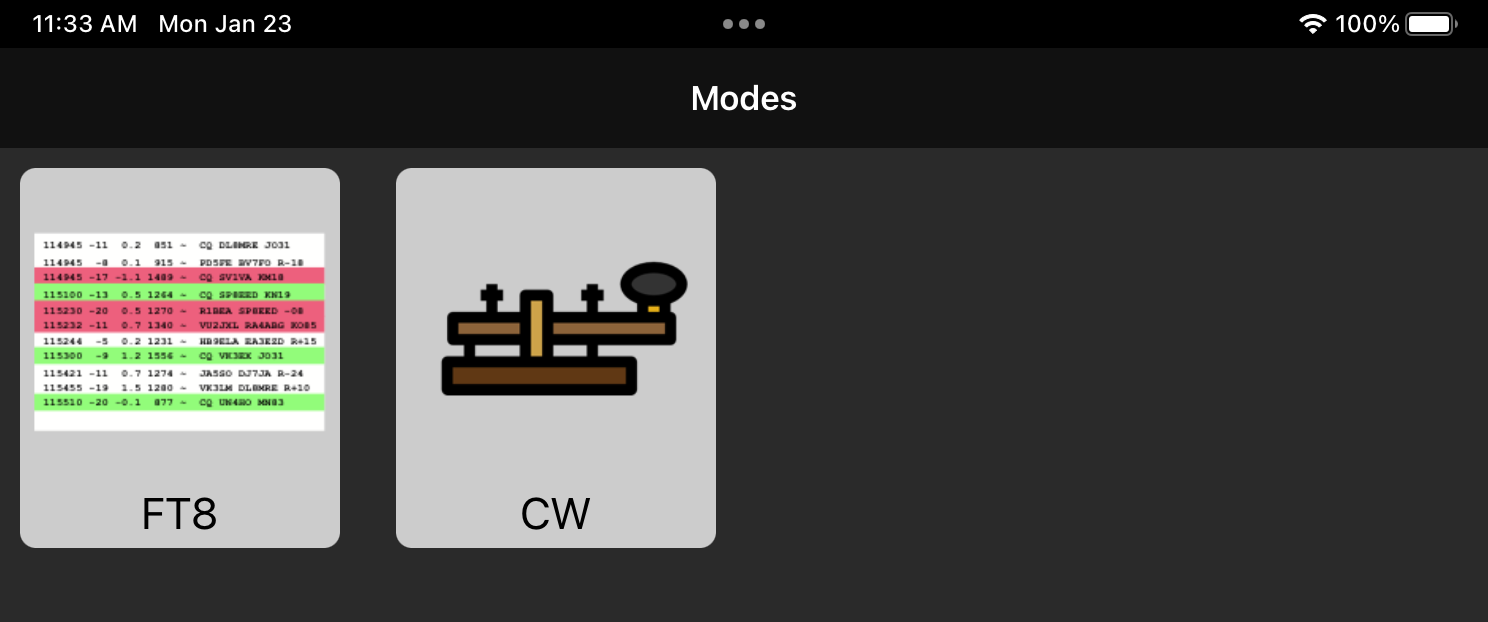
2. FT8
This tool allows to use and operate the popular FT8 and FT4 mode, invented by Nobel prize winner Joe Taylor, K1JT.
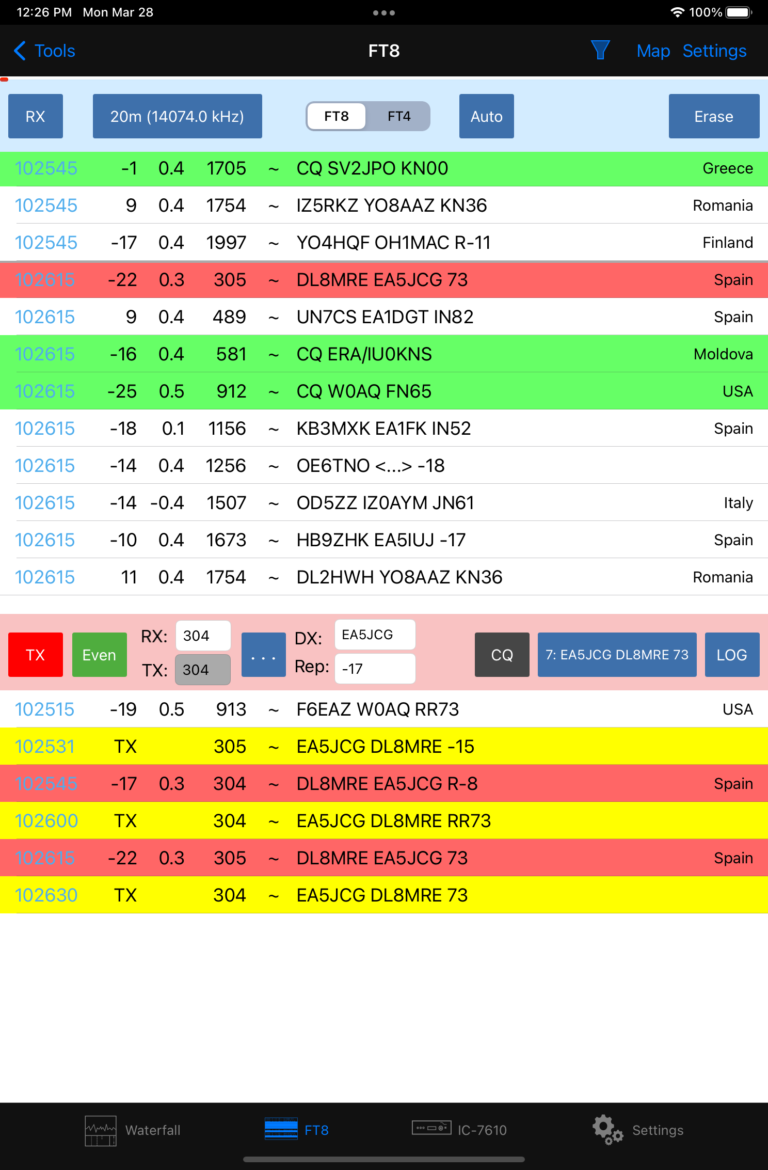
The screen above shows a typical FT8 QSO.
2.1. Foreword (please read)
I had the pleasure of meeting Joe in Dayton in 2019. His lecture was the catalyst for me to prioritize the integration of this feature into my SmartSDR iOS App. Grasping his method for encoding and decoding FT8 messages was a learning curve, involving a deep dive into FFT (fast Fourier transformation). I’m proud to say that all my Apps now boasts a comprehensive FT8/FT4 Tool.
We owe a debt of gratitude to Joe Taylor , the architect of this exceptional mode.
2.2. Requirements / Features
So far, the App only supports FT4 and FT8. Also, no Contest or DX-Pedition mode is supported. It just supports standard QSO’s which are about 95% of all FT4 and FT8 QSOs.
The App supports AUTO mode to automatically generate answer messages based on received messages. It also supports Auto Logging and prompts to log a QSO with all entries pre-filled based on the recent QSO. Worked before Calls will be marked to prevent working them again. CQ Calls will also be displayed on the Waterfall just like DX-Cluster Spots.
2.3. How to use
My approach was to offer FT8 with minimal or no configuration and operation effort. If you are already familiar with WSJT-X, you will immediately know how to operate in FT8 with my App. If you have never worked FT8 before or found it too complicated, just read the following basics and you should be set.
My hope is, to encourage more HAMs to join this fantastic new way to get in contact with each other by providing a simple and easy to use FT8 tool. Even if you found FT8 too complicated in the past, just give it a try with this tool. No cable fiddling, audio interfaces, strange settings or CAT commands.
Just open this tool and start your first FT8 QSO.
2.4. A few FT8 Basics
A typical FT8 QSO starts by somebody (say K1CQ) calling CQ, next somebody like you (say DC1ME) is answering. Both will then exchange their signal reports and optionally end the QSO by saying 73.
Here is how it typically looks like:
Caller |
You |
Meaning |
|---|---|---|
CQ K1CQ EN61 |
K1CQ is Calling CQ. His Grid locator is EN61 |
|
K1CQ DC1ME JO12 |
You are replying to him with your Grid locator |
|
DC1ME K1CQ -11 |
K1CQ responds to you with a signal report |
|
K1CQ DC1ME R-10 |
You, confirming his report and send your own report |
Now, there are two typical options:
Option 1 (the fastest and more common):
DC1ME K1CQ RR73 |
K1CQ confirmed the reception of your report and says best regards. The QSO is done now. No need to respond again |
Option 2 (more polite option which takes longer):
CDC1ME K1CQ RRR |
K1CQ confirmed the reception of your report |
|
K1CQ DC1ME 73 |
You say best regards |
|
DC1ME K1CQ 73 |
K1CQ send his best regards and the QSO is over |
If you would like to call CQ yourself instead, the procedure is the same. Just swap the Callsigns in the above table.
These so-called FT8 messages cannot be longer than 13 Characters. It takes 13 seconds to transfer these messages and they will be exchanged every 15 seconds. Thus, there can be 4 messages per minute. When sending at second zero or 30 it is called “even” or “first”. When sending at second 15 or 45, it is called “odd”.
Besides these aforementioned typical QSO messages, there is additional information that will be added to messages in Contests Mode or DXpedition mode. These modes are not supported by this FT8 tool.
CQ Callers may also add either DX or the desired destination to their CQ message if they just want to get an answer from certain stations.
For example:
CQ DX K1CQ EN61 |
K1CQ just wants to have DX QSOs |
CQ JA K1CQ EN61 |
K1CQ just want to have contact with Japan |
And that’s pretty much it. That’s all you need to know to operate in FT8 with this App.
If you want to learn more, just head to G4IFBs website which includes a fantastic FT8 Operating guide, written by Gary Hinson, ZL2IFB : www.g4ifb.com which is also available in other languages.
2.5. Using the FT8 tool
You can start the FT8 Tool from the Tools menu as usual.
There are two window parts, the Receive window with the blue header and the Transmit window with the red header. Both are explained more in details below.
2.6. Quick start
If you can’t wait and have no time to read further, the following sequence will perform a quick FT8 qso:
Select a Frequency (next of the RX Button)
Tap on RX and wait until the list fills
Double-tap on any of the entries of the list
… and wait, the whole QSO will be completed automatically and ending with the logging window as shown below:
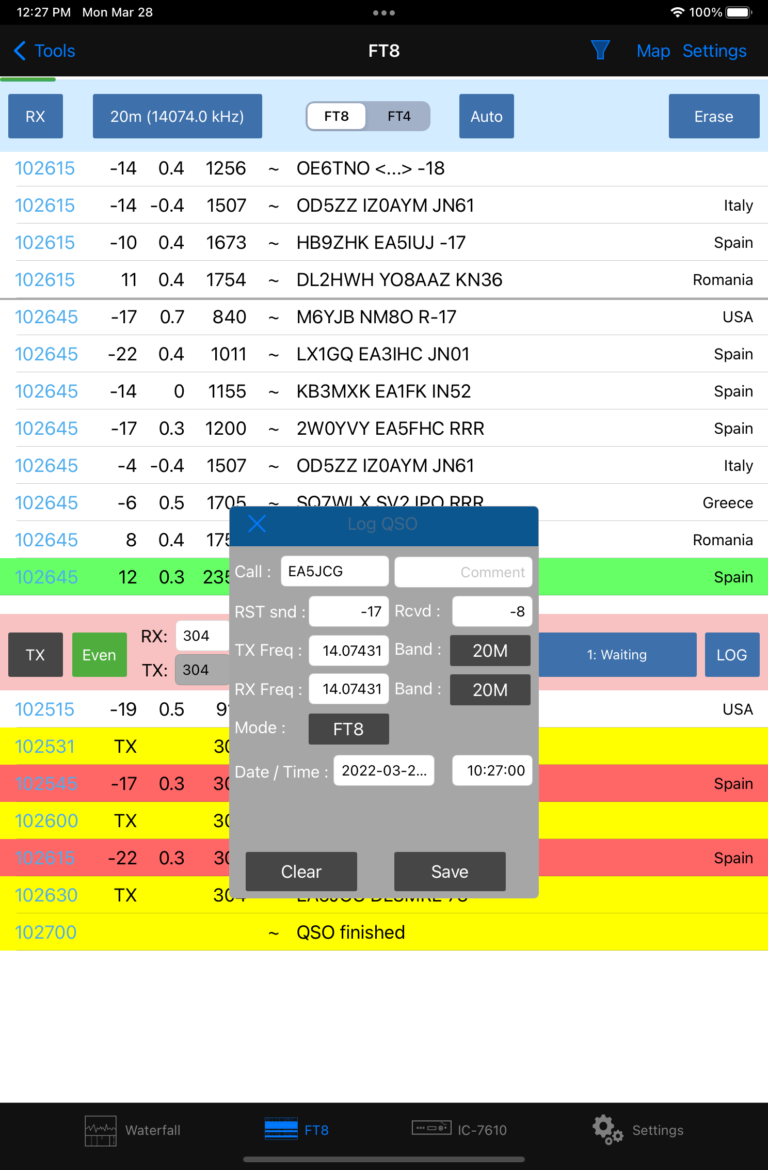
… if all goes well of course. But there can be situations where something goes wrong or you want to call CQ yourself. The following chapters will describe everything more in detail.
2.7. The Receive Window
On the top half you will see the RX window with the blue header.
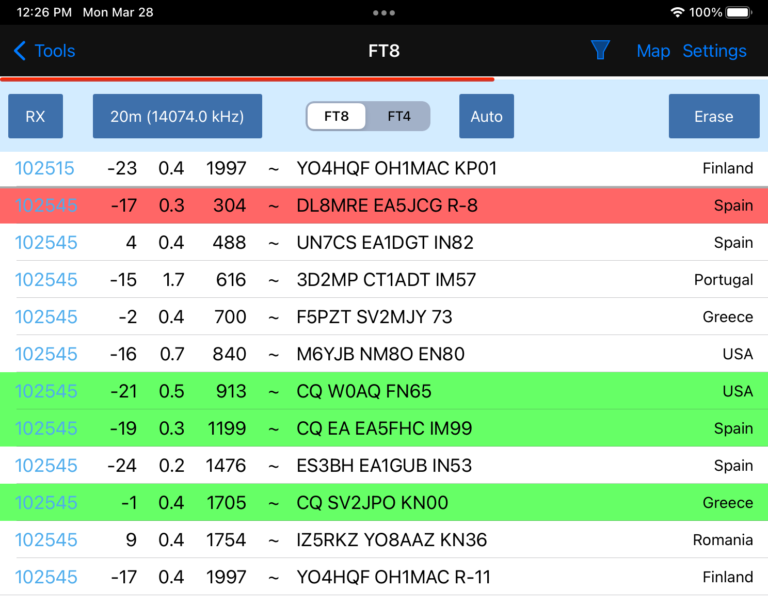
All received messages are displayed on this part of the screen. The following colors are being used:
Green background: Somebody is calling CQ
Gray background: You already worked that station
Red background: your call-sign appears in that message (or you are in TX mode and message was sent on your TX frequency)
2.7.2. The Frequency selection
If you tap on the Frequency selection next to the RX button, you can select the Band or Frequency you want to operate. These Frequencies are fixed and you should only operate on these predefined frequencies.
Note
The frequencies may differ depending on your location so please ensure that you set the correct IARU Region in the Preferences for the location from where you want to operate. Please also ensure that you did set your Callsign and your Grid (QTH) locator in the App Settings.
Hint
If you want to operate on another, not supported Frequency, for example to work DX-Pedition stations, you can always select Manual to tune to any frequency.
Once you hit RX, the Radio will not just tune to the right frequency. Also, all necessary parameters such as Mode, Filter width etc. will be set automatically. So should you accidentally have changed some settings, just tap the RX button twice to get the right settings back.
After at least 15 seconds, you may see the first FT8 conversations in the upper receiving part of the screen.
2.7.3. FT8 / FT4
Use these buttons to switch between FT8 and FT4
2.7.4. AUTO
Because QSOs are standardized in FT8 (except for the two options to finish a QSO either by RRR or RR73), FT8 QSOs can be automated.
Whenever a message has been received, it the App knows which message needs to be sent next.
If you turn on the AUTO button at the top (make it blue), the App will automatically select the next message to be sent depending on the received message (even in case of an RRR or RR73) and sent the appropriate message automatically in the next transmission phase.
If you need more flexibility or want to finish a broken QSO, just turn off AUTO and select the message you like to be send.
If you select Message 9 {Individual}, you can even enter anything else as message which you would like to send.
2.7.5. Filter
On a busy frequency, the receive list can quickly get full and you may easily miss some interesting calls. The App provides a filter, described more in details later, to limit the number of calls in the list. Tapping the Filter Icon will open the filter settings from where you can toggle activation of the filter with immediate effect to the list below.
2.7.6. Erase
Tapping the Erase button once, will clear the TX Window (described below) and all QSO fields like DX and Report. A double-tap will also clear the RX Window.
You may want to use this Button, once you have finished a QSO for example.
2.7.7. tapping on an entry of the list
If you tap on an entry of the receiving list, Frequency, the odd/even setting, the Callsign and dB report will be transferred to the TX Window (see below).
If you would double-tap on the line, in addition, the TX button will be enabled so you will automatically start your transmission at the next odd or even slot.
2.8. The Transmit Window
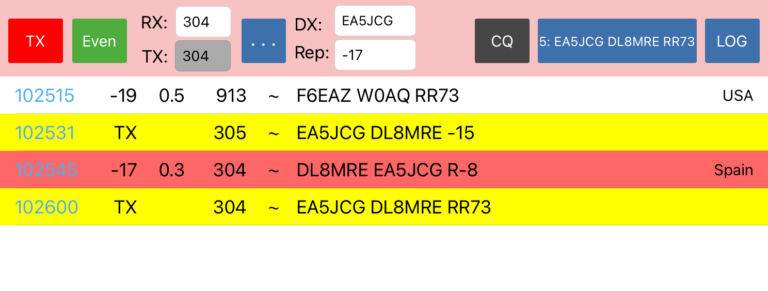
The list in this window contains all your sent messages in yellow and marked with “TX” instead of a dB value.
In addition, it contains all messages that have been received on your RX frequency or messages that are containing your callsign.
This way, you can better focus on your QSO partner and will also see if somebody else is transmitting on the same frequency so you can interrupt your QSO or transmission.
2.8.1. TX
If you tap on this button, transmission will start at the next odd- or even- time slot. If active, the button has a blue background, if you are currently transmitting, the button is red, otherwise it is gray, indicating a listen only mode.
2.8.2. Odd/Even
FT8/FT4 messages can either be sent at an even- or odd time slot. The other station is receiving and transmitting at the opposite time slot. This button indicates your transmission time slot. You can hit the button to change from even to odd or vice verse. If you are not in CQ mode and answering somebody from the receiving list by tapping (or double tapping) on an entry from the receiving list, this button will be set automatically (to the opposite of the calling station you tapped). So normally, you will only need this button if you are calling CQ yourself and want to start calling either in the even- or odd time slot. If the frequency is free, it is common to start in the even slot but that’s up to you.
The colors for odd (green) and even (blue) are corresponding with the colors of the UTC time in the lists.
2.8.3. RX: TX: Frequencies
The two entry fields are used to enter your RX and TX frequency in Hz relative to the Slice frequency. The values usually ranges from 100 to 2900 Hz.
If you tap on a line in the receive list, the frequencies will be taken over from the line you have tapped.
Usually, you may want to transmit on the same frequency where your destination is transmitting. Using the […] button right of the two frequency entry fields, you can either enable or disable TX being equal to RX.
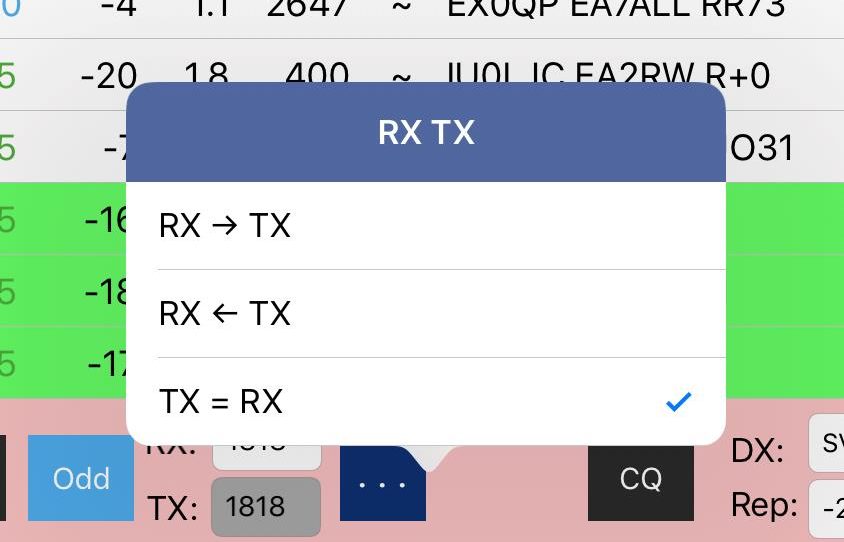
By tapping on TX = RX, the check-mark will be set or removed. If the check-mark is removed you can adjust TX and RX frequency individually. If it is checked, the TX frequency will always be equal to RX. Using the other options here will move the value of one field RX or TX to the other field.
Hint
Using the same RX and TX frequency is the regular operating mode when answering calls. Only if the other station can’t hear you, you may want to use a different TX frequency. On the other hand, when calling CQ you should always open the lock to allow different RX and TX frequencies (Split mode) as you would otherwise “steal” somebody’s frequency when he would answer on a different frequency.
You can also select the FT8 frequency conveniently from the Waterfall by long-tapping at the desired frequency and selecting “Set FT8 TX”.
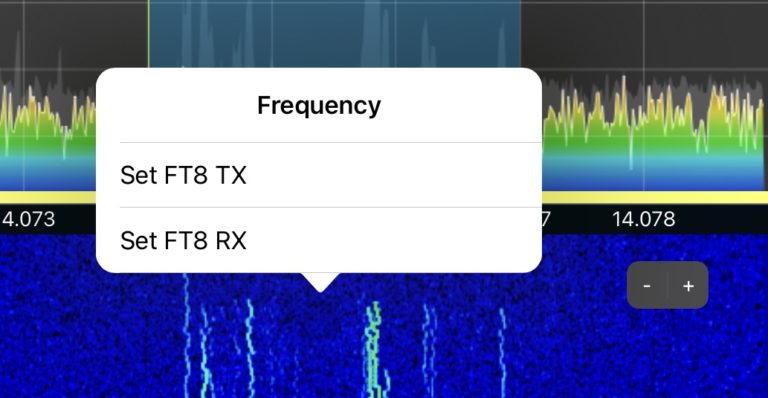
2.8.4. DX
This field is for the Call-sign of the other station and will be pre-filled when tapping on an entry of the receiving list.
2.8.5. Rep
This field is the dB report of the other station which will also be pre-filled.
2.8.6. CQ
Using this button, you can switch between CQ mode or answering mode. A blue button indicates the activated CQ mode.
2.8.7. Message selection
Right from the CQ button, you can select a message which will be sent in the next odd or even slot.
If you are in AUTO mode, you usually don’t need to change this message, only if you are in manual mode or want to correct / repeat a previously wrong interpreted or received message.
The “Short Messages (no grid) will no longer start with the message which includes your QTH locator (grid) and instead starts with the report message.
Note
A FT8 message can only get 15 characters long. If the message gets too long maybe because both call signs have extra characters, the QTH locator will be removed automatically.
2.8.8. LOG
Hitting the LOG button will open the logging window with all fields already pre-filled.
This button is not needed if you have enabled “Auto log after QSO” in the Settings of this FT8 Tool. In this case, the Log window will appear automatically at the end of a QSO.
You could even turn on “Don’t even show Log Window” and the QSO will be logged completely automated without any user intervention.
2.9. FT8 Settings
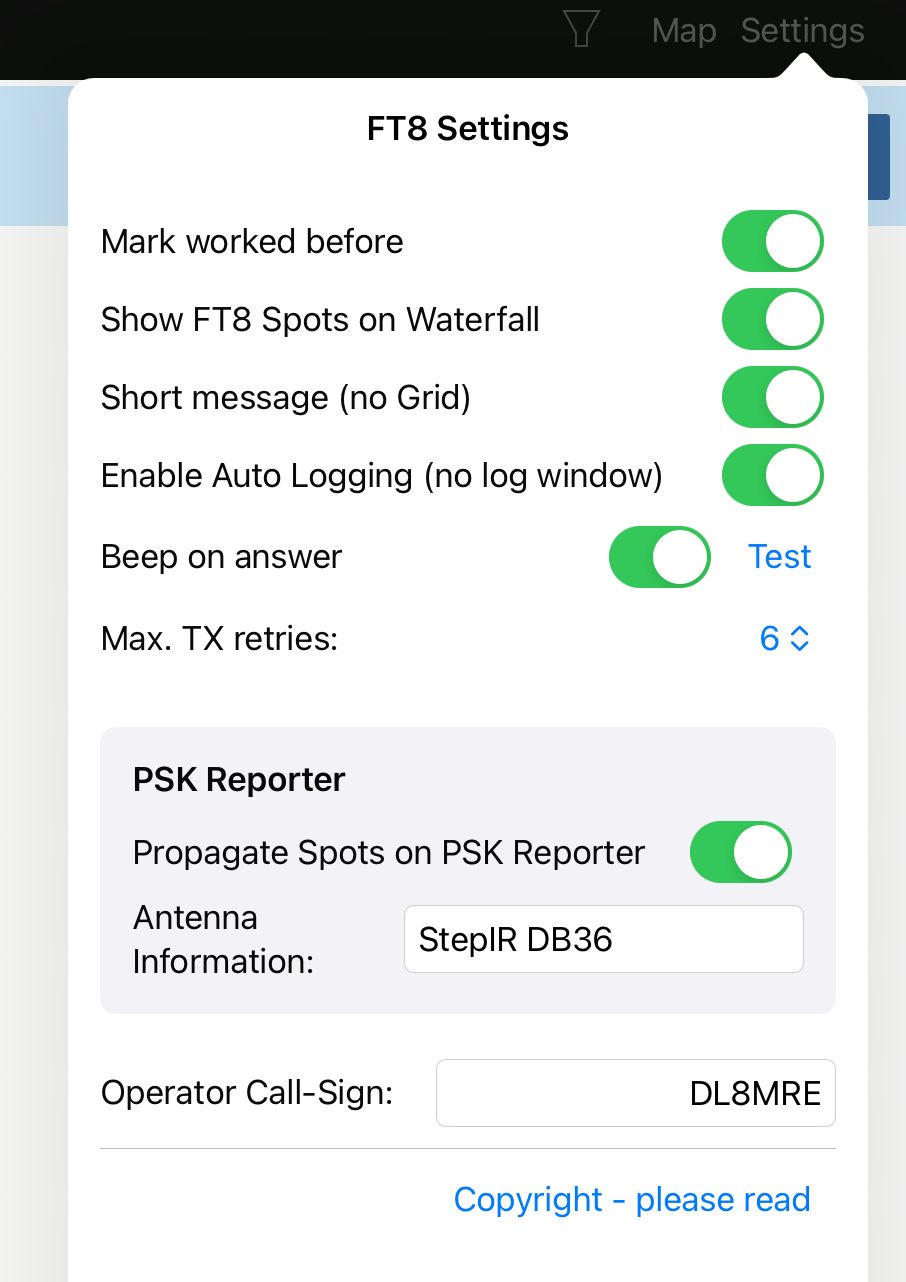
Most of these settings are self explanatory or you can just try them and will see what they do.
When TXing either while answering somebody else’s CQ or calling CQ yourself, the Max. TX retries value defines the number of tries so that you will not end up in an endless loop.
If you would enable Auto Log after QSO and even Auto Log without Log Window, all your QSOs will be logged automated without the need for any confirmation.
2.10. Filter Settings
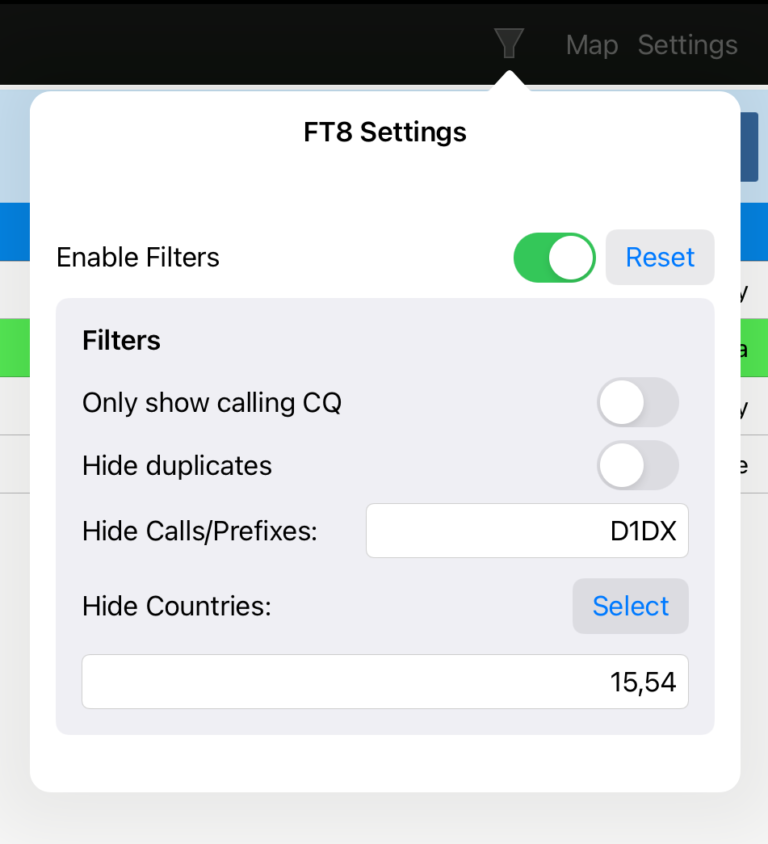
The filter settings help to reduce the number of lines in the receiving list. The filter can be enabled or disabled at the top of this settings screen.
2.11. Using FT8/FT4 for DXpeditions (Fox and Hound)
You can operate as a hound to work DXpeditions (the fox) with this app as follows: First, set the Band selector in the FT8 Tool to Manual and activate Split mode in FT8 by clicking the “…” icon and ensuring the TX = RX option is unchecked. This configuration allows you to monitor the DXpedition’s frequency, typically announced on their website, outside the standard FT8 or FT4 band range. Subsequently, transmit on the frequency where the DXpedition expects to receive your signal. Please note that if the DXpedition responds to your call with a multi-answer message, the app may not automatically log this response. In such cases, you’ll need to manually press the LOG button to log the QSO.
3. CW
This CW Mode Tool can be used to work in CW along with a CW Decoder.
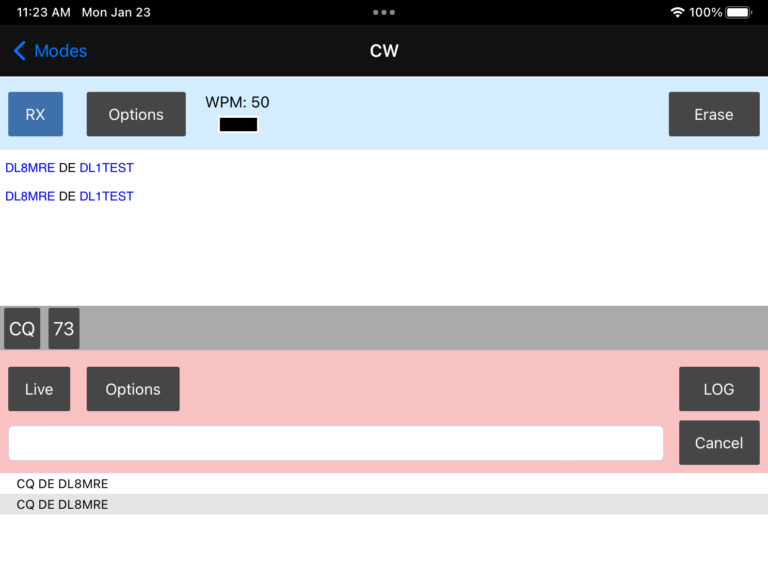
It consists, like the FT8 tool, of a RX section in the upper part where decoded CW will be displayed and a TX section at the lower part.
Once you hit the RX button, CW decoding will start at the currently selected frequency. To optimize CW decoding, you can change decoding options using the Options button in the upper part.
Depending on the noise on the frequency you may see random characters instead of well decoded CW. You can always hit the Erase button to clear the receive section. Hitting Erase twice will also clear the TX section like for the FT8 Tool.
The CW decoder will try it’s best to identify the speed of the other station which will be displayed at the top. Identifying the speed will require receiving at least two characters so the first characters of a submission might get lost or could be wrong. You can prevent this in case you already know the speed of the other station. In this case, you can enter the expected speed as Min. and Max. WPN in the RX Options.
If you have maintained CW Macros (in the Tools section of the App), these Macros will be displayed as buttons just below the decoding section.
The CW TX options can be maintained using the Options button of the TX section.
When Live mode is turned on, everything which is being entered will be sent immediately. If Live mode is off, everything will be sent once you hit the return key.
Each submitted line will be displayed below the entry field. You can click on a line to repeat the transmission of a previously sent line.
You can always hit the Cancel key to cancel any CW submission.
The Cancel key will also hide the keyboard so you will be able again to select the tabs at the bottom to switch between the waterfall or other tools.
Note
You can send pro-signs like BK by using the ^ prefix character (e.g. ^BK). This is only possible when not using the Live mode.
4. WeFAX
This Tool allows to receive, display and store HF Fax or Weather-Fax (WeFax) transmissions often used for submitting weather maps and weather information.
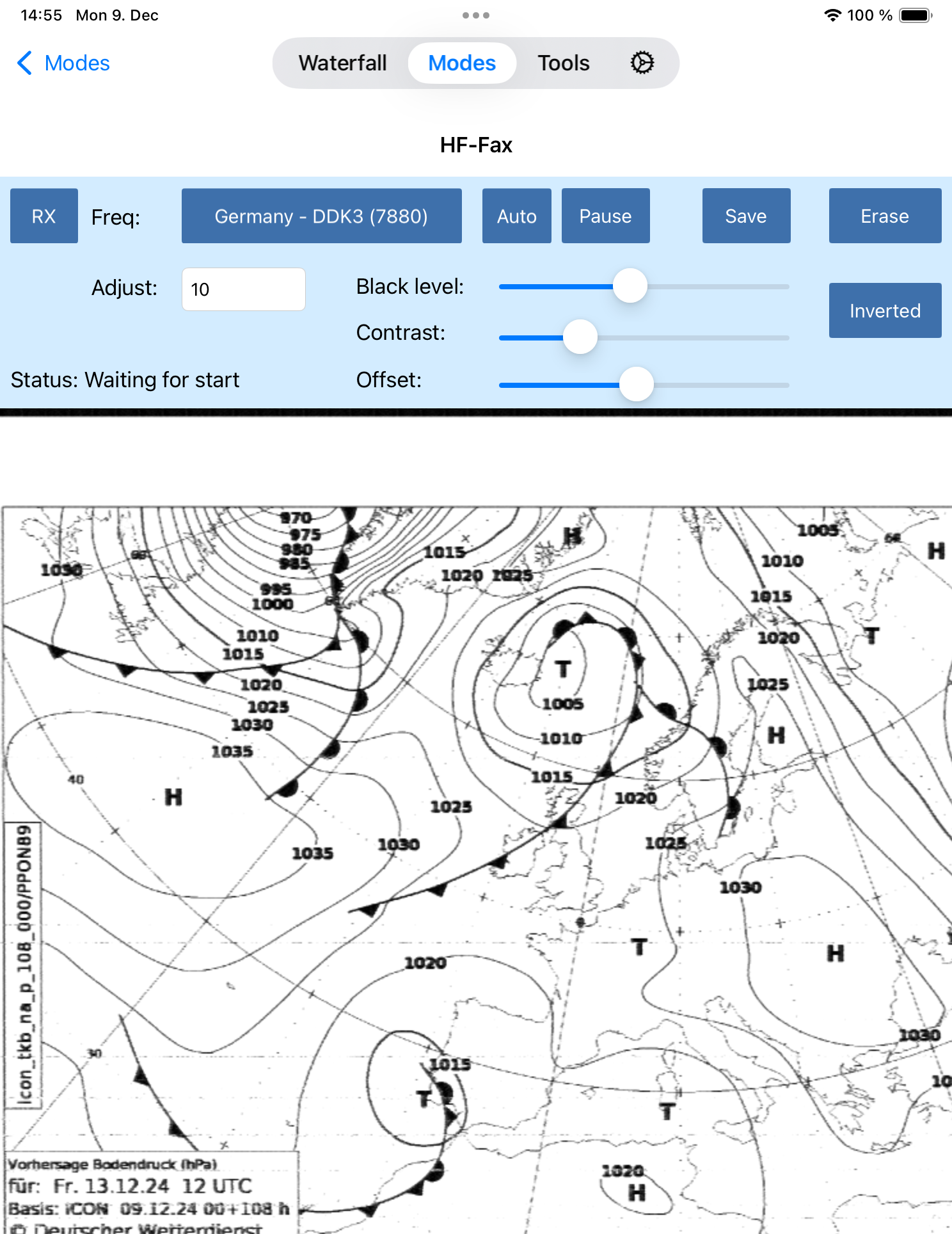
To use this tool, first either tune to the desired frequency manually and select âManualâ for the Freq: selection or select one of the predefined entries of the list.
For these preselected entries, values for RX Offset, LSB and Inverted will be set automatically.
Hitting the RX button will start receiving. If the âAutoâ button is enabled, the Tool will wait for the synchronization signal until anything is displayed. Otherwise receiving starts immediate.
Using the Offset slider at the top, you can adjust the image offset if the start of the image has not been detected automatically.
The Adjust entry field can be used to adjust the slant of the image due to a clock inaccuracy.
The Erase button will clear the received image.
The Save button can be used to save the received image as .png file.
5. SSTV
This tool enables the transmission, reception and storage of Slow-Scan TV (SSTV) images.
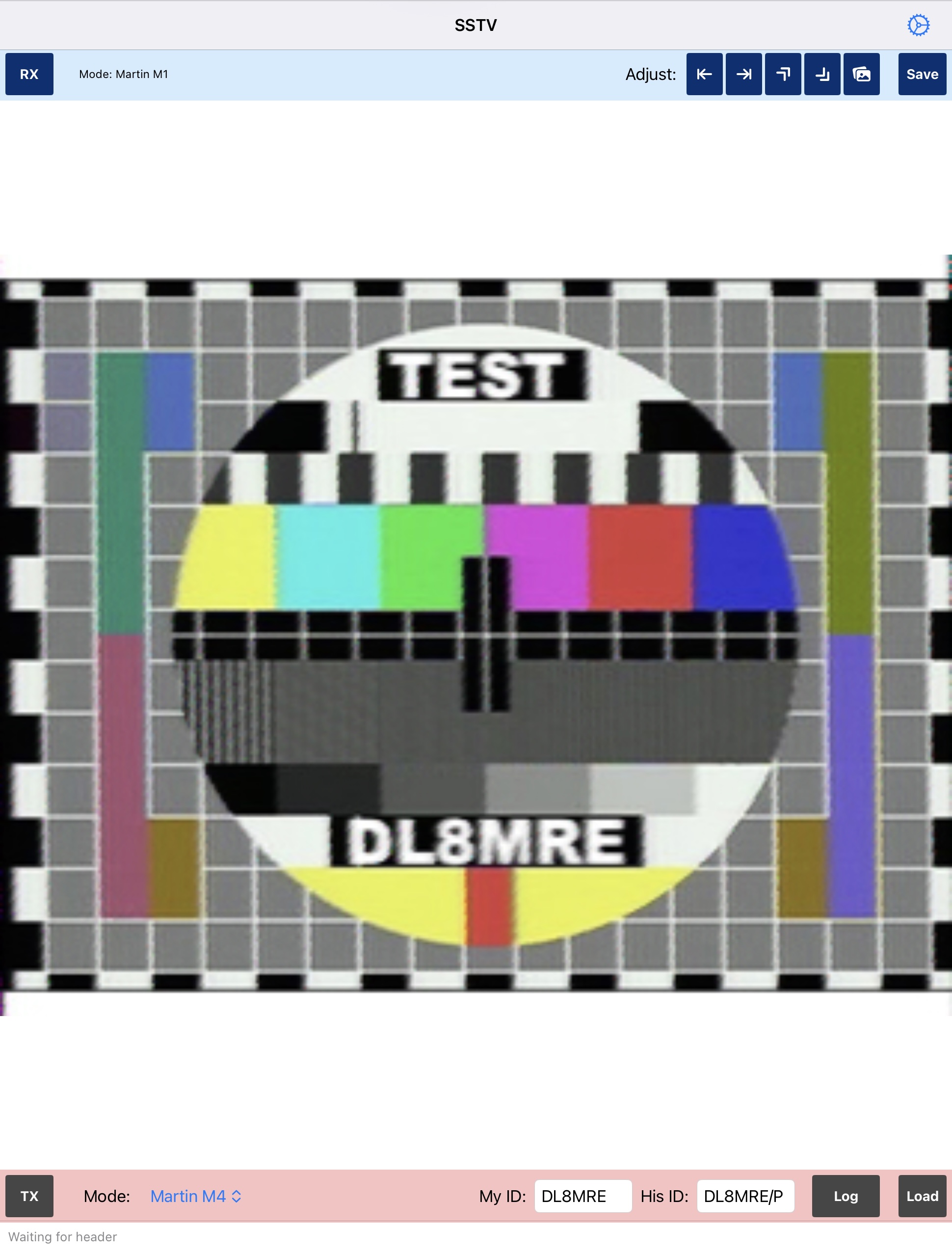
To utilize this tool, tune to a frequency where an SSTV signal is being transmitted.
Hint
The most popular SSTV frequency is 14.230 MHz (USB). Other frequencies include 21.340 MHz (USB), 7.171 and 7.110 MHz (LSB), 3.730 MHz (LSB) in the 10m Band, and 28.680 MHz (USB). Additionally, the International Space Station (ISS) occasionally transmits SSTV on 145.800 MHz (FM).
Change the mode accordingly. It is ideal to select the DATA mode to utilize the maximum filter width.
Pressing the RX button will start the reception process. Once an SSTV header tone is detected, the app tries to automatically identify the mode of the transmission and begins receiving the image, which will be displayed line by line during reception.
Once an image has been fully received, you can adjust the ‘slant’ and offset by using the buttons at the top right side.
The Save button allows you to save the received image as a .jpg file.
To send (transmit) an image, load the image using the Load button, select the desired mode, and hit the TX button.
Hint
Martin M1 and Scottie S1 are the most popular and provide good quality. For quick submissions, try M4, which offers very low quality but doesn’t take very long.
Note
You can add an individual text to the image once it was loaded using the Watermark button at the top. The text can also contain variables such as {CALL} or {RECRST} which will be replaced before the picture will be transmitted. For a list of variables, please see chapter Macro Variables further below in the manual.
It is common to use your own call-sign as FSK ID, which will be transmitted at the end of the SSTV image transmission. For this, your call-sign is pre-populated in the My ID field. Once a picture has been received and a FSK ID was detected, it will be transferred to the His ID field.
Hitting the Log button will open the Logbook entry screen with Mode (SSTV), Frequencies, and FSK ID pre-populated.
The following SSTV formats are supported:
Name |
Size and Color |
Martin M1 |
320 x 256 GBR |
Martin M2 |
320 x 256 GBR |
Martin M3 |
320 x 128 GBR |
Martin M4 |
320 x 128 GBR |
Scottie S1 |
320 x 256 GBR |
Scottie S2 |
320 x 256 GBR |
Scottie DX |
320 x 256 GBR |
Robot 72 |
320 x 240 YUV |
Robot 36 |
320 x 240 YUV |
Robot 24 |
320 x 240 YUV |
Robot 24 B/W |
320 x 240 BW |
Robot 12 B/W |
320 x 120 BW |
Robot 8 B/W |
320 x 120 BW |
Pasokon P3 |
640 x 496 RGB |
Pasokon P5 |
640 x 496 RGB |
Pasokon P7 |
640 x 496 RGB |
PD-50 |
320 x 256 YUV |
PD-90 |
320 x 256 YUV |
PD-120 |
640 x 496 YUV |
PD-160 |
512 x 400 YUV |
PD-180 |
640 x 496 YUV |
PD-240 |
640 x 496 YUV |
PD-290 |
800 x 616 YUV |
Wraase SC-2 120 |
320 x 256 RGB |
Wraase SC-2 180 |
320 x 256 RGB |
1. Setting up an IC-705
It is possible to use your IC-705 in “Station mode” or “Access Point mode”. Both modes are explained in the two next chapters individually.
1.1. Setting up an IC-705 in Station Mode
“Station mode” means that your IC-705 will connect to your local WiFi Network. This is the preferred mode when using your IC-705 at home and this is also necessary for remote access over the Internet.
To setup your IC-705 in Station mode, proceed as follows:
Use the Menu key (Menu > Set > WLAN SET) to check or change the following Settings:
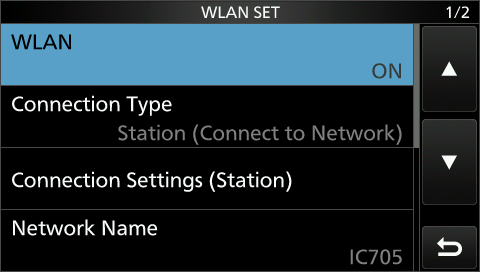
Ensure WLAN is ON and Connection type is Station
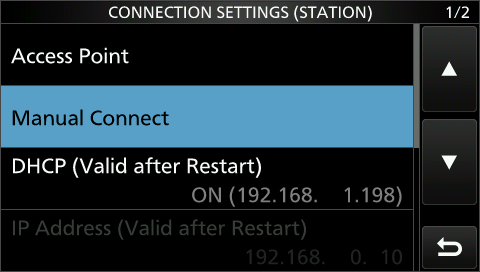
Tap on Access Point to select your own local WiFi network and enter the WiFi credentials to connect.
Ensure DHCP is ON
You may need to restart the Radio at this point if you made changes here. Then revisit this menu.
Once connected you will see an IP Address under DHCP. Take down this IP Address.
Note
This is your Radio IP Address which needs to be used for the Radio setup in the App.
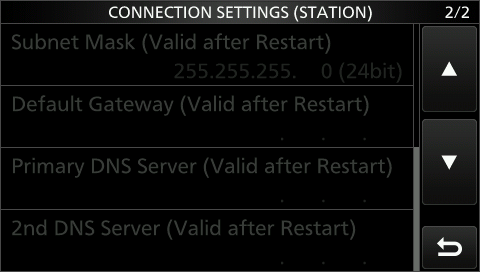
All other settings below DHCP should be grayed out.
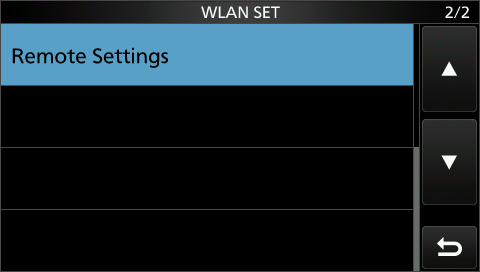
Use the Back button to go Back to WLAN SET
Select Remote Settings
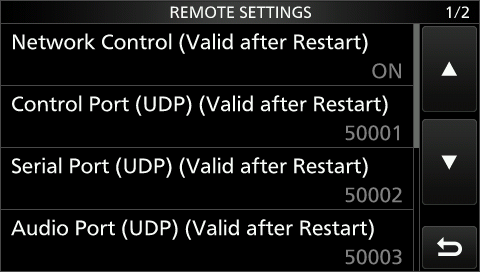
Ensure Network Control is ON.
Verify if the Control Port has a value of 50001.
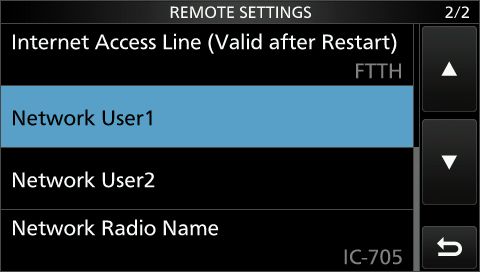
Ensure that Internet Access Line is FTTH
Tap on Network User1.
Now enter a Username and a Password of your choice.
Setting up of your IC-705 is now complete. Now proceed with adding a new Radio to the App based on the information you have collected (The IP Address) or entered (Username and Password) here.
Note
Please keep in mind that you need to restart your Radio if you have changed some settings which are marked (Valid after Restart)
1.2. Setting up an IC-705 in Access Point (AP) Mode
The “Access Point mode” doesn’t require a local WiFi network because the IC-705 creates one on it’s own. You can use this mode for Field Days or whenever you are not at home. However, this mode only allows the App to Connect to your IC-705.
To setup your IC-705 in Access Point mode, proceed as follows:
Use the Menu key (Menu > Set > WLAN SET) to check or change the following Settings:
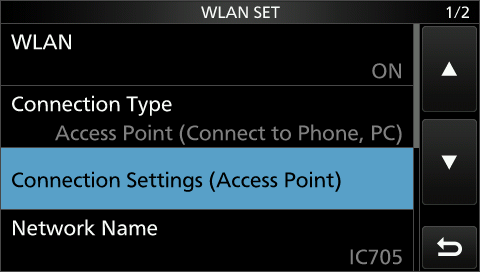
Changing the Connection Type to Access Point
Tap on Connection Settings.
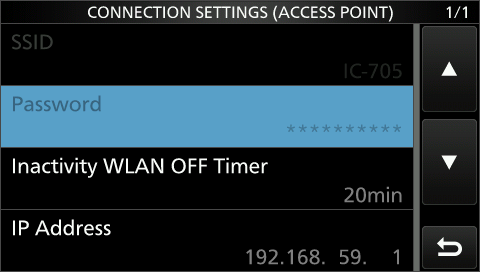
You have to setup a SSID (the WiFi Name) and a Password for your WiFi connection of the IC-705
Note
This is a new WiFi network, don’t enter the WiFi name and password of your current local WiFi network here.
You may need to restart the Radio at this point if you made changes here, then revisit this menu.
Take down the IP Address.
Note
This is your Radio IP Address which needs to be used for the Radio setup in the App.

Ensure Network Control is ON.
Verify if the Control Port has a value of 50001.

Ensure that Internet Access Line is FTTH
Tap on Network User1.
Now enter a Username and a Password of your choice.
Setting up of your IC-705 in AP Mode is now complete.
Important
Now, connect your iPhone or iPad with the newly created WiFi Access Point of your Radio
After you are now connected to your Radio WiFi, you can proceed with adding a new Radio to the App based on the information you have collected (The IP Address) or entered (Username and Password) here.
2. Setting up an IC-9700
Use the Menu key (Menu > Set > Network) to check or change the following Settings:
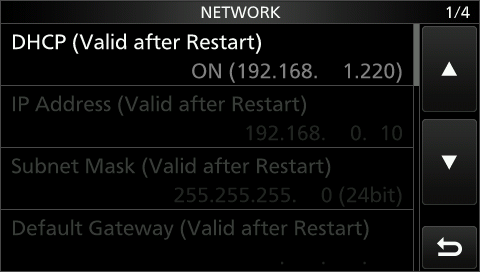
Ensure DHCP is ON and take this IP Address down. All other settings below DHCP should be grayed out.
Note
This is your Radio IP Address which needs to be used for the Radio setup in the App.
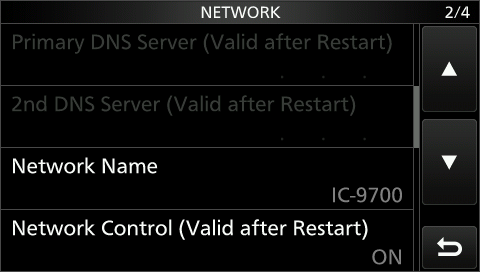
Ensure Network Control is ON.
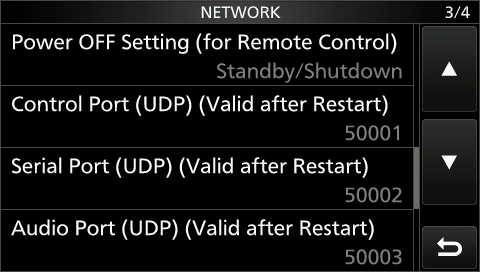
Verify if the Control Port has a value of 50001.
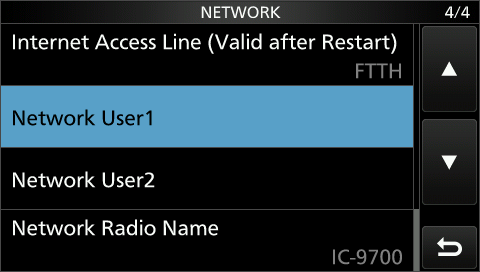
Ensure that Internet Access Line is FTTH.
Tap on Network User1.
Now enter a Username and a Password of your choice.
Setting up of your IC-9700 is now complete. Now proceed with adding a new Radio to the App based on the information you have collected (The IP Address) or entered (Username and Password) here.
Note
Please keep in mind that you need to restart your Radio if you have changed some settings which are marked (Valid after Restart)
3. Setting up an IC-7610
Use the Menu key (Menu > Set > Network) to check or change the following Settings:
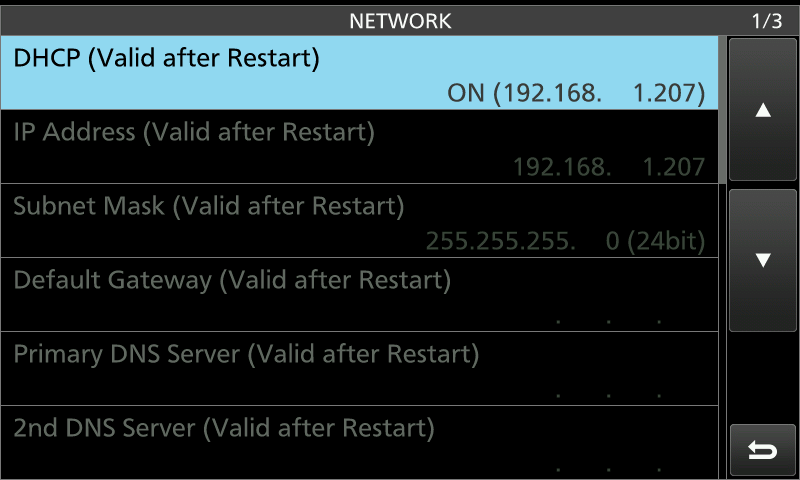
Ensure DHCP is ON and take this IP Address down. All other settings below DHCP should be grayed out.
All other settings below DHCP should be grayed out.
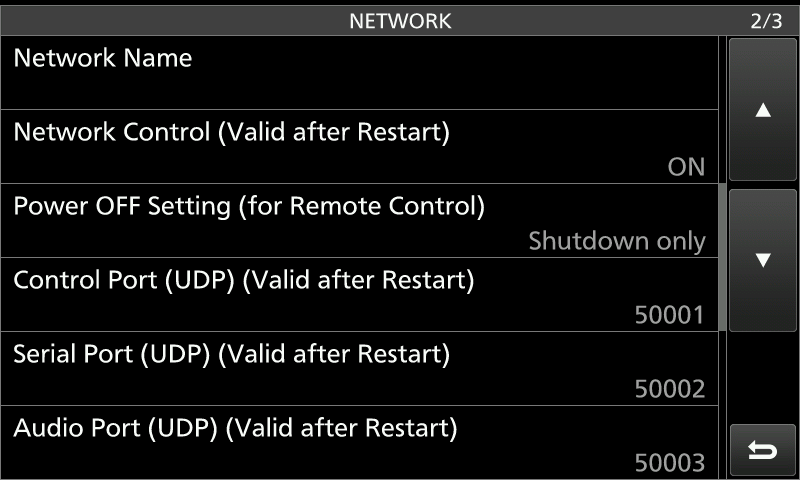
Ensure Network Control is ON.
Verify if the Control Port has a value of 50001.
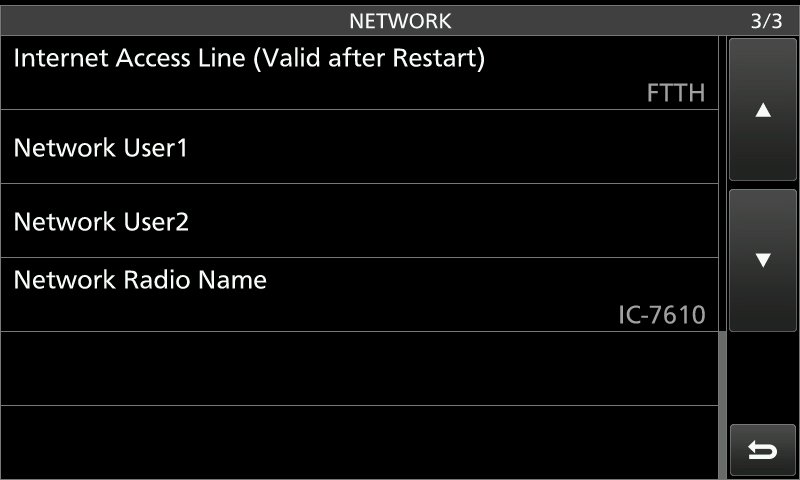
Ensure that Internet Access Line is FTTH.
Tap on Network User1.
Now enter a Username and a Password of your choice.
Setting up of your IC-7610 is now complete. Now proceed with adding a new Radio to the App based on the information you have collected (The IP Address) or entered (Username and Password) here.
Note
Please keep in mind that you need to restart your Radio if you have changed some settings which are marked (Valid after Restart)
4. Setting up an IC-7760
The following assumes that you have your IC-7760 Front panel (Controller) and RF Deck working.
Use the Menu key (Menu > Set > Network > Remote Settings) to check or change the following Settings:
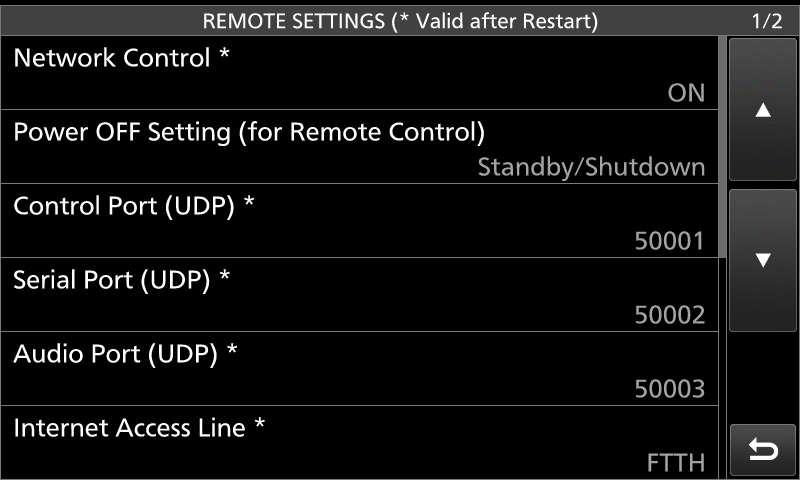
On Page 1/2:
Ensure Network Control is ON.
Verify if the Control Port has a value of 50001.
Scroll down to page 2/2.
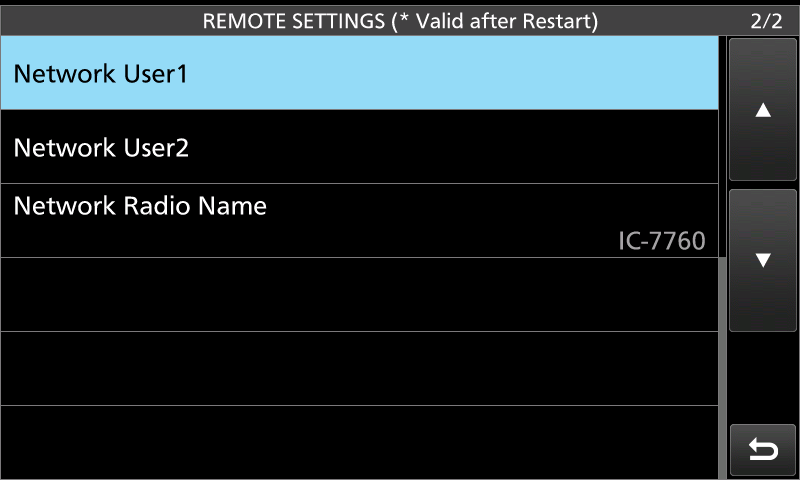
Tap on Network User1.
And enter a Username and a Password of your choice.
Now you need to find out the correct IP Address. The IC-7760 has three IP Addresses, one for the HF-Deck, one for the Controller and one Icom calls LAN. What you need is the LAN IP Address.
One way to find this IP Address is to look up the IP Address in your network router. For this, you will need the so called MAC Address.
The MAC Address for the LAN pf the IC-7760 can be found using Menu > Set > Others > Information.
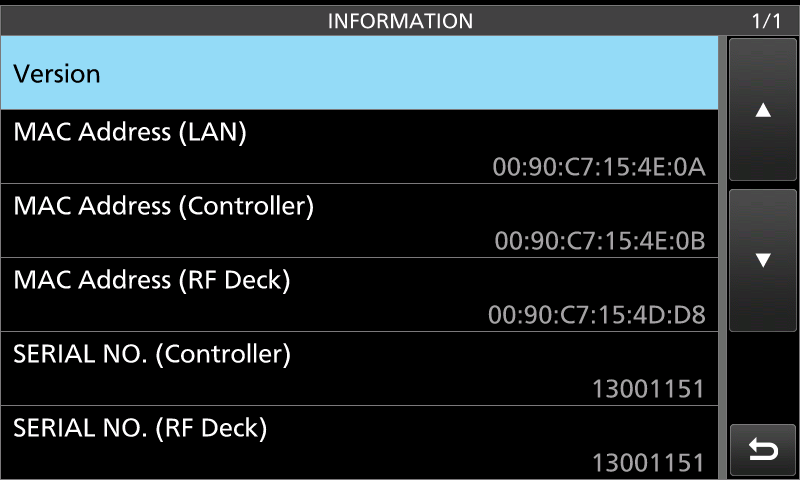
In this example, the MAC Address for LAN is 00:90:c7:15:4E:0A. You can now visit your Routers Configuration Webseite to find the IP Address that relates to this MAC Address.
Setting up of your IC-7760 is now complete. Now proceed with adding a new Radio to the App based on the information you have collected (The IP Address) or entered (Username and Password) here.
Note
Please keep in mind that you need to restart your Radio if you have changed some settings which are marked (Valid after Restart)
5. Setting up an IC-R8600
Use the Menu key (Menu > Set > Network) to check or change the following Settings:
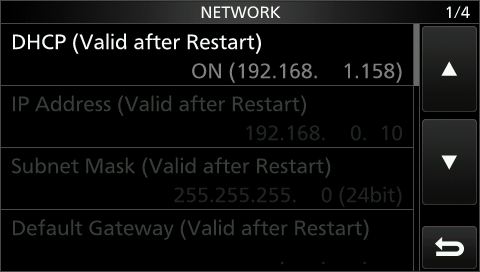
Ensure DHCP is ON and take this IP Address down. All other settings below DHCP should be grayed out.
Note
This is your Radio IP Address which needs to be used for the Radio setup in the App.

Ensure Network Control is ON.
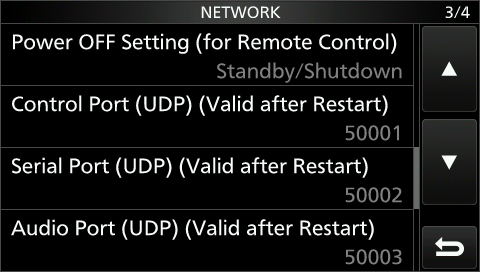
Verify if the Control Port has a value of 50001.
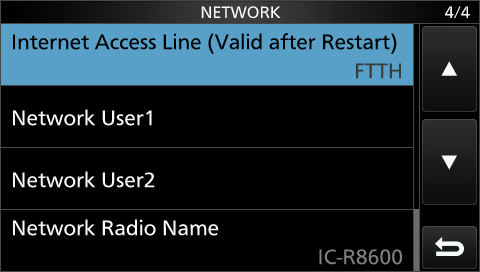
Ensure that Internet Access Line is FTTH.
Tap on Network User1.
Now enter a Username and a Password of your choice.
Setting up of your IC-R8600 is now complete. Now proceed with adding a new Radio to the App based on the information you have collected (The IP Address) or entered (Username and Password) here.
Note
Please keep in mind that you need to restart your Radio if you have changed some settings which are marked (Valid after Restart)
6. Network considerations
Because this App relies on the IP Address of the Radio for connecting to it, it is important to know that IP Addresses may change.
One possibility for a non-changing IP Address would be to manually assign an IP Address to the Radio and not using DHCP.
However, this is not recommended as you may experience problems if you don’t carefully chose the IP Address that don’t conflict with other Addresses on your network.
A better solution is to keep the DHCP (the default) setting of your Radio but instruct your Router instead, to always keep the same IP Address for this device. Unfortunately, there are different terms used for this feature in different Routers. It may be called static-lease or even static-IP so you may want to look into your Router’s manual to find this feature.
Another consideration is to use a secure password. This is especially important if you enable Remote Access as described in the next chapter.
7. Remote access
With this App, it is possible to connect to your Icom Transceiver from outside your home network. For this, you need to let three ports pass your Router to the internet or in other words you need to open three ports in your Router.
Unfortunately, this task will be different from Router to Router so it can only be explained in general here.
The ports in question are the three ports found in your Radio settings under “Control Port (UDP)”, which usually is 50001, “Serial Port (UDP)”, which usually is 50002 and “Audio Port (UDP)” which usually is 50003.
Now you need to access your Router’s configuration website and look for a possibility to open ports in your Router.
Here, you need to open these three ports (50001,50002,50003) to the IP Address of your Icom Transceiver. If your Router want’s to know for which Protocol these ports should be opened, it it only necessary to open these ports for the UDP Protocol. If your Router want’s to know which ports should be used for the inside and which for the outside, you can use the same ports (50001,50002,50003) for the inside and outside. Sometimes you can enter a complete port range like 50001-50003. In some Router you have to open each port individually.
Once this is done, you will already be able to connect your Transceiver from elsewhere but you need to know the IP Address that now needs to be entered when you add your Radio to the App’s Radio chooser.
The IP Address you need is the public IP Address for your network allocated by your Internet Service Provider. You can find out this IP Address in your Router or by visiting one of the whatismyip websites.
However, most likely, this IP Address will change from one day to another. To address this problem, you can use services like https://dyn.com but most likely, your Router also supports additional services. Any of those services will provide you with a unique way to access your Public IP Address which always remains the same. Such an address may look like xxxxx.dyndns.org. Once you have setup everything, you can enter this unique address for setting up your remote Transceiver instead of the IP-Address.
For your convenience, just add another Radio to the “Available Radio” list by using the Add button again. Use a name that differentiates the new entry from your regular local access Radio (e.g. 705 remote), use the aforementioned IP Address and for the other values the same as for your local Radio.
7.1. Testing remote access
For testing, first try to connect to the newly added Radio by still using the home WiFi network. Even though it makes no sense as you could also connect to your Radio directly, it makes sense for testing if Port forwarding and the public IP or dyndns address are both working well. Once you have checked that this is working, try to connect using another network like Cellular or another WiFi.
Important
If you are using an iPhone as Hotspot, you will have to disable “Low Data Mode”, “Private Wi-Fi Address” and “Limit IP Address Tracking” in your Device WiFi settings. This is important, otherwise it will not work.
8. Macro Variables
You can use variables like {CALL} in CW Macros.
These variables will be replaced by values from your settings or log before being sent.
The following Macro Variables are available:
{CALL} |
Will be replaced by the Call-sign currently entered in the Log Window |
{CALLSPELL} |
Will be replaced by the Call-sign currently entered in the Log Window spelled letter by letter |
{SENTRST} |
Will be replaced by the RST Sent value of the Log Window |
{RECRST} |
Will be replaced by the RST Received value of the Log Window |
{NR} |
Will be replaced with the Contest Serial number, maintained in the Settings of the Logbook |
{COMMENT} |
Will be replaced by the Comment value of the Log Window |
{MYCALL} |
Will be replaced by your own Call-sign, maintained in the App Settings |
{TXFREQ} |
Will be replaced by current TX Frequency |
{RXFREQ} |
Will be replaced by current RX Frequency |
{FREQ} |
Same as {RXFREQ} |
{TXBAND} |
Will be replaced by current TX Band |
{RXBAND} |
Will be replaced by current RX Band |
{DATE} |
Will be replaced by the Date entered in the Log Window |
{TIME} |
Will be replaced by the current Time entered in the Log Window |
{ENTER} |
Will send a new-line character |
\n |
Same as {ENTER} |
{NOW} |
Will be replaced by the current time in UTC |
{GRID} |
Will be replaced by your Grid locator, maintained in the App Settings |
{LOG} |
Will cause the current QSO to be logged |
9. Keyboard Shortcuts
If a physical Keyboard is connected to your iPad, you can use Keyboard Shortcuts.
In order to display all available shortcut Keys, just press and hold the Command key on your Keyboard.
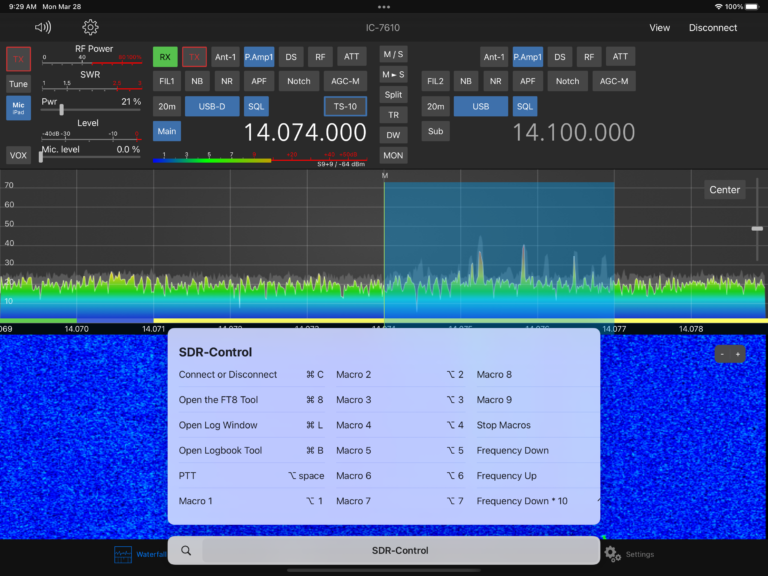
Note
This list can be scrolled horizontally.
Common Issues
App doesn’t connect to the Radio
If you did follow the instructions on how to setup your Transceiver for the App but the App still can’t connect, this can have various reasons.
The most common reason is, that there was a typo in the settings or the instructions were not followed exactly.
Before you start setting up remote access (which means to connect to your Radio from the internet), you should first ensure that a local connection is working reliable. So in this case, have a local setup first and use the Network Stats tool to see if the error rate is below 0.05%. Once that’s the case, start setting up a remote connection as described under Remote Access. That chapter also explains how to test your Remote access connection.
If you can’t connect, you may see an error message. If the error messages states “error 0”, this means your Radio can not be connected at all. So you might have entered a wrong IP Address or the Radio is not connected to your network. An “error 1” usually means you have entered invalid values for the connection (e.g. a letter or space for the port or invalid address)
Below are a few possible causes of connection issues:
Disallowed local network access
One reason could be that you accidentally confirmed the message after a first start of the App to give the App network access with “no”. This can be checked and fixed as follows:
Open the iOS Settings app (gear Icon) on your device.
Select Privacy
Select Local Network on the right side
Search for the App and see if the switch on the right side is on. If it is off, turn it on an try again
Device and Radio on different networks
Another possibility is, that your iPad/iPhone and your Transceiver are not on the same network. To prove that, compare the IP Address of your Transceiver (you did already collect in the Transceiver setup steps) and the IP Address of your iPad/iPhone. You can find this out by opening the Network Stats Tool (Tools → Network Stats). An IP Address consists of four numbers, separated by a . (dot). The Transceiver IP Address and the Mac IP Addresses must both start with the same three numbers. The last number will be different.
So for instance: 192.168.1.4 and 192.168.1.201 would be fine whereas if you have 192.168.1.4 and 192.168.0.10 it would be wrong.
Possible causes are:
Using an old firmware version. Please update your Transceiver always to the latest firmware.
Using a Mesh solution where DHCP is not working correct
Using a so called “guest” WiFi for the Mac and a regular network connection for the Transceiver
Wrong router or iPad/iPhone settings
Cable issues or something else that prevents the Radio from connecting to your network
Wrong CI-V address of the Radio
Besides the settings mentioned in this manual, the Radio has many additional settings that may prevent the App from connecting. One example is the CI-V address. When this was changed, the App can’t connect. You can revert individual settings back to their default values of your Radio (Menu → Set → Connectors → CI-V → CI-V Address, long-pressing on a CI-V Address and select Default).
Issues with the Radio
In case your Radio has issues, you can try to perform a Partial or Full Reset. A Partial reset can be the first choice as this will not wipe your Settings.
Too old Radio firmware
The App is always tested with the latest firmware released by Icom. In case of problems, just double-check if your Radio is running the latest firmware.
Wrong connection of your local network
For a local connection, you need to have your iPad/iPhone connected to your Local network via WiFi. Your Radio need to be connected to your local network in the same way (WiFi for the IC-705 or LAN Cable for the other Radios). Only if you want to use your IC-705 without Internet, you need to have a direct connection between your iPad/iPhone and your Radio (In this case, the IC-705 needs to be setup in AP mode and the iPad/iPhone needs to connect to the AP of the Radio). In all other cases, both iPad/iPhone and Radio need to connect to your local network and not to each other.
DHCP not working when using a Mesh
A Mesh network is usually no good idea as it may cause all kind of network issues or delays. Wherever possible use a LAN (cabled) connection or at least a fast direct WiFi connection. Especially on wrong configured Mesh networks you may end up with issues using DHCP because sometimes the DHCP server (usually your Router) can not be reached or even worse you may have two DHCP servers on one network which will not work.
Wifi issues
Wherever you have to use Wifi (e.g. for the IC-705 or the iPad or iPhone itself) you may experience issues. However, you can always see if issues exist or your measurements to solve the issues were successful by using the Network Stats tool and having a look to the error rate which should be below 0.05%.
If you only have a high error rate when TXing, maybe you “just” have RFi. To prove that, just lower your TX power to 1% and see if that improves the situation
You may also want to look into your WiFi router settings for settings that may improve the reliability. Some routers allow to automatically chose a good WiFi channel. Even though that sounds good, it is not good for reliability if the Router decides to jump to another channel while working with the Radio. So it’s better to see which channel is free and assign that channel manually. But you may need to re-visit that setting from time to time at least once you have problems again.
Another typical issue with WiFi is roaming which not always works well. Sometimes a device might be still connected with the wrong Access point if you are using more than one.
The situation on 5Ghz and 2.4GHz WiFi might also be different. In general, none is better than the other. Both have advantages and disadvantages so it might make sens to disable one or the other to see which one is better for you.
Nothing happens when tapping on Connect
This could happen if you have enabled the “Auto connect” setting for a certain Radio enabled but that Radio is no longer available under the same IP Address. If the “Auto connect” setting is enabled, the “Available Radio” list will be skipped (which is the purpose of the Auto connect function). To get the “Available Radio” list back, just open the Settings tap and tap on the “Available Radio” button. Now, you can either double-check the settings for the Radio and / or unset the “Auto connect” setting for the Radio.
App disconnects or quits – Issues with IC-705
Even though this should not happen, it can happen if the network connection is not good. Please read the next point for a solution.
Stuttering Audio or poor Radio responsiveness
As all data to and from the Transceiver will be transferred over the network, it is essential that your network is healthy. While this is easy to achieve with a LAN connection, it may be tricky for the WiFi connection of an IC-705.
To see, if there are any connection issues, use the Network Stats Tool. It should not show an error percentage higher than 0.05 %.
If there is a higher error percentage only for the TX Packets, maybe you have EMC / RFI issues. Try to lower your power and see if this helps.
If you have a higher error rate for an IC-705, most likely you need to move your Icom closer to your WiFi access point or other other way round.
If you are experiencing just temporary audio drops, you can increase the output buffer size in the top (gear Icon) Audio menu.
Another common cause for WiFi issues is bluetooth. Try (at least temporary) to turn off bluetooth on your device to see if that makes a difference.
Connection error
If the App would quit unexpectedly or forced-quit, it had no chance to tell the Transceiver that the connection should be closed. The Icom Transceivers may take some time until they got aware of a cut connection. In such a case it may happen that you see an error message when trying to re-connect.
In that case, just wait and try again a bit later. If it still doesn’t work, try to power-cycle your Icom.
In some cases, even if it looks as you did wait long enough and you see the Waterfall, it might have been too early and it can happen that certain data can not be received from the Transceiver. Sometimes, for instance, the Frequency is missing. In that case, disconnect again using the Disconnect button and re-connect.
Issues when connecting via mobile network
To connect to your radio via a mobile network, ensure your network is set up as described in the chapter Remote access. It’s also advisable to run the test mentioned in this chapter to verify your settings before attempting to connect using your mobile network.
If you still encounter issues connecting, double-check that you have NOT enabled the Low Data Mode in your iOS Cellular settings.
Some mobile providers may use settings that prevent you from connecting to your radio via IPv4 and UDP. This issue can usually be resolved by using a different APN in your iOS Cellular settings.
For KPN in the Netherlands, it was reported that entering advancedinternet as the APN is effective. For Telecom/T-Mobile in Germany, use internet.telekom. For other providers in different countries, you may need to contact your provider for assistance.
To determine if the issue is related to your mobile provider, try using another WiFi network at a different location to see if that works. If it does, but you cannot connect when using the cellular network, it is likely that your mobile provider is the cause.
No TX signal / audio in SSB – which microphone do I have to select?
To use your device or a connected Headset, you need to select iPad (or iPhone) as microphone source. For this, long-tap the Mic button (which is the button below Tune). Next, select iPad (or iPhone). (Only if you want to use a microphone which is directly connected to your Transceiver, select something different here).
In the audio settings (gear Icon at the top) ensure that the Mic threshold slider is moved to the far left.
If you like to use a Headset, connect your Headset (e.g. pair it via Bluetooth) and open the Audio settings (gear Icon) and tap on the Icon right of “Audio device:”. Now, select your headset.
Next, the Mic button needs to be enabled. Just tap on the button once to enable or disable it.
You should now see the level meter indicating microphone audio while speaking. If that’s not the case, try to increase the Mic. level slider.
Double check if Data is not enabled for the mode you like to operate. You can double check if Data is enabled by looking at the mode button. If it shows -D after the mode name (e.g. USB-D), Data is enabled. To disable the data mode, just tap once on the mode button and de-select DATA.
Now you should be able to TX in phone mode (SSB,AM,FM).
If you would enable “Show TX” for the Waterfall (long-tapping the Center button, selecting Settings… and enabling Show TX) you should see your own TX signal in the waterfall. If you like, you can now adjust the Mic Threshold slider in the Audio (gear) settings so that ambient sound does not cause RF submission. For this, just slide the threshold slider slowly to the right (while being quiet) until RF emission stops.
To use VOX along with the device, first tap once on the VOX button to enable it then long-tap on the VOX button to adjust Level and Delay according your needs. After using the App, I can no longer use the Radio
There are only a few settings that are changed when the App connects to your Radio in order to let the App use the Radio. One of these settings is the Microphone selection. When using the iPad (or iPhone) as Microphone source (by tapping long on the Mic button and select iPad or iPhone) you will have to change that back before disconnecting if you want to continue to use the locally connected Microphone.
However, under the Radio settings (the tab left from the Settings tab) you can instruct the App to revert such settings back to the desired values upon disconnection. Here, you can decide if the App should select back your locally connected Mic (or USB).
Too high (or low) audio gain / ALC
You may experience a too high or too low audio gain, especially when working in FT8. This gain depends on your particular Transceiver and might be adjusted for best performance. You could either adjust this so called “LAN Mod Level” using the Set Menu on your Radio or more conveniently from inside the App by using the Radio Settings tab. Before adjusting the LAN input gain slider, you can turn on the ALC meter by long-tapping on the Power meter and select ALC. While transmitting (e.g. by calling CQ in the FT8 tool) you can adjust the slider so that it is right before the ALC value doesn’t increase anymore.
After using the App, I can no longer use the Radio, Microphone is not working anymore
There are only a few settings that are changed when the App connects to your Radio in order to let the App use the Radio. One of these settings is the Microphone selection. When using the iPad (or iPhone) as Microphone source you will have to change that back before disconnecting if you want to continue to use the locally connected Microphone.
However, under the Radio settings (the IC-xxxx tab at the bottom) you can instruct the App to revert such settings back to the desired values upon disconnection. Here, you can decide if the App should select back your locally connected Mic.
